
Those who
were around
in the
heyday of
the DeSoto
Hotel saw it
as the giant
brick block-long
hotel at
Zack and
Marion
Street.
We may
recognize it
from old
photos or
because of
the many
colorized
postcards of
it on sale
to
collectors.
But this
giant
building
wasn't the
original
DeSoto.
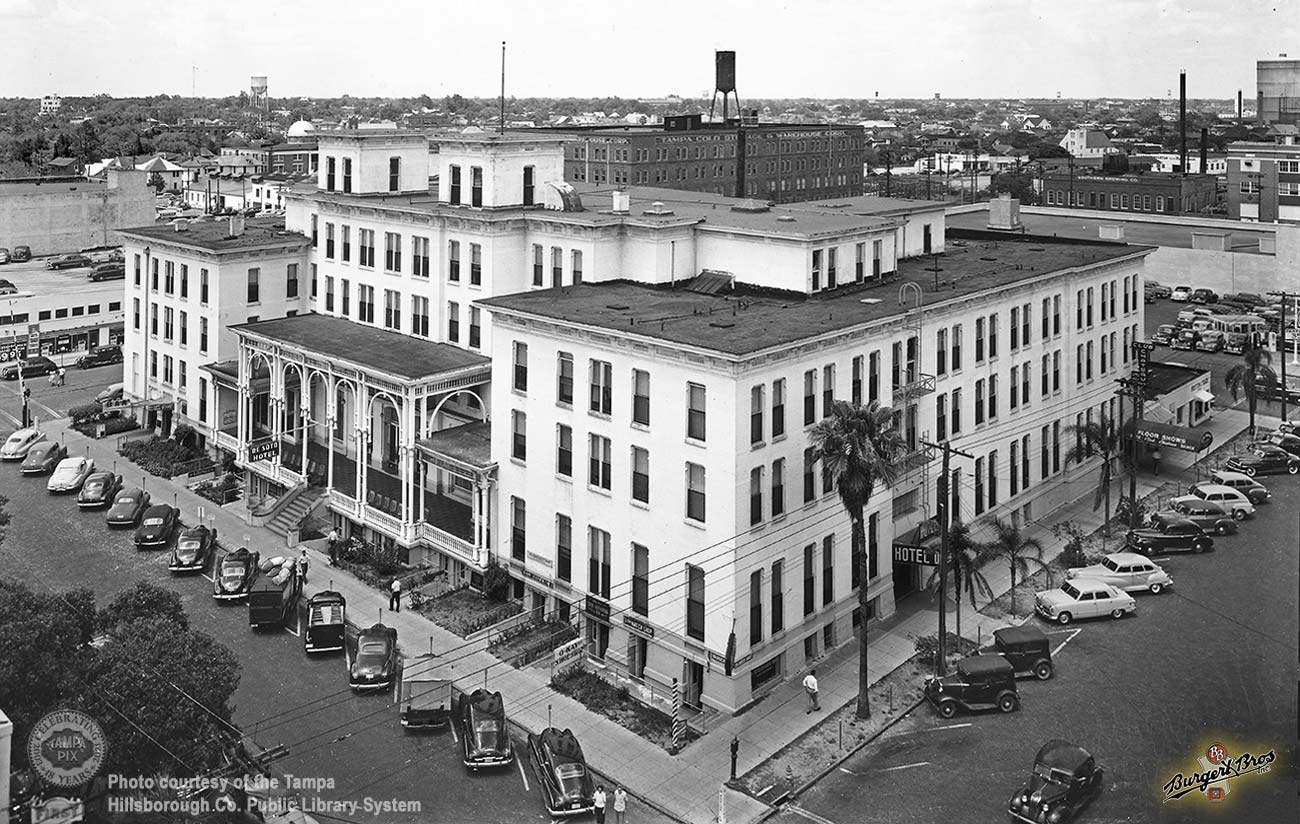 |
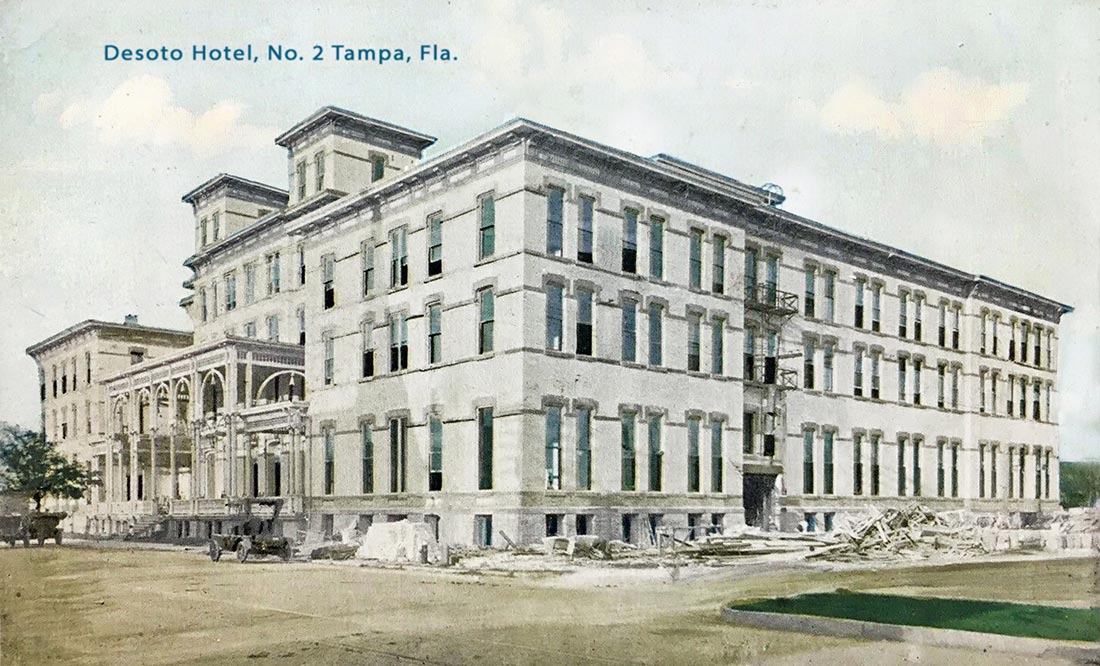 |
|
This
building was
built in phases over a
period of three years
beginning in
1907, eventually replacing a
wood frame DeSoto
hotel on the
same corner. |
THE ORIGINAL
WOOD FRAME
DESOTO BUILT
BY J. H.
THOMAS
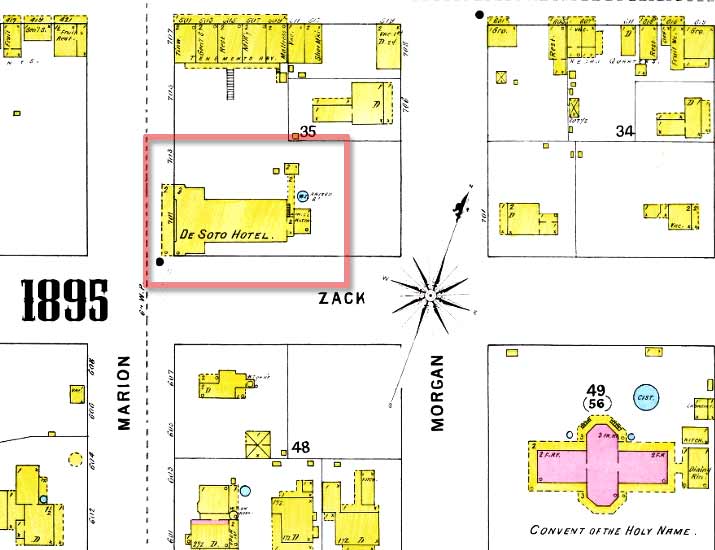
 The
first DeSoto
hotel was
built by
James Henry
Thomas, a
native of
Chillicothe,
Ohio, who
came to
Tampa by May
of 1892.
Very little
was
published
about him
and his
hotel in the
newspapers during
the planning
and
construction
period.
This article
above was the
first
mention of
Thomas and
the hotel,
at which
time it
apparently
had no name
or at least
was not made
public, but
it was known
it would be
a 60-room
hotel. The
first DeSoto
hotel was
built by
James Henry
Thomas, a
native of
Chillicothe,
Ohio, who
came to
Tampa by May
of 1892.
Very little
was
published
about him
and his
hotel in the
newspapers during
the planning
and
construction
period.
This article
above was the
first
mention of
Thomas and
the hotel,
at which
time it
apparently
had no name
or at least
was not made
public, but
it was known
it would be
a 60-room
hotel.
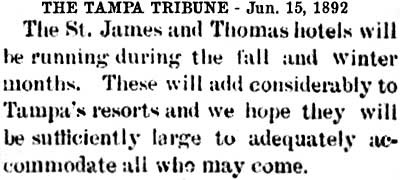
The St.
James was
under
renovation
at the same
time, and
both were
expected to
be open in
time for the
fall and
winter
season when
Tampa's
hotels
usually
filled to
capacity.
Then for two
full years
nothing
could be
found about
J. H. Thomas
or his
hotel,
including
any mention
of the
DeSoto.
In
these years
the area
north east
of the
center of
town appears to
have been
somewhat
"out there"
and
relatively
ignored by
the Tribune,
and the Sanborn
maps don't
detail this
area until
1895.
Unfortunately,
there is a
gap in the
newspapers
that runs
from the 3rd
page of Aug.
31, 1892
through
March 28,
1893 (this
was the
Weekly
Tribune,
published on
Tuesdays.)
The DeSoto
likely
opened
during this
period and so
nothing
could be
found about
it.

J. H.
THOMAS
LEASES THE
DESOTO HOTEL
TO W. D.
LEWIS
 Two
articles
published on
the same
day, May 11,
1894,
indicate the
hotel has
been open
long enough
for J. H.
Thomas to
want to lease out
the hotel
and petition
the city to
build
sidewalks
around it.
Thomas was
probably
managing it
himself and
once he had
the business
going,
wanted
someone else
take over.
The new
hotel
manager,*
W. D. Lewis,
had already
gained a
reputation
of being a
"splendid
caterer" and
the hotel
one of being
a
"magnificent
hostelry." Two
articles
published on
the same
day, May 11,
1894,
indicate the
hotel has
been open
long enough
for J. H.
Thomas to
want to lease out
the hotel
and petition
the city to
build
sidewalks
around it.
Thomas was
probably
managing it
himself and
once he had
the business
going,
wanted
someone else
take over.
The new
hotel
manager,*
W. D. Lewis,
had already
gained a
reputation
of being a
"splendid
caterer" and
the hotel
one of being
a
"magnificent
hostelry."
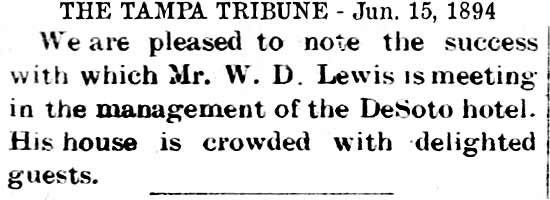
In the next
few years,
W. D. Lewis
would
achieve
great
success and
notoriety as
the manager.
His
lavishly
catered
events were
the talk of
Tampa, and it wasn't
long before
his
excellent
singing
voice caught
the
attention of
the local
papers,
guests, and
the people
of Tampa.
In the next
few years he
performed
yearly in
dozens of
local
concerts
with solo
numbers and
in a local
quartet, as
well as at
his church.
.
.
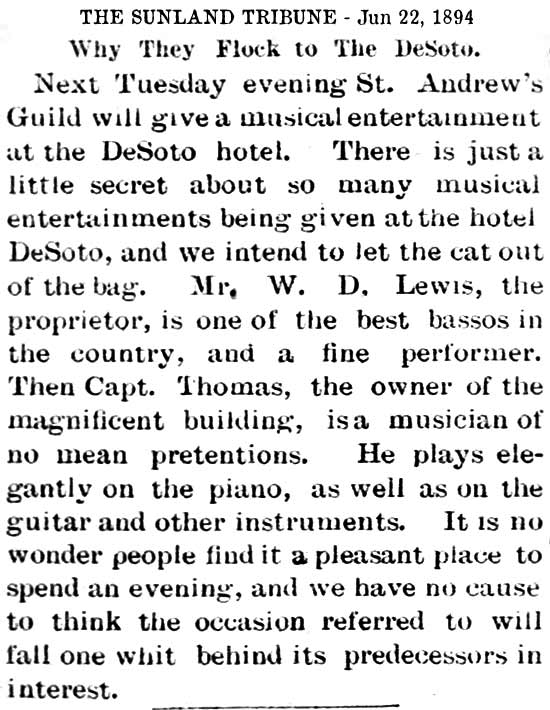
**In
these times,
the terms "manager,"
"proprietor,"
and "owner"
were used
interchangeably.
These
described
the owner of
the
business.
They may
have also
owned
the building
that the
business
operated
from, or
they may
have been
leasing
the building
from which
they
operated
their
business.
The latter
being the
situation
here with
W.D. Lewis,
who leased
the the
building
from J. H.
Thomas in
which the
DeSoto
operated.
PRAISE FOR
THE DESOTO
HOTEL
MANAGEMENT
AND TALENT
AT RIGHT:
In Jun.
1894, the
Tribune
wrote,
Why
They Flock
to the
DeSoto:
There is
a little
secret
about so
many
musical
entertainments
being
given at
the
hotel
DeSoto...Mr.
W. D.
Lewis,
the
proprietor,
is one
of the
best
bassos
in the
country,
and a
fine
performer.
Capt.
Thomas,
the
owner of
the
magnificent
building,
is a
musician
of no
mean
pretensions.
He plays
elegantly
on the
piano,
as well
as on
the
guitar
and
other
instruments.
It is no
wonder
people
find it
a
pleasant
place to
spend an
evening.

This article
claims that
the former
State of
Florida
Superintendent
of Schools
William Penn
Haisley was
Lewis'
uncle.
Before
obtaining
that status,
Haisley
traveled all
over the
U.S. and
came to
Tampa with
extremely
high
educational
credentials,
starting his
own private
school and
eventually
become the
principal of
the high
school that
would
transition
later into
Tampa's
first public
high school.
Learn more
about the
beginning's
of Tampa's
school
system and
W. P.
Haisley.
Was he
really W. D.
Lewis'
uncle?
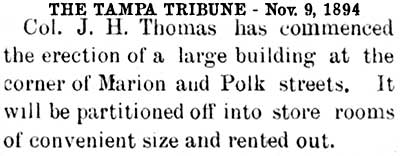
In Nov. of
1894 Thomas
had a
separate
wood frame
structure
built on the
northwest
corner of
the property
and rented
the spaces
for
business. In
1895, this
would be a
two-story
structure
containing a tinware
shop,
general
store,
restaurant,
millinery
shop (hats),
mattress
shop and
shoe maker
shop on the
ground floor
with
tenements
(apartments)
on the
second
floor.
Over the
years this
building
would be
modified for
various
uses.
For a number
of years
afterward.
the
two-story
building at
Marion &
Polk
was known as
the "DeSoto
Annex" and
the 2nd
floor contained
sample rooms
and rooms
for rent in
case the
main
building was
filled to
capacity.
In the 1903 photo below can be seen construction on the ground floor of the Federal building with the First Presbyterian church in the background, and the large 3-story wood frame DeSoto Hotel to the right of it. In between the two can be seen a small portion of the DeSoto Annex.
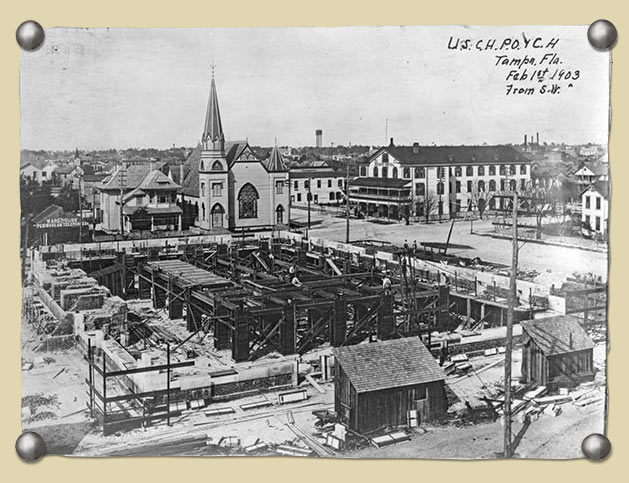 |
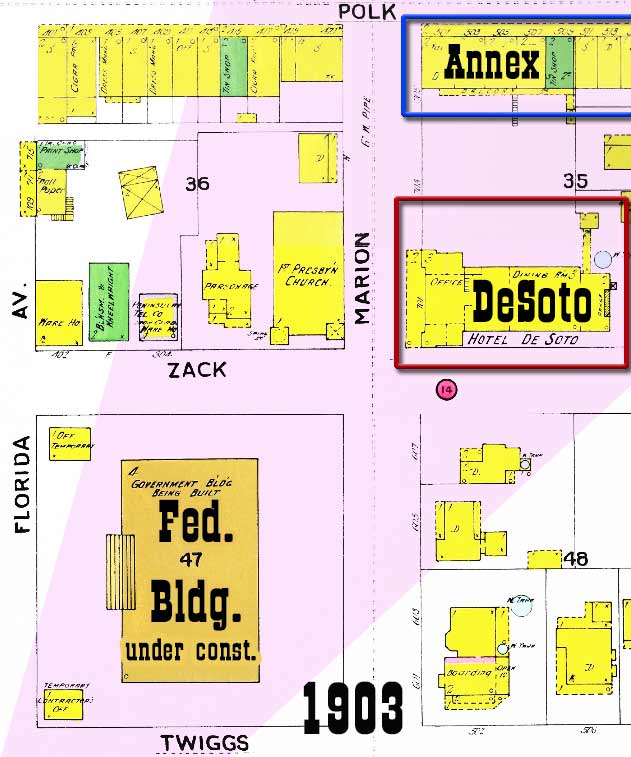 |
W. D. LEWIS
PARTNERS
WITH
CHARLES DUNN
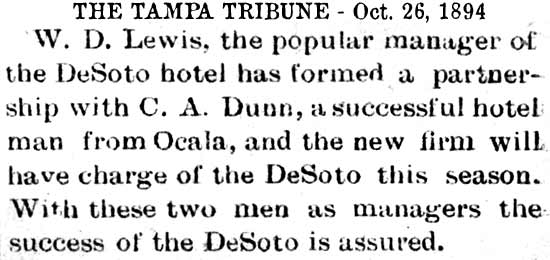
In October
of 1894,
Lewis
was joined
in
partnership
by Charles
A. Dunn of
Ocala.
There were
frequent
articles in
the local
papers about
various
events and
festivities
held there,
each getting
great
reviews for
their
handling of
the events
and
facilities.
|
|
DESOTO FULLY
BOOKED
DESPITE
BEING SUMMERTIME |
|
More
accolades
for Lewis's
management
of the
DeSoto
Hotel;
summer was
usually a
slow season
as the heat
kept
visitors in
the cooler
north, yet
the DeSoto
was booked
at full
capacity at
this time
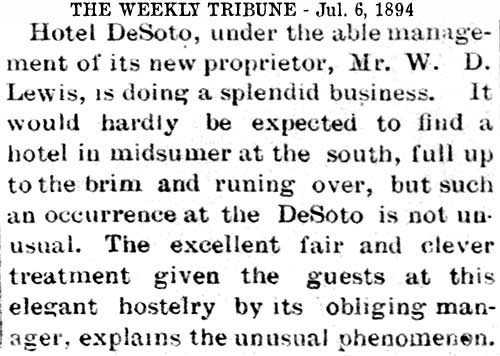 |
On Sep. 12,
1894, the
DeSoto Hotel
hosted a
grand
banquet for
fifty
members
of the Key
West Guards.
Florida
Governor
Henry L.
Mitchell
was among
the guests
at the
affair.
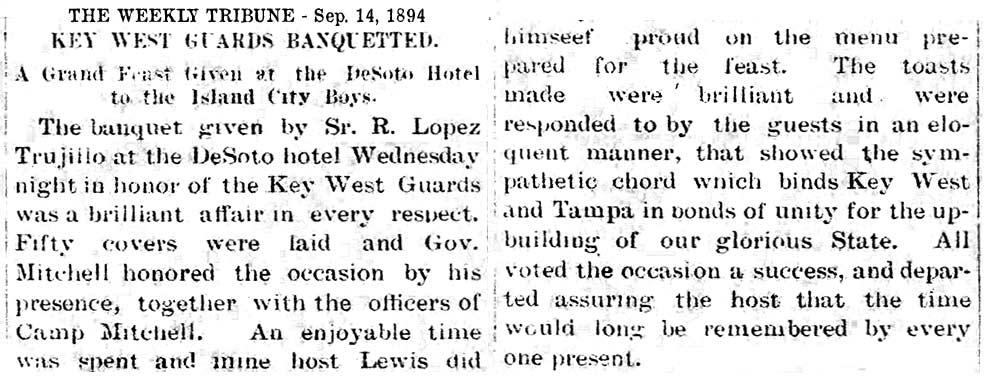
|
|
|
|
TAMPA
TROPICAL
TROUBADOURS
FORMED |
|
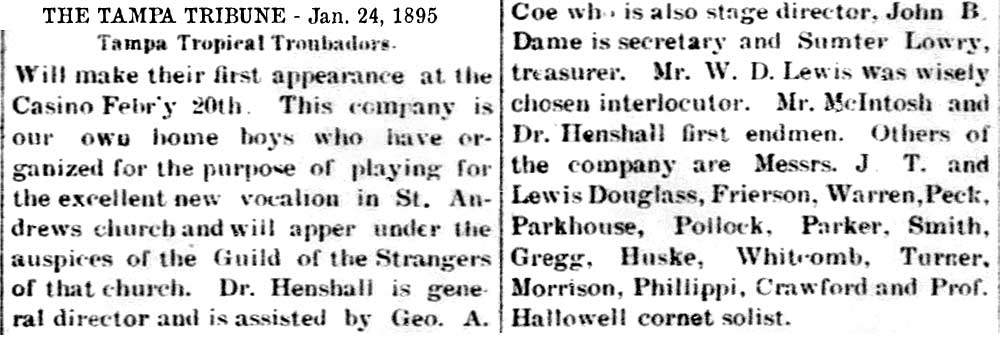 In Jan.
1895, a
musical
group
consisting
of about a
dozen men
was formed
to perform
along with a
new vocalion
obtained by
the St.
Andrews
church. (This
was a
reed-organ
which can
play sounds
similar to
the human
voice,
gradually
perfected
from
experiments
begun in
England
about 1870.)
The group
was under
the
patronage
and guidance
of the
"Guild of
the
Strangers"
of St.
Andrews. W.D.
Lewis was
chosen as
the
interlocutor.*
In addition
to a
director,
assistant,
and
secretary
being
appointed,
Sumter Lowry
was
appointed as
treasurer.
In the early
1900s, Lowry
would become
a city
commissioner
and work to
obtain a
Carnegie
grant to
build
Tampa's
first real
library.
He would
also go on
to be the
major mover
to convert
land north
of Tampa
from its
intended use
as a
cemetery to
a public
park
instead.
In the mid
1920s, the
park was
created and
named in his
honor. In Jan.
1895, a
musical
group
consisting
of about a
dozen men
was formed
to perform
along with a
new vocalion
obtained by
the St.
Andrews
church. (This
was a
reed-organ
which can
play sounds
similar to
the human
voice,
gradually
perfected
from
experiments
begun in
England
about 1870.)
The group
was under
the
patronage
and guidance
of the
"Guild of
the
Strangers"
of St.
Andrews. W.D.
Lewis was
chosen as
the
interlocutor.*
In addition
to a
director,
assistant,
and
secretary
being
appointed,
Sumter Lowry
was
appointed as
treasurer.
In the early
1900s, Lowry
would become
a city
commissioner
and work to
obtain a
Carnegie
grant to
build
Tampa's
first real
library.
He would
also go on
to be the
major mover
to convert
land north
of Tampa
from its
intended use
as a
cemetery to
a public
park
instead.
In the mid
1920s, the
park was
created and
named in his
honor.
*One who
takes part
in dialogue
or
conversation.
A man in the
middle of
the line in
a minstrel
show who
questions
the end men
and acts as
leader.
|
SNOW
IN TAMPA -
LEWIS'S
GROVE
DESTROYED |
|
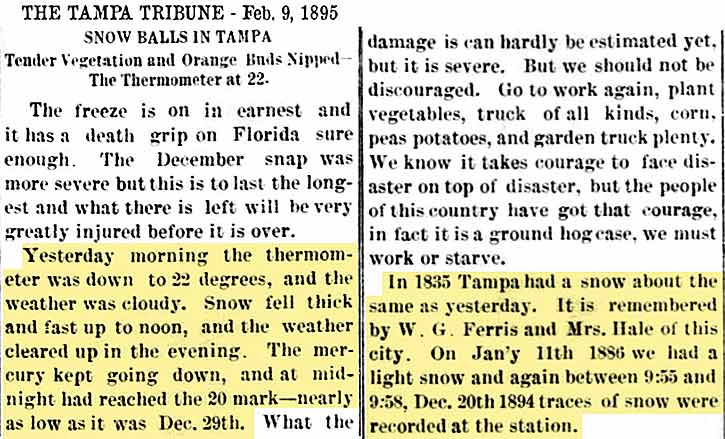 |
During this
time, Lewis had an
orange grove which upon
maturity was estimated
to be worth $45,000.
But unfortunately for
him, the entire grove
was ruined by the
phenomenal freeze of
1894-95, when the
temperature went down to
14 degrees on Dec.
29th, 1894.
|
|
|
|
The Burgert
Bros. photo below,
from the
Tampa
Hillsborough
County
Public
Library
Burgert
collection,
shows a view
taken from
the highest point of
the new
county courthouse
looking NNE.
Various
buildings in
this photo
indicate it
was taken
around 1895
and could be
the snow
fall in
Tampa of
Feb. 8,
1895. |
|
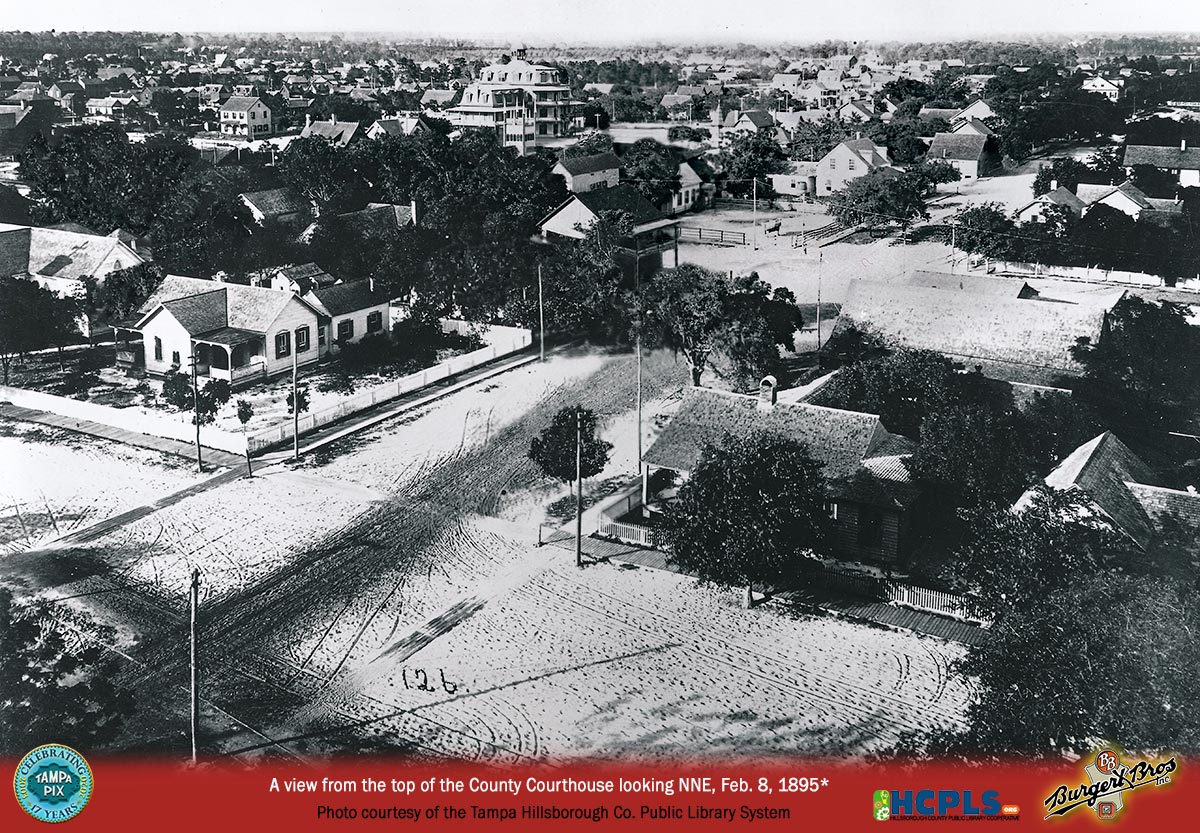 |
|
JUNE
THE STREETS ON THIS MAP HAVE BEEN
NARROWED TO ABOUT HALF THEIR ACTUAL WIDTH. TAMPA'S STREETS WERE 80
ft. WIDE.
1). St. Louis Catholic
church building (partial view.) In 1905 this became the site of the
magnificent
Sacred Heart Catholic Church.
2). The original YMCA
club house. In 1910 a new $100k brick structure was built at the
northwest corner of Florida Ave. & Zack St. It occupied one-fourth
the total area of the square block, with the gym comprising half of
the building's area.
3). St. Andrew's Episcopal Church,
built here in 1883. A new concrete-cement block structure was
built in 1907 on the vacant lot seen here just south of it at Marion
& Madison streets. |
By 1903 this church had
been moved to
the north side of Zack at Marion.
This
house was moved
and in 1903 construc-
tion began on this entire
block for the new Federal
Courthouse / Post Office. |
|
| |
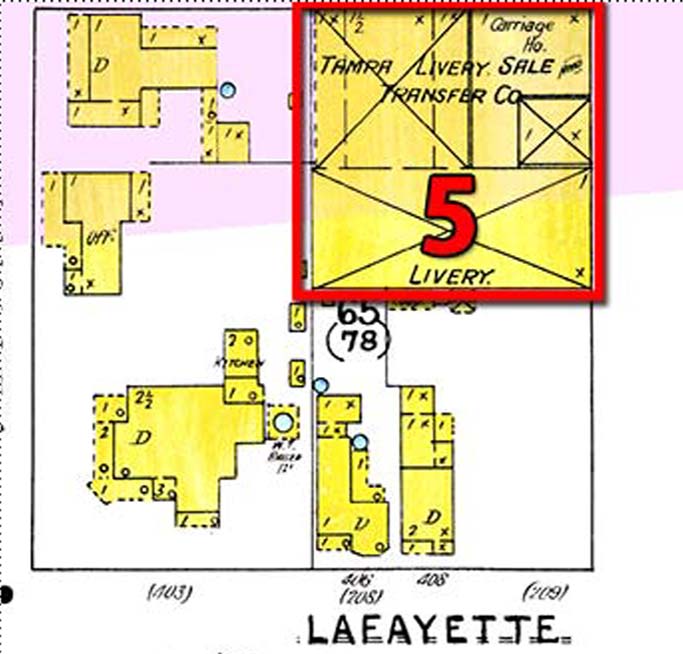 |
4). A key structure in this photo,
the Convent of the Holy Names, a three-story brick with wood frame
balconies and stairs structure completed in 1892 and occupying the whole block between
Zack & Twiggs, and Morgan & Pierce St. It's completion date
determines the earliest this photo could have been taken.
5). Tampa Livery Sale &
Transfer - stables. This June 1895 map shows the newly
expanded facility. This facility is also a key component of
the photo because it is the only rooftop in the photo covered in
white like the streets. Evidence that this is snow and not
just sand in the streets. Why only this roof? Being a
large stable, it probably did not have heating inside. Place
your cursor on this block to see it in 1892, before the expansion.
Compare the two maps to what is seen in the photo.
6). The other key structure is NOT
seen in the photo, but is obviously there--it is the new brick
Hillsborough County Courthouse, from where the photo was taken. The
highest point would have been in the minaret at the top of the dome
which was over four stories high.
|
|
THE DEATH
OF DR. JOHN
P. WALL
(The article
below has
been edited
to show only
the
beginning
and the end
as it
pertained to
W. D.
Lewis.) |
|
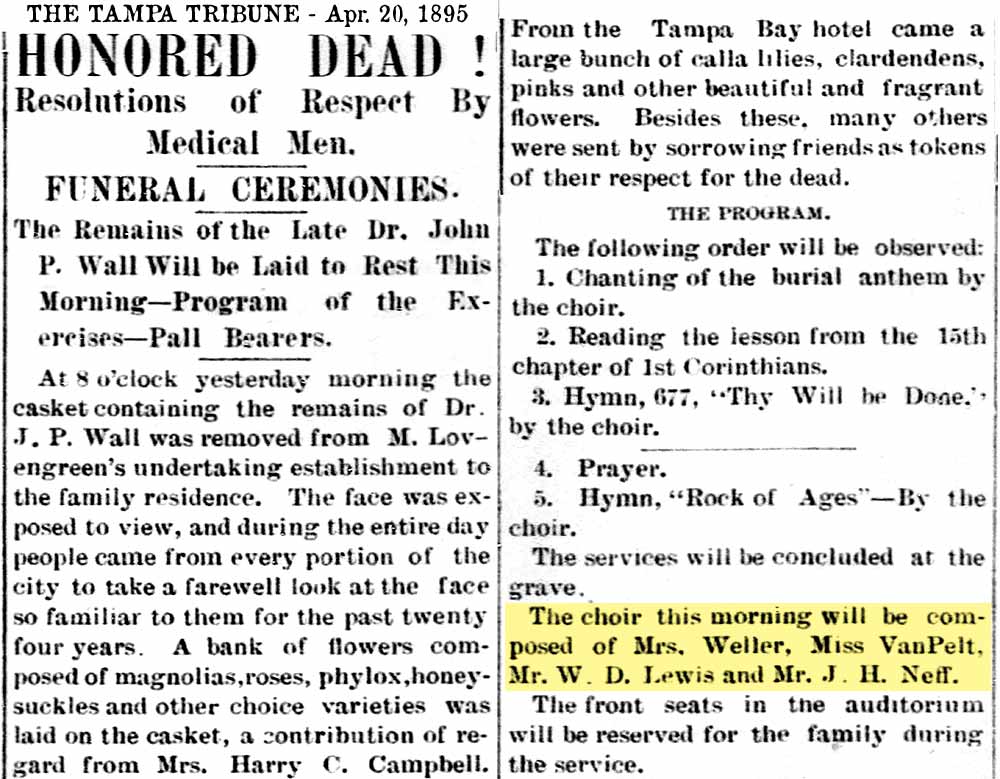
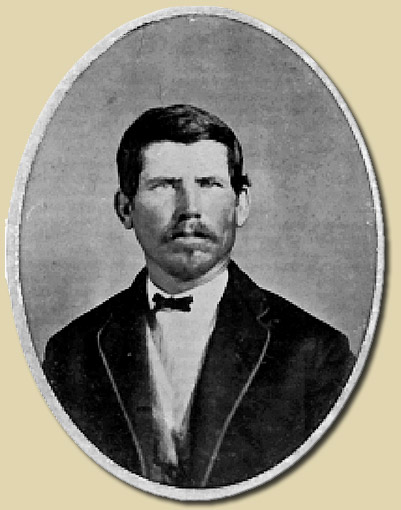 During
the
Civil
War,
John P.
Wall
volunteered
as a
surgeon
and was
assigned
to
Chimborazo
Hospital in
Richmond.
His life was
soon to
evolve into
a curious
milieu of
medicine,
law,
journalism
and
politics.
John P. Wall
became a
successful
physician,
writer and
politician.
He was
associate
editor of
the Sunland
Tribune,
which later
became the
Tampa
Tribune;
served as
mayor of
Tampa from
1878–1880,
concentrating
particularly
on
increasing
the maritime
trade of the
city,
mapping out
many of the
routes
through the
Florida
wilderness
that are
used by the
Florida
highway
system
today; and
assisting
Vicente
Martinez
Ybor in
establishing
Ybor
City. During
the
Civil
War,
John P.
Wall
volunteered
as a
surgeon
and was
assigned
to
Chimborazo
Hospital in
Richmond.
His life was
soon to
evolve into
a curious
milieu of
medicine,
law,
journalism
and
politics.
John P. Wall
became a
successful
physician,
writer and
politician.
He was
associate
editor of
the Sunland
Tribune,
which later
became the
Tampa
Tribune;
served as
mayor of
Tampa from
1878–1880,
concentrating
particularly
on
increasing
the maritime
trade of the
city,
mapping out
many of the
routes
through the
Florida
wilderness
that are
used by the
Florida
highway
system
today; and
assisting
Vicente
Martinez
Ybor in
establishing
Ybor
City.
The deaths
of his first
wife and
daughter
from Yellow
Fever
prompted
Wall to
search out
new paths
beyond
simply
guiding
patients
through the
fever’s
various
stages. He
now devoted
his life to
researching
and studying
how it could
be prevented
and
destroyed
more
effectively.
He was among
the first to
assert that
yellow fever
was carried
by the
mosquito.
For his
conclusions
on the
mosquito,
Wall
received
nothing but
ridicule
from the
medical
profession
and
especially
from the lay
press.
His second
wife was the
beautiful
young
daughter of
James McKay,
but to
receive
McKay's
permission,
he had to
successfully
defeat his
greatest
enemy--alcoholism.
Wall
also
served
as
Tampa's
health
officer
and successfully
lobbied
for the
construction
of a
hospital
to care
for the
people
stricken
with
yellow
fever.
Dr. Wall
collapsed
and died
while
giving a
speech
to his
colleagues
at the
annual
meeting
of the
Florida
Medical
Association
in
Gainesville
on April
18,
1895. He
had gone
up there
with his
life-long
friend
and
colleague
Dr.
Sheldon
Stringer.
Read the
article
published
in the
Tampa
Morning
Tribune
on April
19, 1895
about
his life
and his
death.
(When
the
image
opens,
click it
again to
see it
full
size.
It is
large.)
Read
about
the
amazing
life of
Dr. John
P. Wall
here at
TampaPix.
Also see
"They
Exalt
Humbug
at the
Expense
of
Science
and
Truth":
Dr. John
P. Wall
and the
Fight
Against
Yellow
Fever in
Late-Nineteenth
Century
Florida
by Larry
Omar
Rivers,
at USF
Scholar
Commons.
(Source
for the
above
oval
portrait.)
|
LEWIS SINGS
IN
CHARITY
CONCERT TO
HELP CUBA'S
WOUNDED
SOLDIERS-
May 24, 1895
Although the
United
States had
not yet
entered into
war with
Spain, Cuba
had been
fighting for
its
independence
for several
years.
There was a
small
contingent
of Spaniards
in Tampa who
quietly
favored
control of
the island
by their
homeland,
but not the
imprisonment
and
mistreatment
the Cubans
were being
subjected
to. Most in
Tampa
sympathized
with the
plight of
the Cubans
and the
horrible
conditions
they were
subjected to
by the
Spanish
rulers and
military
leaders.
Read more
about this
at Clara
Barton in
Tampa, here
at TampaPix.
Here in late
May, a
"Grand
Concert" was
held at the
Cuban opera
house (in
Ybor City)
for the
benefit of
wounded
Cuban
soldiers,
assisted by
"some of the
musical
talent of
Tampa."
"The DeSoto
Duo" of
W. D. Lewis
and James H.
Thomas
teamed up
for a duet,
as well as
each
performing a
solo with
their
instruments
of
expertise.
|
|
 |
|
|
|
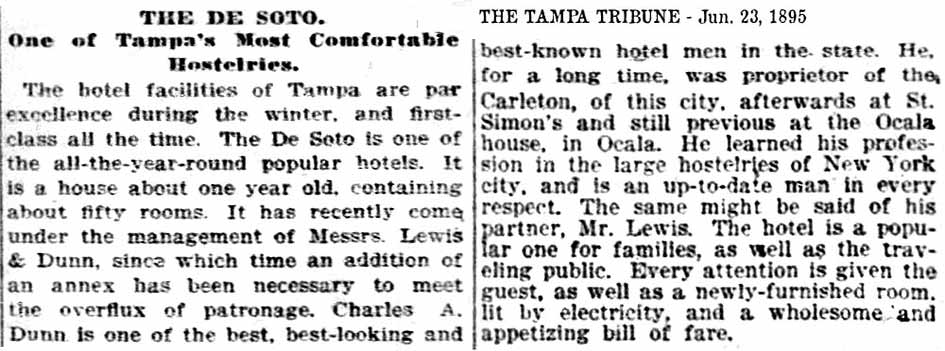
BACKGROUND
OF CHARLES
A. DUNN
Described
here as one
of the best,
best-looking
and
best-known
hotel men in
Florida.
Formerly the
owner of the
Carleton and
St. Simon's
in Tampa, he
previously
owned the
Ocala House
in Ocala.
He received
his training
at the
hotels in
New York
City and was
an
"up-to-date"
man in every
respect.
Every room
at the
DeSoto was
newly
furnished
(the hotel
was about
two years
old) and lit
by
electricity. |
|
|
CHARLES DUNN
RETIRES
In early
1896,
about six
months after
his rave
review in
the Tribune,
Charles
Dunn retired,
leaving
W. D. to
claim all
the future
profits (and
bills.)
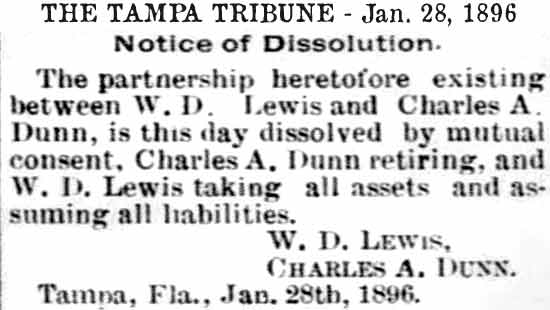
Read the
entire obit
of J. H.
Thomas
When it
opens, click
it again to
see fulll
size. |
DEATH OF
JAMES H.
THOMAS,
OWNER OF THE
DESOTO HOTEL
BUILDING
J. H.
Thomas,
builder and
owner of the
DeSoto Hotel
building,
died in his
apartments
at the hotel
on Apr. 1,
1896.
He was an
Ohio naive,
born in
Chillicothe
in 1833 and
came to
Tampa in
1892.
"He had a
deep abiding
faith in the
destiny of
Tampa that
no calamity
could
disturb,
that never
slept, and
which proved
contagious
to all who
came within
its
influence..."
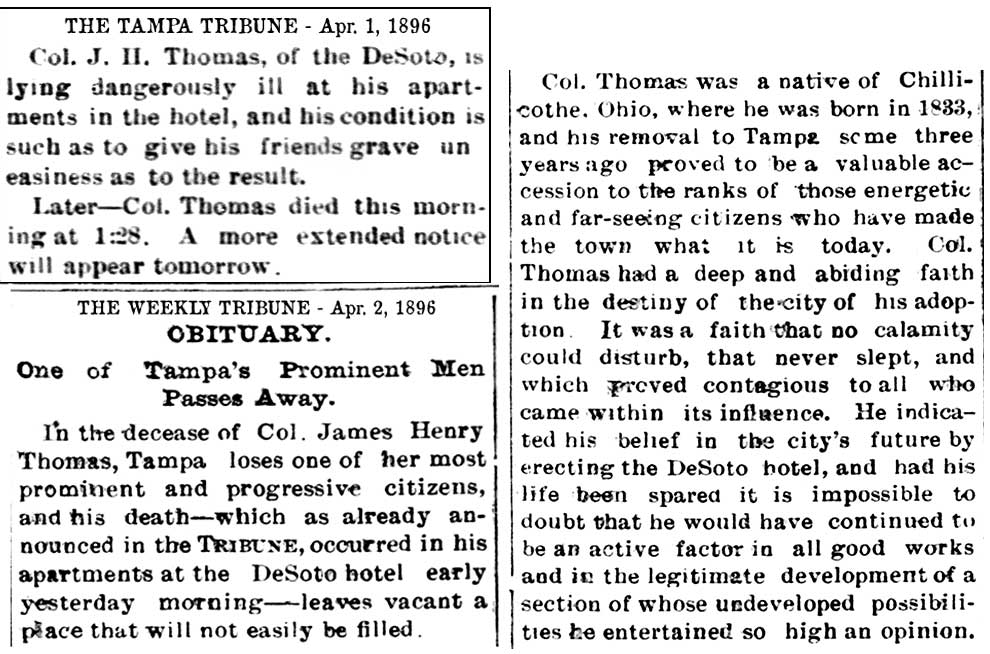
|
|
THE DESOTO HAUNTED BY SPIRIT OF J. H. THOMAS? A Tribune reporter sensationalizes the random ringing of a telephone line at the DeSoto as being the ghost of J. H. Thomas, former owner of the hotel building who died in his apartment there. The reporter claims the servants are telling a "chilly, blood-curdling" story which guests from all over have vouched for, that the bell ringing on it's own in the office is Mr. Thomas ringing for water from his room #7. |
|
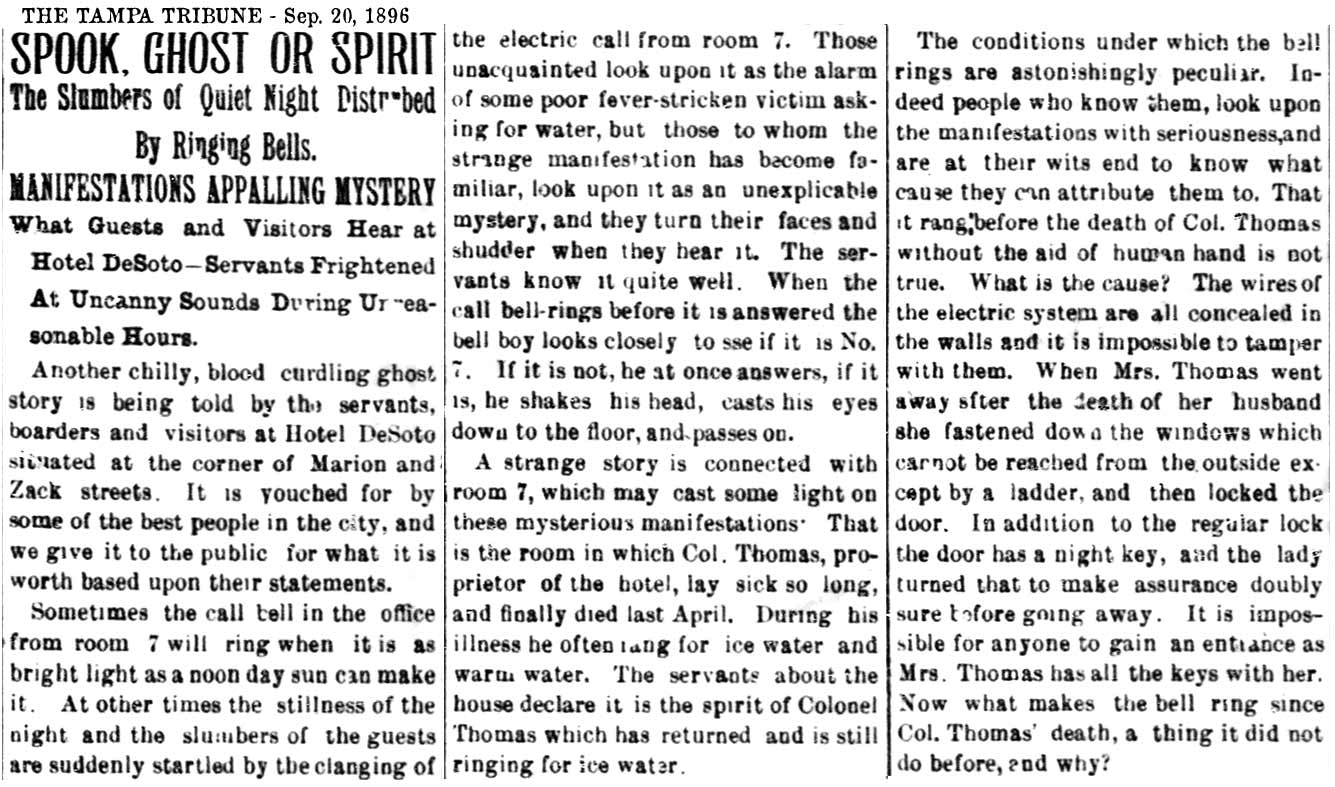
|
| |
| E. M. Greeson, a building contractor who worked on the DeSoto, dispels the the story by explaining that when the building was wired before being plastered, someone maliciously vandalized the wiring. All that had been accessible were repaired, but the bell to room #7 was still shorting out. |
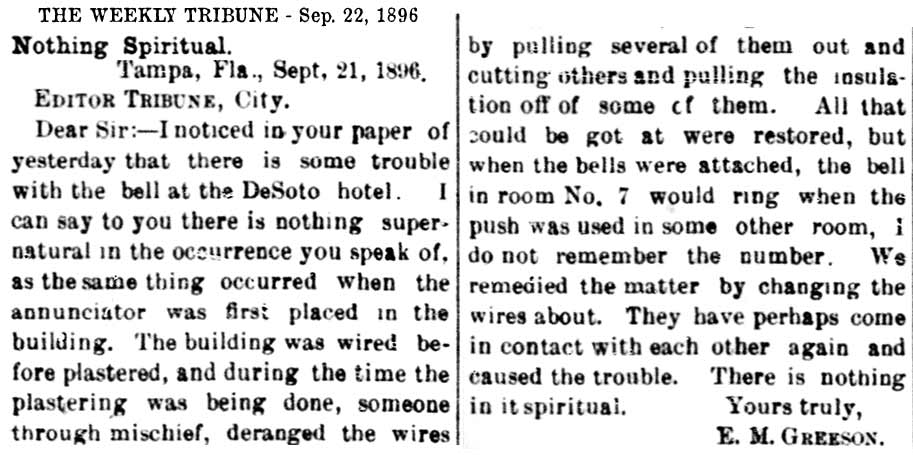
|
| |
Below: W. D. Lewis responded more aggressively, demanding his response be published. He corrected the reporter by saying Mr. Thomas occupied room #9, not room #7, and "no guest ever noticed the bell nor was even startled by it, and no servant was ever alarmed by it or 'cast his eyes down' or ever made a general or particular fool of himself by any other preposterous performance." He rebuked the reporter for publishing "rot" and not considering the damage his sensationalism would cause to the hotel's reputation, adding "such trash" would still be believed by some who hear it, as "all the idiots and fools are not dead yet."
|
|

|
| |
|
|
LEWIS LEAVES
THE DESOTO
IN JANUARY 1897,
SELLS TO THE
WILLIAMS
BROS. OF
WALDO
On Jan. 30,
1897,
W. D. Lewis
ended his
connection
with the
Hotel DeSoto
after a
supper there
that
evening,
having sold
the hotel to
the Williams
brothers,
experienced
caterers
from Waldo,
Fla..
The Tribune
says "Mr.
Lewis has
made a jolly
good host
and retires
with the
good wishes
of the
traveling
public."
The Williams
brothers
planned a
lavish feast
with a
number of
imported
dishes to
celebrate.
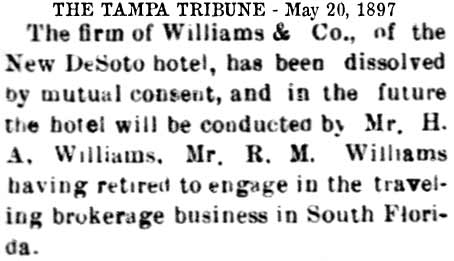
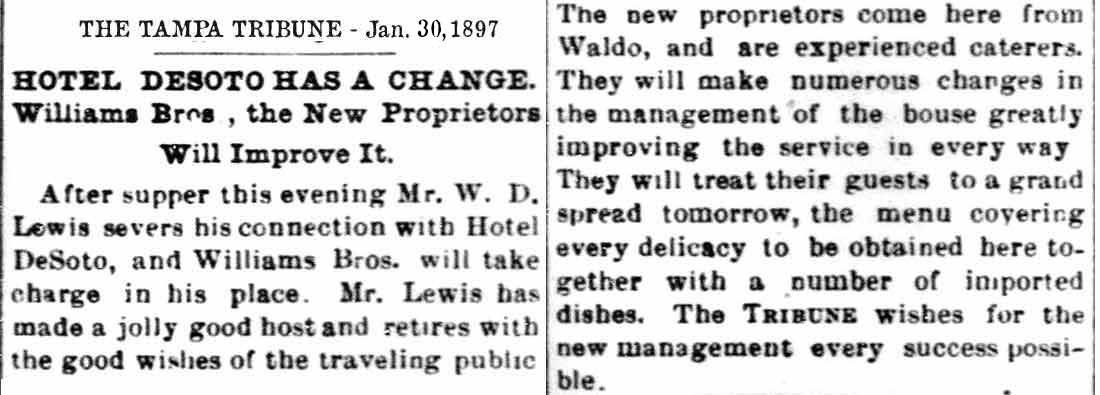 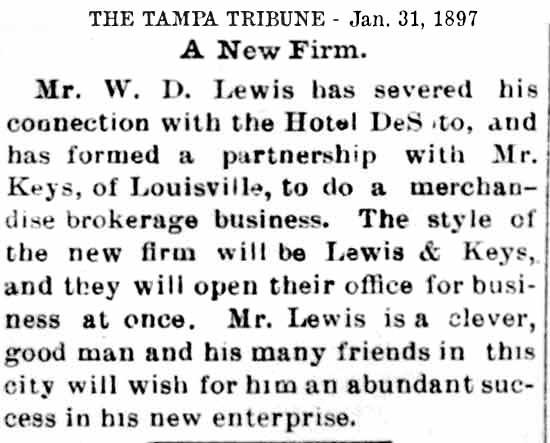
The next
day, it was
announced
that Lewis
had formed a
partnership
with a Mr.
Keyes in
Louisville
as a
merchandise
brokerage
firm in the
name of
Lewis &
Keyes,*
which would
start
business
immediately.
*Nothing of
the Lewis &
Keyes
partnership
could be
found.
Perhaps the
plan
fizzled.
Mr. Keyes
may have
been the
president of
the Keyes-Gallrein
Music Co. in
Louisville,
who
advertised
as "We are
the Largest
Music Supply
House in the
South.
Manufacturers,
Publishers
and General
Dealers."
This
Louisville
partnership
between John
W. Keyes
formerly of
Nashville
and Herman
Gallrein of
Louisville
appears to
be
short-lived;
it
advertised
only from
July to
early Sept.
of 1897 in a
Hartford KY
newspaper.
In mid-Dec.
1897, Mr.
Keyes sold
his interest
in the
company and
on Jan. 1,
1898, took
charge of
the
manufacturing
and
wholesale
business of
Wulschner
Music House.
In May, 1897
Williams &
Co. became
H. A.
Williams Co.
when R. M.
Williams
retired. |
|
| |
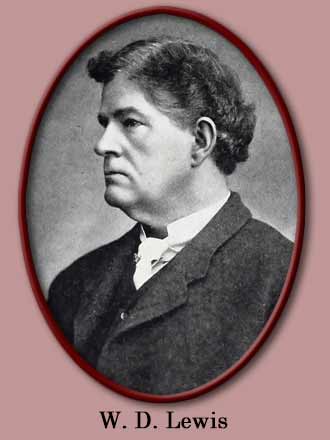 WHO WAS W .D. LEWIS? WHO WAS W .D. LEWIS?How did he obtain the reputation of being a fine caterer before managing the DeSoto? Where and how was his vocal talent refined by the time he came to Tampa? What happened to him and his wife after he left the DeSoto?
Find out more about W. D. Lewis, including what the W. D. stood for! Here at "Who Was W. D. Lewis?"
|
|
THE SPANISH
AMERICAN WAR
BRINGS
MILITARY &
BUSINESS
TO TAMPA,
ALONG WITH THE AMERICAN
RED CROSS
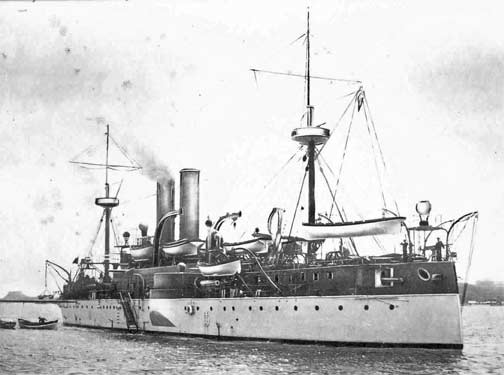 These
were the two
months
leading up
to the
Spanish-American
War.
President
McKinley had
sent the USS
Main to sit
in Havana
Harbor just
as a "show
of force" in
late January
of 1898.
American Red
Cross
founder
Clara Barton
arrived in
Cuba in
early
February and
was setting
up Red Cross
operations
and bringing
in
provisions.,
tending to
the tens of
thousands of
starving Cubans in
Spanish
concentration
camps,
On Feb.
13th, Clara
toured the
Maine and
had dinner
with Capt. Sigsbee on
the ship.
She was
working at
her desk in
Havana the
evening of
the 15th
when all
Havana was
rocked by
the
explosion on
board the
Maine. These
were the two
months
leading up
to the
Spanish-American
War.
President
McKinley had
sent the USS
Main to sit
in Havana
Harbor just
as a "show
of force" in
late January
of 1898.
American Red
Cross
founder
Clara Barton
arrived in
Cuba in
early
February and
was setting
up Red Cross
operations
and bringing
in
provisions.,
tending to
the tens of
thousands of
starving Cubans in
Spanish
concentration
camps,
On Feb.
13th, Clara
toured the
Maine and
had dinner
with Capt. Sigsbee on
the ship.
She was
working at
her desk in
Havana the
evening of
the 15th
when all
Havana was
rocked by
the
explosion on
board the
Maine.
After the
explosion on
the Maine,
Tampa's
mayor (Myron
Gillette)
and
congressman
promptly
petitioned
U.S.
Secretary of
War Russell
Alger for
protection
against the
Spanish
Navy.
Leading
citizens and
the Board of
Trade
demanded a
military
presence in
Tampa and
the funding
of coastal
defense
sites. But
from the
armchair
generals in
Washington,
there was no
response.
Then on
March 22nd,
Henry Plant
wrote
Secretary
Alger
personally,
calling
attention to
his
multi-million
dollar
investment
in Port
Tampa. Money
talked and
Plant had
it. On
March 25th,
Alger sent
his Chief of
Engineers to
begin
fortifications
on Egmont
and Mullet
Keys. With
that,
Florida,
Tampa and
H.B. Plant
were
involved in
the
still-undeclared
war. The
Olivette had
already made
one run for
Assistant
Secretary of
the Navy,
Theodore
Roosevelt,
delivering
ammunition
to Key West.
Local papers
began
boosting
Tampa as the
obvious
supply point
for
operations
in the
Caribbean.
At the end
of March, a
real-life
seagoing
admiral
checked into
the Port
Tampa Inn.
On behalf of
the Plant
System,
Henry
Plant's
second in
command,
Franklin Q.
Brown, gave
"Fighting
Bob" Evans a
tour of the
harbor. The
admiral
passed the
word to the
press corps.
In the event
of war, make
way for the
Navy!
Due to the
coming war,
the order
was given
for all
American
citizens to
leave
Havana.
Clara Barton was
forced to
abandon her
relief work
and, in her
words, she
left those
“poor, dying
wretches to
their fate.”
One
newspaper
reported,
“The whole
system of
caring for
and giving
aid to the
starving
Cubans is
for the time
being
brought to a
complete
standstill.”
On April
9th, she
packed her
bags and
headed to
Tampa, where
she set up
the American
Red Cross
headquarters.
At the
declaration
of war on
April 25th,
the American
Red Cross in
Tampa was
ready to
offer
immediate
war service,
and in spite
of war,
Barton hoped
that her
relief work
would
continue.
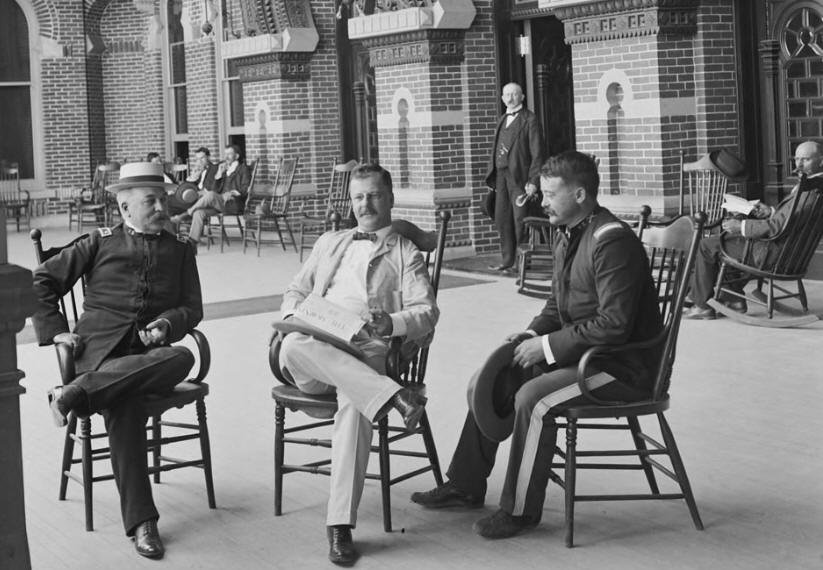 In
the
meantime,
Tampa and
Port Tampa became
a hotbed of
military
activity,
and a flood
of journalists
from all
over the
world
descended on
Tampa.
H. B.
Plant's
Tampa Bay
Hotel became
headquarters
for the top
brass of the
U.S.
military
forces during the
Spanish
American War
as Tampa was
the
debarkation
point for
troops going
to Cuba.
The troops
and their
leaders
camped out
at various
places
around
Tampa, West
Tampa and
Port Tampa,
and Ybor
City.
A young
relatively
unknown
officer
named
Theodore
Roosevelt
camped
outdoors in
the
sweltering
heat and
mosquito
infested
area of West
Tampa with
his "’Rough
Riders, but
his wife
stayed at
the "big
hotel."
Generals Joe
Wheeler,
John B.
Gordon,
Fitzhugh
Lee, Nelson
A. Miles,
James F.
Wade,
McClure, and
Ramsey were
some of the
brass who
mapped
strategy
from the
shady verandahs of
the hotel. In
the
meantime,
Tampa and
Port Tampa became
a hotbed of
military
activity,
and a flood
of journalists
from all
over the
world
descended on
Tampa.
H. B.
Plant's
Tampa Bay
Hotel became
headquarters
for the top
brass of the
U.S.
military
forces during the
Spanish
American War
as Tampa was
the
debarkation
point for
troops going
to Cuba.
The troops
and their
leaders
camped out
at various
places
around
Tampa, West
Tampa and
Port Tampa,
and Ybor
City.
A young
relatively
unknown
officer
named
Theodore
Roosevelt
camped
outdoors in
the
sweltering
heat and
mosquito
infested
area of West
Tampa with
his "’Rough
Riders, but
his wife
stayed at
the "big
hotel."
Generals Joe
Wheeler,
John B.
Gordon,
Fitzhugh
Lee, Nelson
A. Miles,
James F.
Wade,
McClure, and
Ramsey were
some of the
brass who
mapped
strategy
from the
shady verandahs of
the hotel.
Rooms were
scarce and
hotels
and boarding
houses in
Tampa
profited.
This was a
boom-time
for Tampa--a
tremendous
boost for
the local
economy,
especially
the saloons.
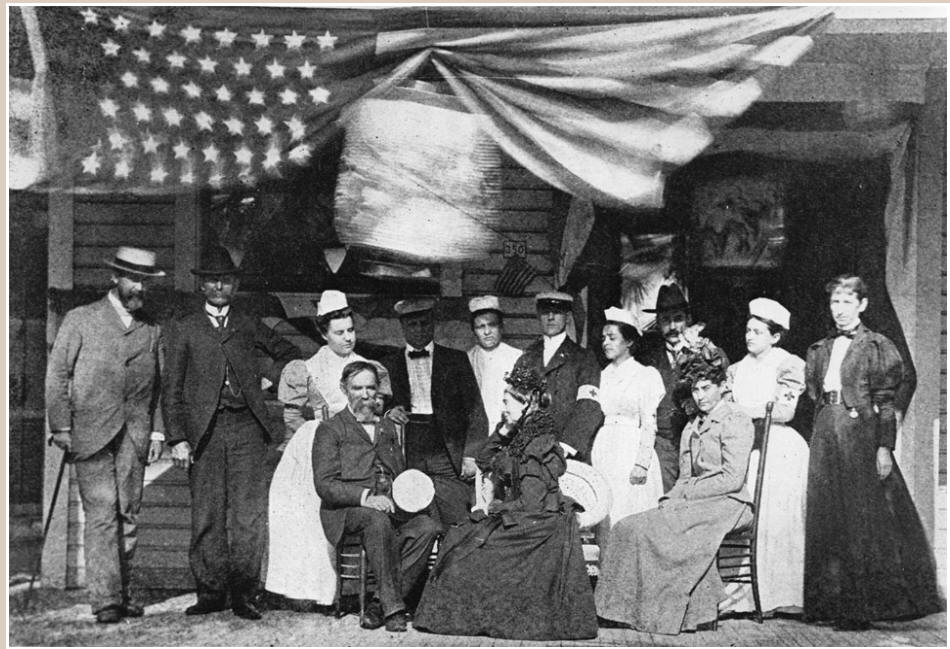
Where did
Clara Barton
stay during
the times
she was in
Tampa?
Find out
at TampaPix.
It's NOT
where most
people think
she would
have stayed.
Read more
about Clara
Barton, from
her early
childhood,
through her
Civil War
relief, her
Red Cross
efforts, and
her time in
Tampa as
well as the
war, here at
TampaPix.com:
Clara Barton
Early Life
through 1897
Clara Barton
1898 through
1912
(Captions
and credits
for all the
photos used
in this
section are
provided on
the pages
linked
above.)
|
H. A
WILLIAMS
RETIRES,
MRS. B. S.
HANKINS
TAKES CHARGE
OF THE
DESOTO
Mrs. Hankins
was formerly
the owner of
the Gold
Hotel in
Bartow, and
the
Commercial
boarding
house in
Tampa.
Nothing more
is said
about her in
the Tampa
newspapers
other than
her name,
which was
always "Mrs"
and her
husband's
initials,
and Hankins. This
article goes
on to
describe the
DeSoto and
the plan
Mrs. Hankins
had to
improve the
hotel, such
as offering
special
rates to
Tampa
people.
Special
attention
would be
given to the
cuisine,
"and the
table will
at all times
be supplied
with the
best the
market
affords."

The Desoto
opened on
Apr. 5, 1898
with Mrs.
Hankins as
the new
manager,
formerly
owner of the
Commercial
house in
Tampa.
She is
credited
with having
"a
considerable
amount of
management
of hotels in
Florida."
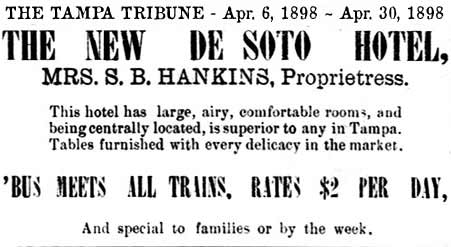
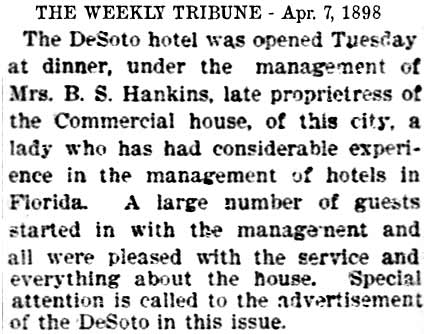
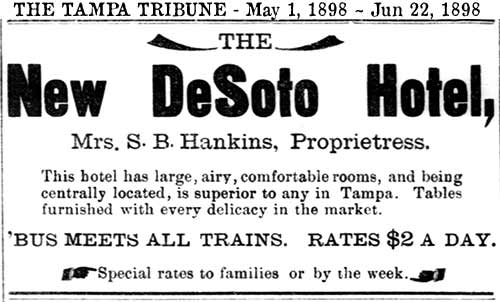
|
MRS. B. S.
HANKINS and
THE HANKINS
BROTHERS OF
BARTOW IN
TAMPA
Mrs. B. S.
Hankins was
the wife of
Bethel
Stevens
Hankins,
a.k.a.
Gilpin or
just "Gilp"
Hankins, his
nickname.
About eight
months
before she
leased the
DeSoto
Hotel, Mrs.
Hankins was
widowed in
early Aug.
1897 when
her husband and
his brother, Sylvanus
Masters
"Marter" Hankins,
were
involved in
a street
fight with
the McNeil
brothers
James C. and
Lee.
Gilp Hankins was
co-owner of
"The Missing
Link Saloon"
and at the
time of his
death, he
was co-owner
of
the "Hankins
Brothers
Saloon" with
his brother Marter.
On Aug. 4,
1897, around
10 p.m., Marter
and Gilp
Hankins
encountered
the McNeil
brothers on the
streets at
Franklin and
Harrison
where the
Hankins
Bros. saloon was
located.
An argument
over an old
gambling
debt J. C.
McNeil was
said to have owed
to Gilp
ensued,
which turned
into a
violent fight
resulting in
Gilp's death.
Their
father,
William
Wesley
Hankins, was
one of eight
children of
pioneer
farmer
Dennis
DuPont
Hankins who
owned a
large
plantation
in Madison
County.
William
Hankins was
a gunsmith
and dry
goods store
owner in
Bartow.
In town, and
in most of
the state,
he was known
as "Uncle
Billy
Hankins." He
was a
skillful
hunter and is credited
with firing
the last
shot of 2nd
Seminole War
at age 16.
During the
Civil war,
he was a
Confederate
sharpshooter
in the 5th
FL Infantry,
Company D,
and was
captured
Apr. 6, 1865
at Highbridge.
Later he was
released on
oath from
Point
Lookout
Prison MD. William was a
member of
state House
of
Representatives
from Madison
and
Lafayette
counties in
1873, and a
member of
state senate
in 1883 and
1885 from
Taylor and
Lafayette
counties.
In all, W.
W. Hankins
and wife
Almira
Church had
at least
twelve
children,
but three
died in
childhood.
William
Wesley
Hankins
(standing,
2nd from
right) and
his
children,
ca.
1890-1897.
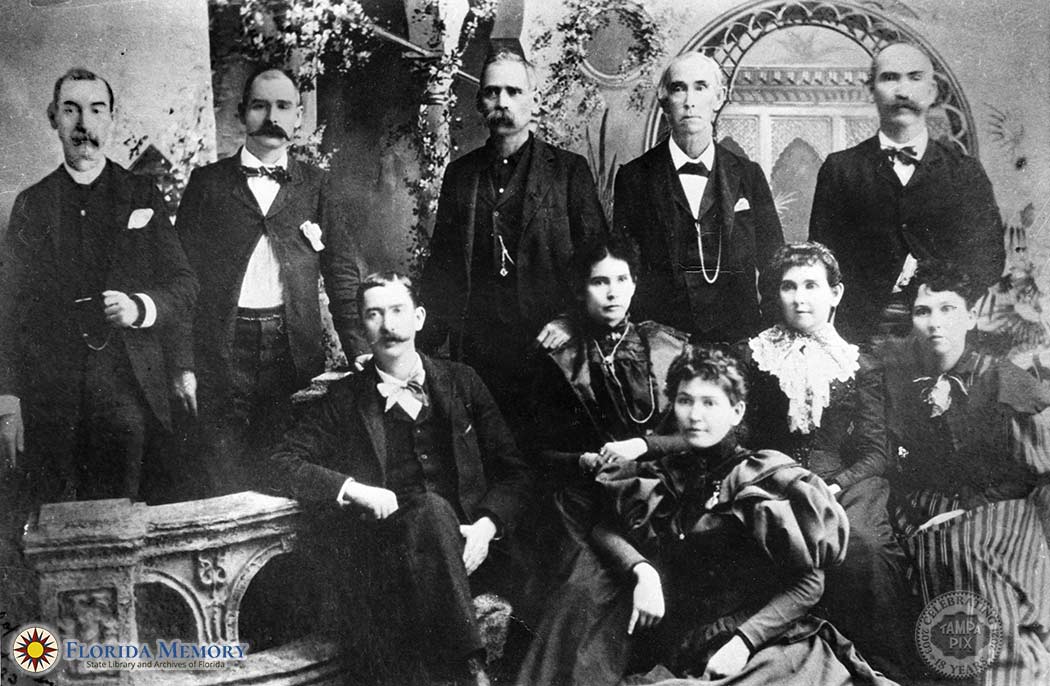
Photo
courtesy of
Florida
Memory,
State
Library &
Archives of
Florida.
The Hankins
family lived
in Bartow,
Fla.
William W.
Hankin's
wife, Almira
Jane
(Church)
Hankins, is not
in the
photo.
She died in
1890 so
this photo
was taken
sometime
after her
death of
Mar. 1890
but before Gilp
Hankin's
death in
Aug. 1897.
BLOODY BRAWL
BETWEEN
TWO PAIRS OF
BROTHERS ON
STREETS OF
TAMPA -
HANKINS vs.
McNEILL
In a letter
to the Gulf
Coast Breeze
(Crawfordville,
Fla.)
newspaper
from an
unnamed
writer,
published
Aug 19, 1897
about
the Aug. 4th
street fight
between the
Hankins
brothers and
the McNeil
brothers,
this was
said of the
Hankins and
McNeil
families:
The Hankins brothers were originally from Middle Florida. Their father, Hon. William Hankins, was a noble true and good man. He represented at different times, the counties of Madison, Lafayette, and Suwannee in the Legislature and while under his control, Marter and Gilp Hankins were extra good boys. Their older brother, Hon. W. D. Hankins, of Lafayette County, followed in the footsteps of their honored father, but Marter and Gilp engaged in the liquor saloon business, and followed the course of the average man in that business. For the past ten years or more, they have enjoyed the reputation of being violent and dangerous men.
|
The McNeil brothers are originally from Sumter County, Georgia. James C. McNeil is an architect, and is sole proprietor of the Tampa Planing Mills and Novelty Works. For several years he identified with the city government of Tampa as President of the City Council and Mayor pro tem. Lee McNeil assisted his brother at his mills, until disabled by the loss of a hand in the machinery. Since then he has been in the employ of the city as manager of the city cemetery (Oaklawn.) |
Tampa City Council Members |
|
Tampa City Council Members |
March 4, 1892 – March 10, 1893
James C. McNeil, President
George T. Chamberlain, President pro tempore
Louis G. Cone
Isaac S. Craft
Henry L. Crane
Jose Gomez
William H. Kendrick
Peter O. Knight
James W. Roberts |
March 10, 1893 – March 9, 1894
James C. McNeil, President
George S. Petty, President pro tempore
George T. Chamberlain
Henry L. Crane
Robert W. Easley
William H. Kendrick
Peter O. Knight
John S. McFall
Emilio Pons
Ramon Rubiera de Armas
John Savarese |
| |
|
|
|
READ ABOUT THE CONFRONTATION ON THE STREETS OF TAMPA AND THE RESULTING TRIAL OF THE MCNEIL BROTHERS
|
The DeSoto
Hotel in
1898
Photo
courtesy of
the State
Archives of
Florida.
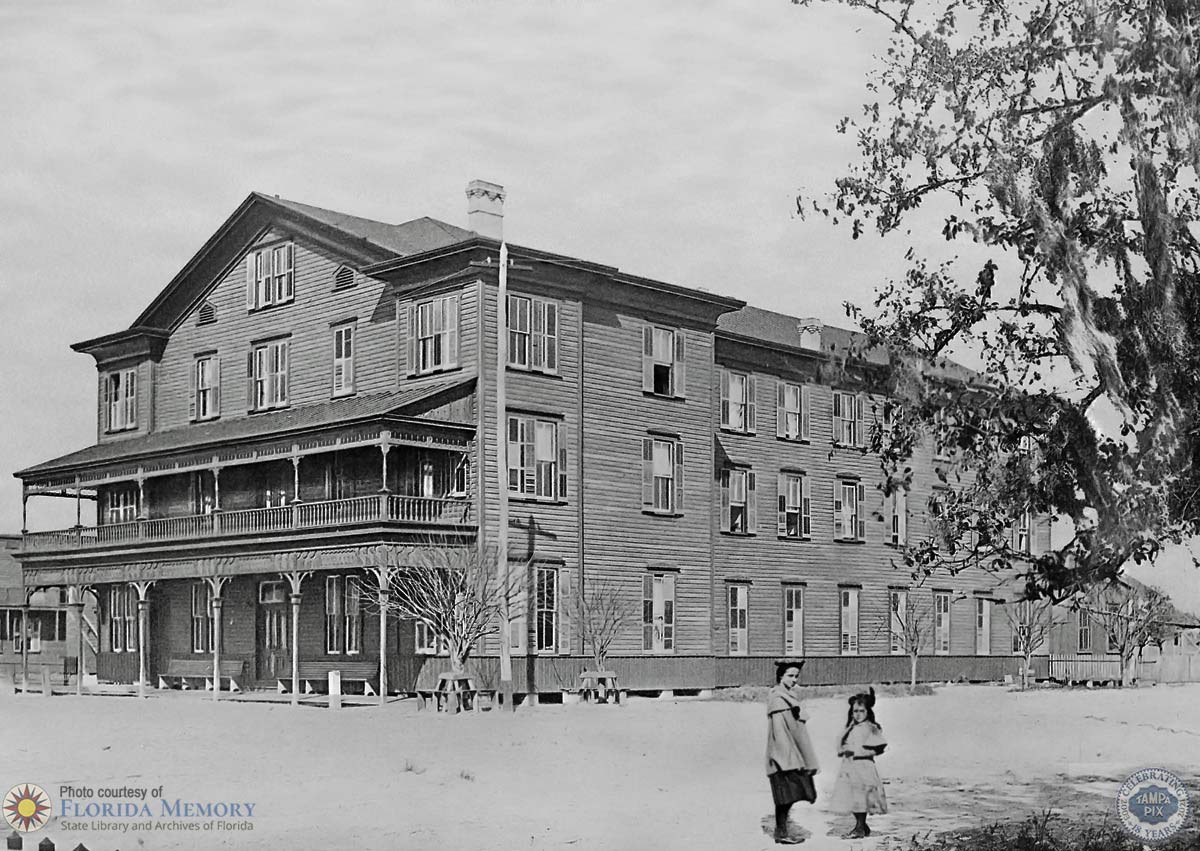
NEW
OWNERS
COME AND
GO
|
MRS. HANKINS IS OUT, W. L. LAMAR IS IN
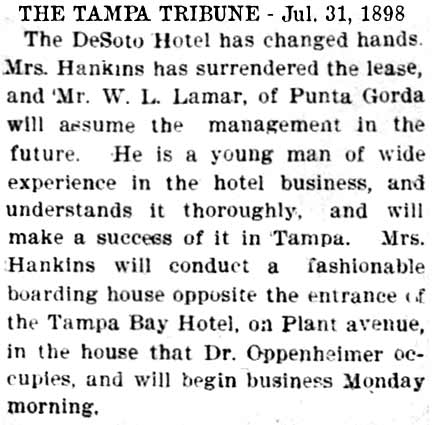
No other mentions of Lamar.
Brown & Corning
immediately
undertook to renovate
the hotel by
flooring the
lobby with
tile
installed by
Tampa Tile &
Paving Co.,
tearing away
the old
kitchen and
adjoining
outhouse and
building a
new and
"more
commodious
one."
The entire
culinary
department
was to be
completely
overhauled,
including
repainting
the dining
room.
All
seventy-one guest
rooms were
to be
thoroughly
overhauled
and
renovated,
including
new screens
and beds.
Four new
porcelain
bath tubs
and entirely
new closets*
were also
being added.
Also, the
sample rooms
were to be
newly
wallpapered
and
carpeted.
It appears
that a Mrs.
Capt. Rogers
owned the
building,
with the new
leasers
being
described as
"proprietors"
(owners of
the
business.)

|
LAMAR GIVES UP TO BROWN & CORNING WHO START REPAIRS W. L. Lamar is described as "a young man of wide experience in the hotel business, and understands it thoroughly." Mrs. Hankins planned to open a "fashionable boarding house opposite the entrance of the Tampa Bay Hotel on Plant Avenue" in a house occupied by the well-known Tampa doctor Oppenheimer. Mr. Lamar's career at the DeSoto
was
short-lived.
In Sept.
1898, the
DeSoto was
leased for a
number of
years by Amos A.
Brown and
W. E. Corning, men
with long
experience
in the hotel
business.
 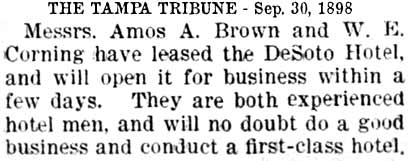 |
|
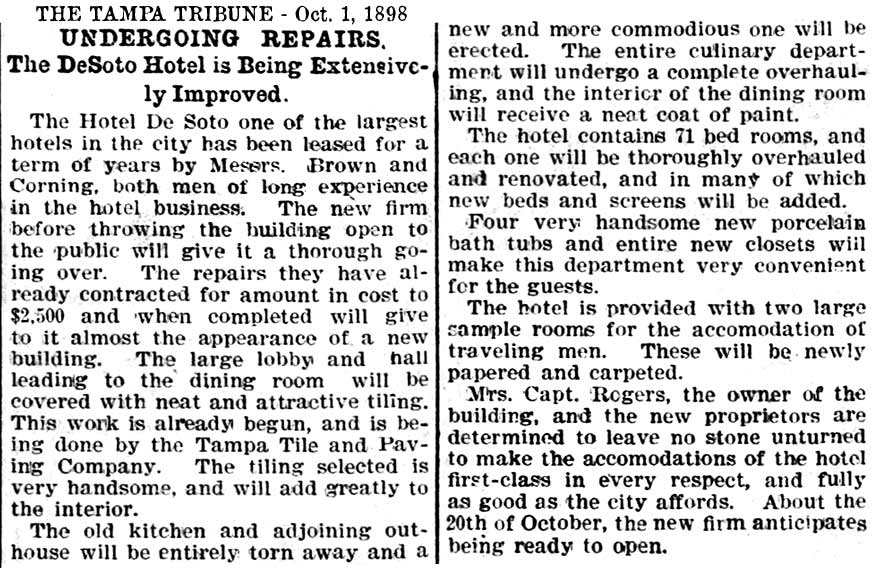 |
|
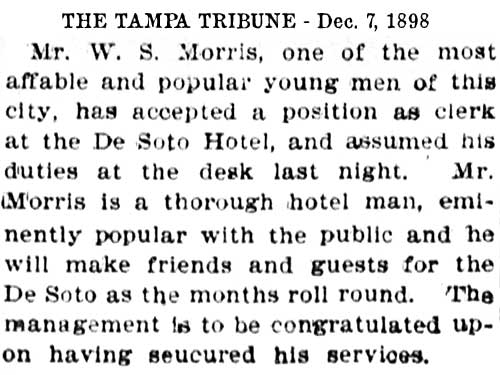
*The
DeSoto, as
well as many
other hotels
of this
period,
didn't have
a bathroom
in the guest
rooms.
Bathrooms
were usually
one large
room with
multiple
tubs.
"Closets"
was probably
"water
closets"--
toilets in a
small
private
space in a
room to be
shared by
all guests.
If they were
outside they
were called
"outhouses."
THE SECOND
AND MOST
MAGNIFICENT
DESOTO HOTEL
DESOTO SOLD
TO ROBERT F.
WEBB &
SON-IN-LAW
WALTER L.
PARKER
Webb &
Parker were
currently
the owner
and manager
of the
Palmetto
Hotel, but soon as
Webb closed
the sale of
the Palmetto
to Hazen,
Webb
bought the
DeSoto from
Brown &
Corning.
It is R. F.
Webb and W.
L. Parker
who would
remodel and
refurbish
the old wood
frame
DeSoto,
"...elegantly
furnished,
including
bathrooms
with
porcelain
tubs, and
electric and
gas
lights..."
and
reestablish
its
popularity
by 1902.
|
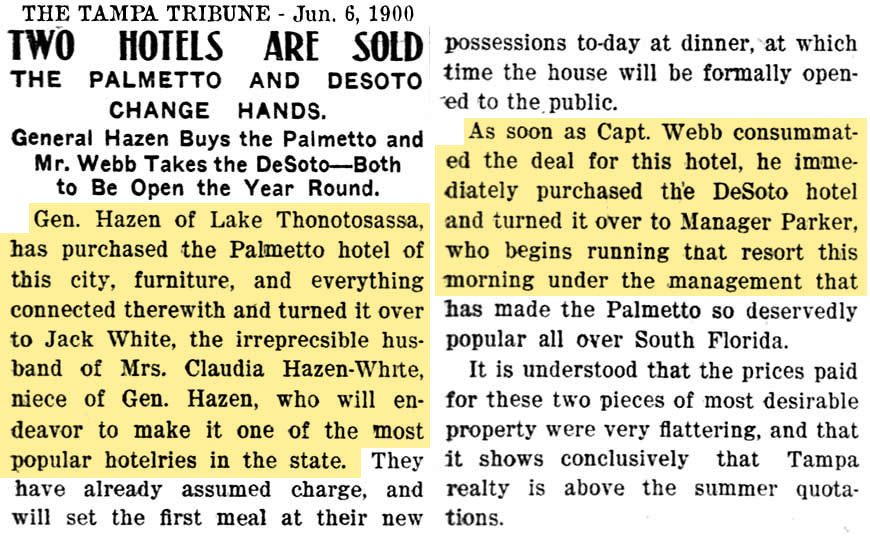 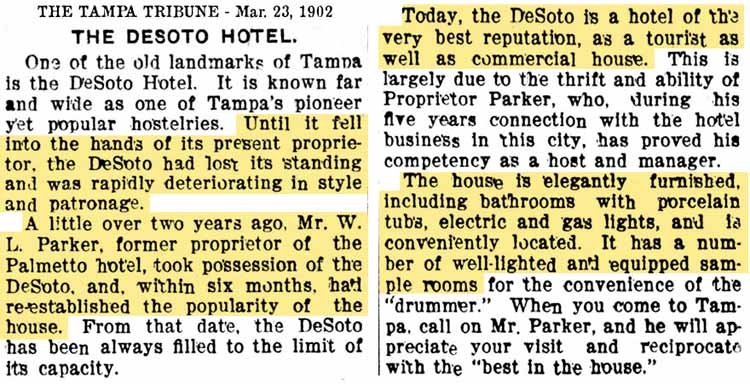
WALTER LAYTON PARKER
Information mostly from his Tampa Tribune obituary of Nov. 13, 1918, and some info and photo from
"The City Council of Tampa & Celebration of Old City Hall's CentennialBorn in Liberty County, Georgia on Mar. 26, 1868, W. L. Parker spent most of his life in Florida. He lived in Wellborn, Fla. until he was 16, then went to Orlando to work in the railroad offices. Later he came to Tampa and took a position as telegraph operator for the Plant System, which became the A.C.L. Railroad. In 1900 he became manager of the Palmetto Hotel when his father-in-law, former council member Robert F. Webb, retired from the hotel business. Soon afterward, when the Palmetto was sold and the DeSoto purchased, Parker became a stockholder and was given the position of manager, one he would retain until his death. Under his ownership, the old wood frame hotel was completely replaced by a new gleaming brick and stone structure, a process which spanned from 1907 to 1911, and eventually occupying almost the entire square block. Parker was a member of Tampa’s first Library Board and was instrumental in establishing a public library in Tampa. He was elected to Tampa City Council to represent the First Ward, downtown Tampa. Parker served on the Ordinances and Rules Committee, the Schools and Public Buildings Committee, and the Wharves, Bridges and Harbors Committee. He was also a Hillsborough County Commissioner. |
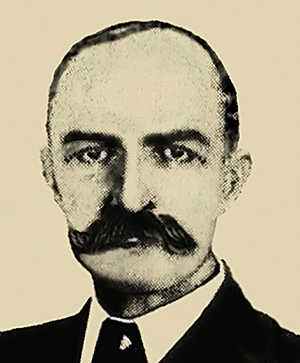
Walter L. Parker
Tampa City Councilman from
June 5, 1904 – June 7, 1906 and
Hillsborough Co. Commissioner
|
|
Mr. Parker was a member of many clubs and fraternal organizations, including the Rotary Club, the Masons and Elks. He held numerous important positions in his Tampa business career. including chairman of the board of county commissioners, member of the city council and library board, director of the South Florida Fair Association, and steward in the Methodist church. In March, 1891, Mr. Parker married Miss Texana "Annie" Webb, daughter of Mr. & Mrs. Robert F. Webb. The last two years of his life he spent mostly away from Tampa, seeking cure for his illness by traveling in search of better health, including to Denver, CO, and Asheville, NC. He died a in a hospital at Columbia, Ala., on Nov. 12, 1918, where he had been for just a few weeks. Mrs. Parker and Walter's brother, Nat Parker, were with him at the time. He was survived by his wife Annie Webb Parker, one daughter Mrs. Eugene Knight, and a son, Francis Webb Parker, one sister Mrs. J. Futch of Alachua, and four brothers: Nat of Tampa, Harry of St. Pete, T.C. of Baltimore, and C.C. of Lake City. Also a granddaughter Nancy Knight. Mrs. Parker was a sister of Goodlett Webb of Tampa Electric Co, Elmore Webb, V. R. Webb, and Mrs. M. W. Pollica of the DeSoto Hotel.
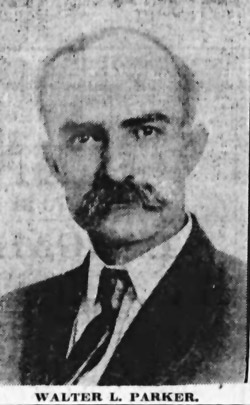 TAMPA CITY COUNCIL MEMBERS June 5, 1904 – June 7, 1906 TAMPA CITY COUNCIL MEMBERS June 5, 1904 – June 7, 1906
Curran Elmore Webb, President
W.D. Wiggins, President pro tempore
James Robert Dekle,
Michael C. Foley,
Thomas C. Folsom,
Henry Clay Giddens,
John Thomas Gunn,
John Percy Hardee,
Ernest W. Monrose,
Walter L. Parker,
Joel B. Phillips
"The City Council of Tampa," etc, adds about Walter Parker: When the streets around it [the DeSoto hotel] were laid out, Parker Street was named after him."
Parker St. is nowhere near where the DeSoto Hotel was located. The streets in the area of the hotel, and all the others downtown, were named and laid out in 1848 by surveyor John Jackson. Parker Street is in Hyde Park just on the west side of the river at present Kennedy Blvd.
Photo from July 28, 1915 Tampa Tribune article. |
|
|
THE DESOTO'S
COMPLETE
OVERHAUL
This rare
photo below
shows the
original
wood frame
DeSoto Hotel
in 1903,
remodeled
and
refurbished
by Webb &
Parker.
This was
about six
years before
it was
completely
replaced by
a new brick
& block
four-story
structure.
It is the
upper right
portion of
the
previously
displayed photo
showing the
Federal
Courthouse
construction.
At the far
left of the
photo can be
seen the
improved two-story
annex to the
DeSoto,
which ran
along Polk
St. between
Marion &
Morgan.
The water
tank at
upper left
is at
Tampa's
first
waterworks
pumping
station
located at
the corner
of Estelle &
Jefferson
St.
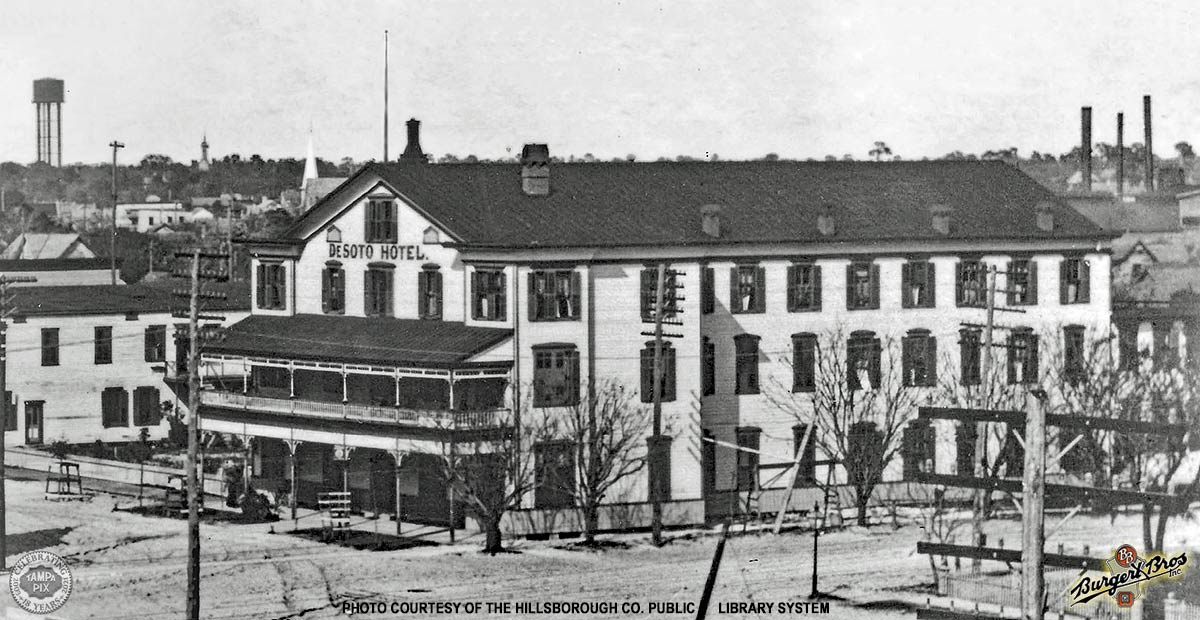
The original
wood frame
DeSoto
Hotel, Feb.
1, 1903.
The
two-story
DeSoto annex
can be seen
at far left.
BURGERT
BROS. HIGH-RES SCAN WAS
PROVIDED BY
THE
TAMPA-HILLSBOROUGH
CO. PUBLIC
LIBRARY
SYSTEM
|
TAMPA FIRE
DEPT LT. WILLIAM
C. ECKLES
FATALLY
INJURED EN
ROUTE TO
DESOTO FIRE
In the
pre-dawn
hours of
Jan. 27,
1906, a fire
was
discovered
at the
DeSoto,
having
started in
the ceiling
between the
first and
second
stories.
Stations 1
(from City
Hall) and 5
(from Palm
Ave & Fla.
Ave.)
responded
and quickly
extinguished
the fire.
All the
guests were
safely
evacuated
and damage
was about
$200.
But a
fireman was
fatally
injured en
route to the
fire. |
|
Lt. Eckles
was filling
in for the
regular
driver who
had the day
off. While
coming down
Fla. Ave.
from Station
5, his wagon
hit a hole
in the
street at
7th Ave. and
was thrown
"with great
force to the
pavement,
receiving a
number of
internal
injuries and
having his
right leg
passed over
by the heavy
vehicle."
The engineer
driving the
rear of the
vehicle did
not know
that Eckles
was thrown
off, as the
horses
continued
down Florida
Ave. for
several
blocks to
Hillsborough
St. (now
named Royal
St.) where
the horses
turned west and
then at
Franklin St.
proceeded to
go north
back toward
Tampa
Heights.
It was at
this time
that the
rear driver
called to Eckles that
he was going
the wrong
direction
and upon
getting no
response,
climbed up
over the
rear, saw
there was no
driver, and
took charge
turning the
horses back
toward the
DeSoto.
Meanwhile, a
man residing
where Eckles
was thrown,
discovered
the injured
fireman, and
took him
into his
home for
medical
attention.
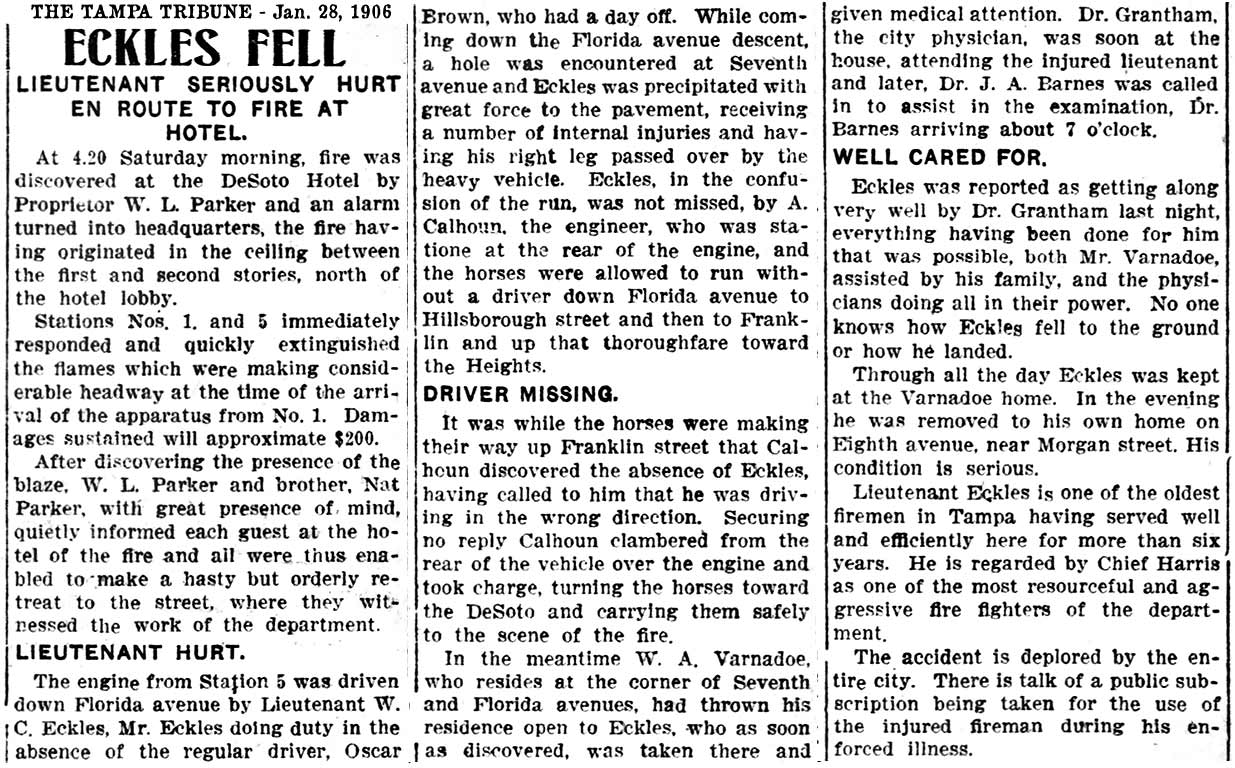 |
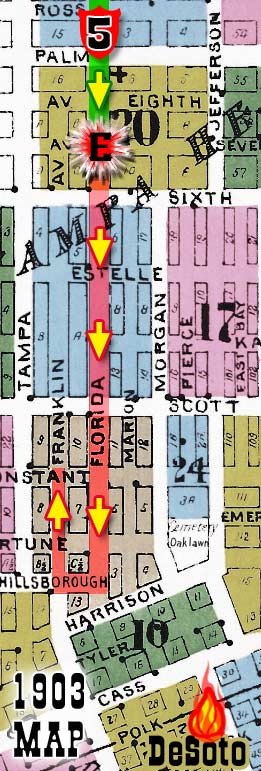 |
|
Lt. Eckles was described above as "one of the oldest firemen in Tampa having served well and efficiently here for more than six years." He was regarded by Chief A. J. Harris as one of the most resourceful and aggressive fire fighters of the department. The entire city was upset about the accident and were taking up donations to help Eckles. On Jan. 31, it was reported that Lt. Eckles had not improved and that his mother had arrived from Winter Haven and was with him. The next day, it was reported that Lt. Eckles had died at 1 a.m. Previously, his leg had become infected and had to be amputated after being placed under an anesthetic which lasted two hours.
On Friday, Feb. 2 it was announced that the funeral would be Saturday at his home at 9:30 a.m. A large detail of firemen and every police officer available was expected to attend, as well as other city officials. Eckles was survived by his wife and two sons, a two-year-old and a three-month-old, his parents, four brothers and a sister.
William Cooksey Eckles, "one of the oldest firemen in the department" was 30 years old. The Tribune urged that the whole city mourn with the closing of city offices and the attendance of public officials at the funeral It also suggested a collection be made for the benefit of Eckles's widow. |
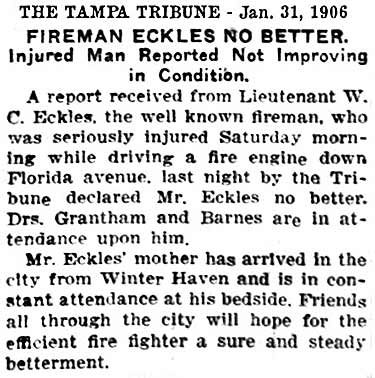 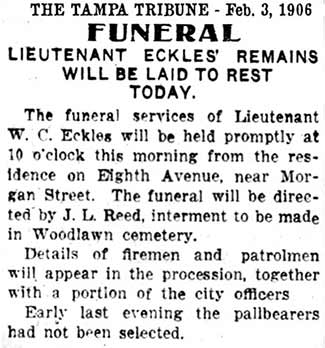
Eckles's funeral was conducted by Rev. B. K. Thrower who paid the fireman a beautiful tribute at the home and graveside services. In the procession to the cemetery could be seen Mayor Solomonson, City Auditor Hansborough, Chief and Mrs. A.J. Harris, Chief of the West Tampa Fire Dept. A. J. White, a squad of 15 firemen under command of Capt. J. D. Ross of Sta. 3, twelve patrolmen commanded by Capt. W. A. Johnson, members of the City Council including Pres. Elmore Webb, and many long-time friends of Lt. Eckles. He was buried at Woodlawn cemetery.
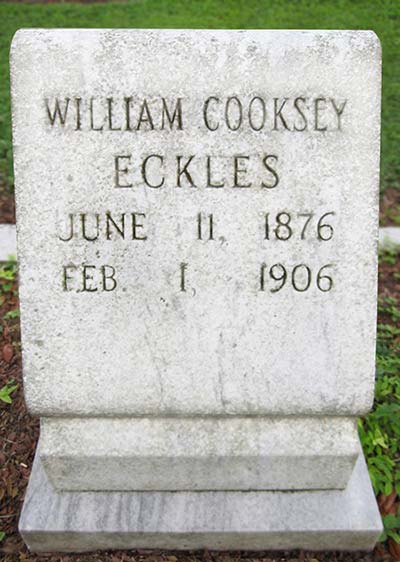
William Eckles was the second oldest man in the department and the second to die in the line of duty at this point.
At right, a tribute by his grieving father, Joseph David Eckles.
The City Council appointed a committee to draft a resolution on the death of Lt. Eckles, and continued his salary while a pension for his widow was being discussed.
MRS. ECKLES RECEIVES A PENSION
In late March, Mrs. Eckles asked the City for compensation in the loss of her husband in the line of duty. She asked for total $3,000 in monthly payments. This was granted by City Council on April 24 in the amount of $50 per month for five years. (In 2019 dollars this would be like $1,440 per month. |
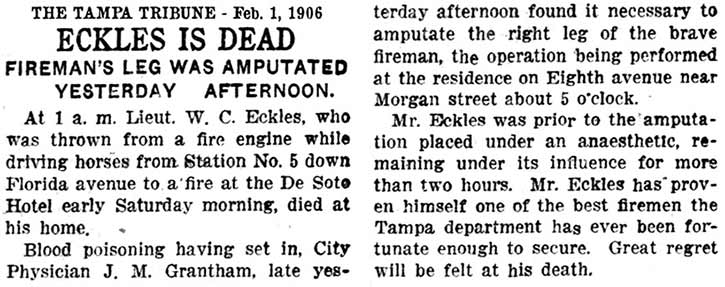
|
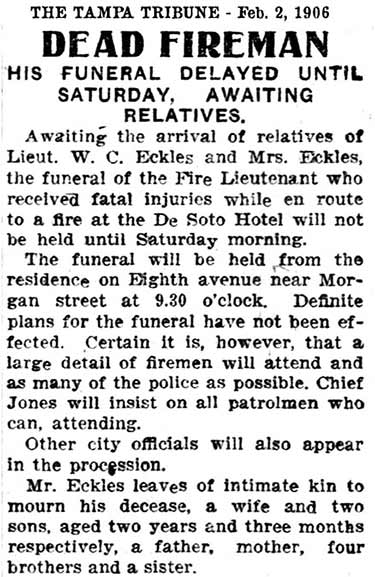
The 1910 Census in Tampa shows at 209 Oak Ave., 31 year old Dora Eckles, widowed, born in Georgia, with sons William (6) and Gray (4) both born in Fla. Dora has no occupation. In 1940, Dora was listed on the census as a Circuit Court deputy clerk.
|
|
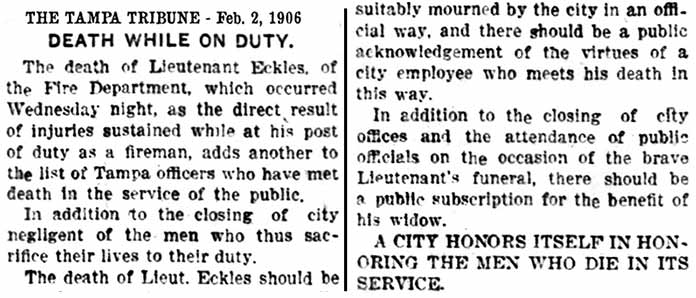
|
|
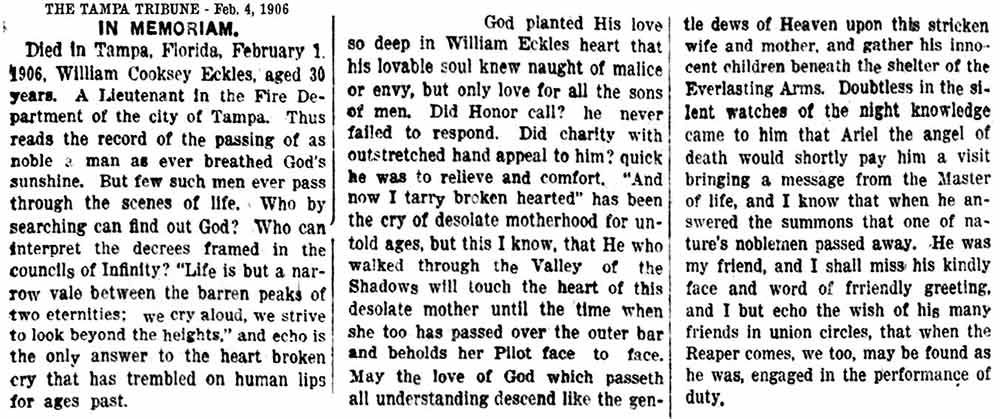
|
|
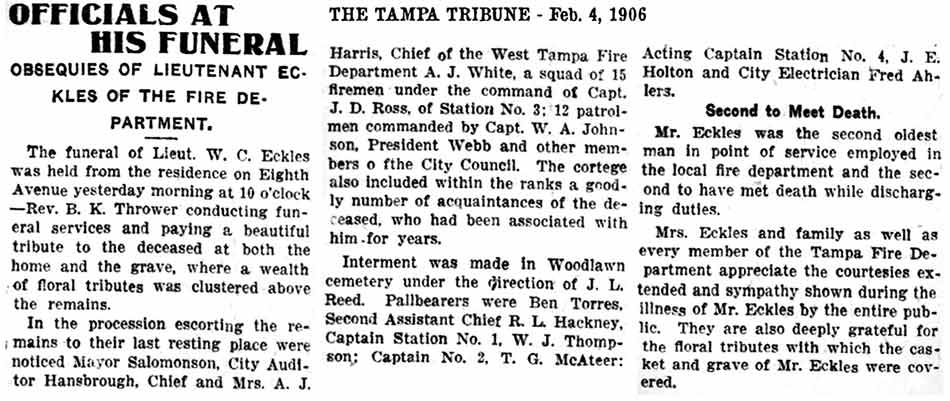
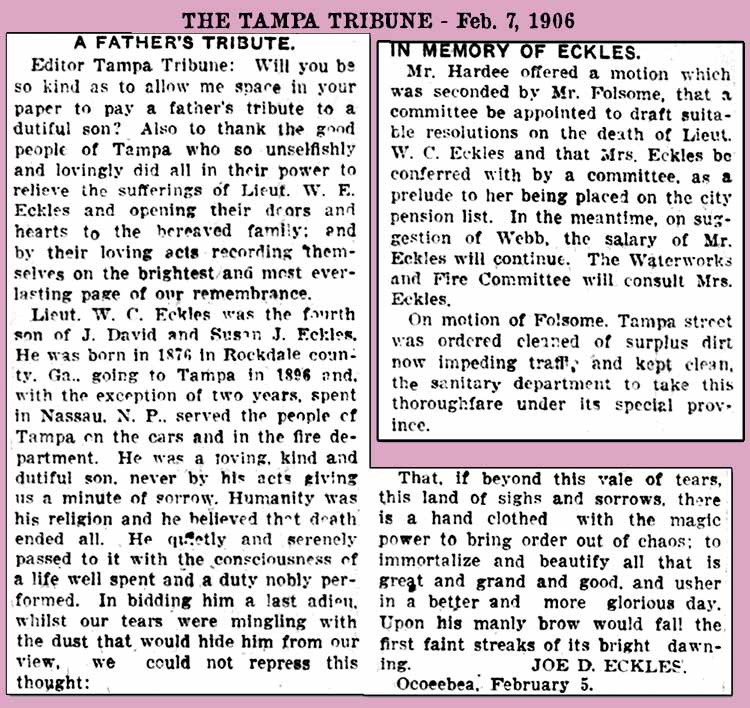
|
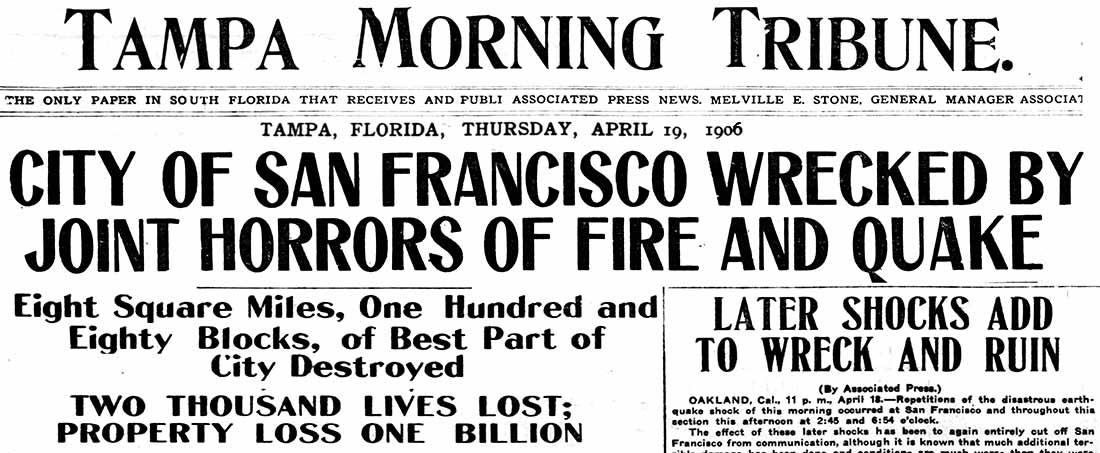
In the weeks
that
followed
this great
tragedy,
several
committees
in Tampa
organized
and raised
funds and
necessities
to send to
San
Francisco's
earthquake
victims.
The
following is
a summary of
those
committees
funds they
raised.
The whole
article
listed each
committee
and the
individual
contributions
it
collected.
CLICK THE
ARTICLE TO
SEE ALL THE
CONTRIBUTORS
AND AMOUNTS.
When the
image opens,
click it
again to see
it full
size.

The grand
total of
$7,207 would
be like
$210,507 to
us today.
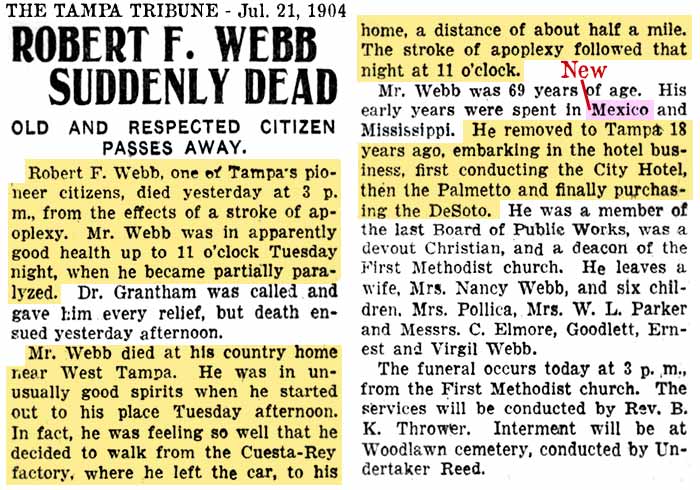
DEATH OF
ROBERT
FULTON WEBB
R. F. Webb
died on July
20, 1904,
from a
stroke which
partially
paralyzed
him on July
19th.
He was in
"unusually
good spirits
that
afternoon,
feeling so
well that he
decided to
walk home
from the
Cuesta-Rey
factory, a
distance of
about half a
mile.
The article
contains a
little about
his past and
circumstances
of his hotel
endeavors
before the
DeSoto.
More about
this is
presented
toward the
end of this
feature,
after the
section
about Thomas
Edison and
the section
about the
destruction
of the
DeSoto in
1955.
See "History
& Heritage"
article by
Leland
Hawes, who
presents
details
provided by
a Robert &
Nancy Webb's
great-granddaughter,
Nell Trice
Roberts.
PARKER SELLS
DESOTO TO
HIS
ASSOCIATES,
BIG NEW
HOTEL IS
RUMORED
In the fall
of 1906,
Walter L.
Parker sold the
DeSoto to a
number of Ocala
developers
who were
associates
of his.
The new
expanded
ownership planned
to replace
the old wood
structure
with a four
story brick
and stone
building.
The
improvements
were
scheduled to
begin after
the State
Fair in
November.
The planned
improvement
of $150,000
along with
other
construction
projects in
Tampa set
a one-month
record high
of $210,432
for
November,
topping Oct.
1906 by just
over
$125,000.
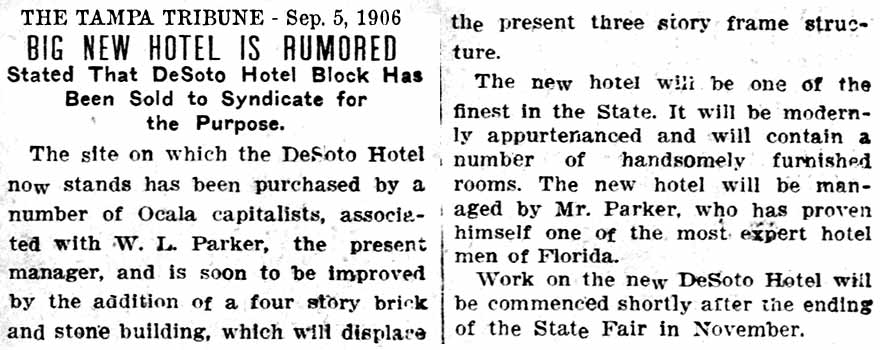
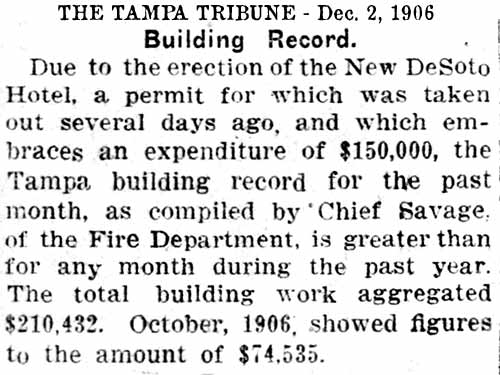
CONSTRUCTION
PERMIT AMONG
TOP FOUR
LARGEST IN
TAMPA
HISTORY
The new
construction
was touted
as the
largest
permit in
the history
of Tampa,
with the
possible
exception of
H.B. Plant's
Tampa Bay
Hotel, the
new Sacred
Heart
Catholic
Church, and
the new
Federal
Building.
The hotel
would be
known as the
"New DeSoto"
which would
be built
fireproof
with steel
beams, with
its own
electric
power plant
and steam
laundry.
It would
take up the
whole block
between
Polk, Zack,
Morgan, and
Marion
Streets and
have three
entrances.
The new
building
would be 210
feet square,
eventually
taking up
the whole
block, with a space
for a
courtyard of
around 50 x
100 feet.
The whole
project
would be
done in
phases, with
the original
building
remaining
until the
greater part
of the new
hotel was
completed.
It was
expected
that Elmore
Webb would
oversee the
project.
Architect of
the Tampa
Bay Hotel, J.
A. Wood, was
hired to
design the
the new
hotel.

|
THE ANNEX BITES THE DUST |
NORTH WING FOUNDATION LAID |
FINE INK WELL ARRIVES FOR FRONT DESK |
| The first to go was the two-story wood structure along Polk St. that was built as an annex with extra rooms for the original wood frame hotel. 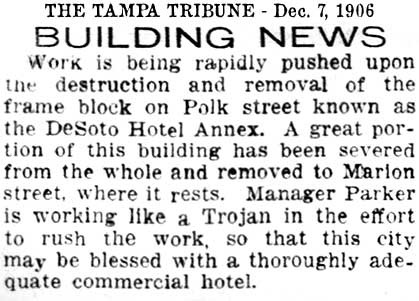
|
By the end of Feb. 1907, a new foundation had been laid along Marion St. and Polk St. This was for the north wing on the northwest corner of the lot and the main building that fronted Marion Street.
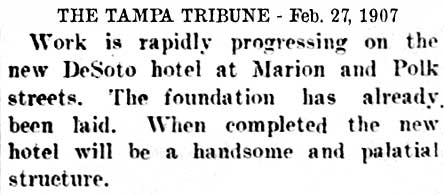
|
As construction on the main building progressed rapidly, a fancy ink well trimmed in silver with onyx pedestal and silver pole supporting incandescent lamps was received from the American Hotel Supply Co.
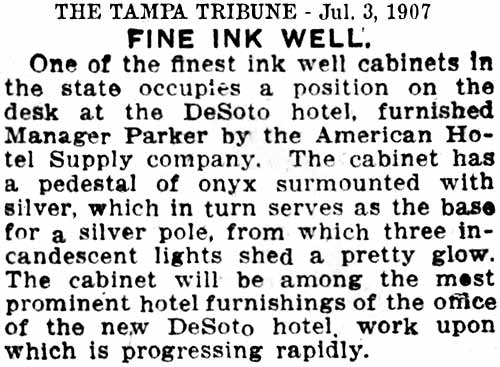 |
|
OLD DESOTO TO BE MOVED TO BACK OF LOT |
OLD BUILDING MOVED, THIRD PHASE BEGUN |
OLD BUILDING NOW IS THE DESOTO ANNEX |
|
Owner of the DeSoto W.L. Parker announced in late July 1907 that the old DeSoto would close on Sat., Aug. 3. He originally planned to keep it open longer but work was progressing so quickly on the new hotel that they needed to start the next phase of construction: moving the old building to the rear of the lot to make room for the south wing of the main building.
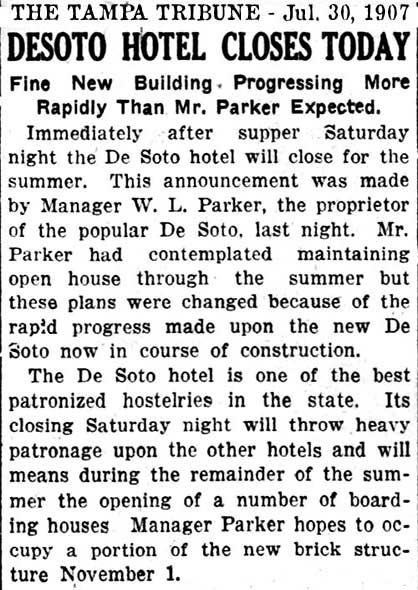
|
By Sep. 1907, the old structure had been lifted, rotated 90 deg. counterclockwise, and moved to the rear of the property along Morgan Street. This second phase, the annex, would be completed as soon as possible so as have space for temporary offices, some rooms could be refurbished on the upper floors and a large dining room created on the ground floor. 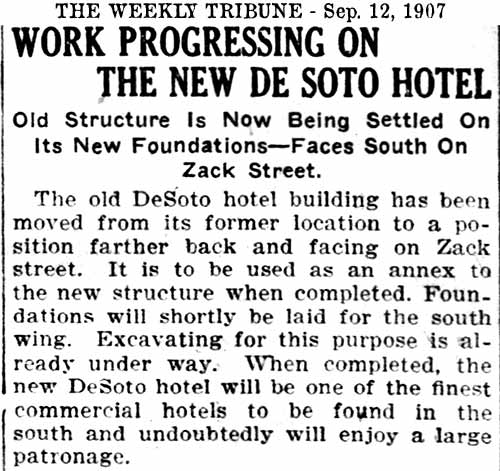
|
By the end of Oct. 1907 the concrete floor, roof and cornices of the new building were being worked on. A probably opening of January was a highly optimistic guess. The old three-story building was to reopen next month; this was another optimistic prediction. 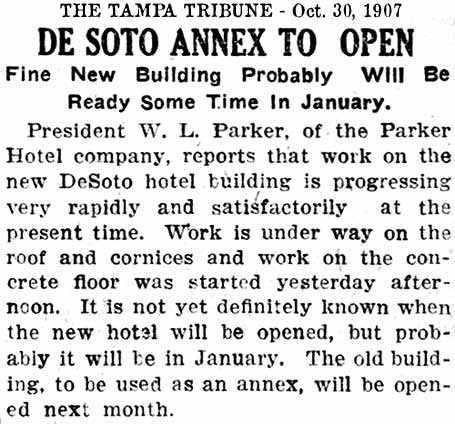
|
The
original
3-story
wood
frame
building
was
rotated
90 deg.
counterclockwise
and
moved to
east
side of
the
block
along
Morgan
St.
In
mid-November
1907 the
projected
completion
dates of the
main
building and
the annex
were
pushed back
due to
difficulty
in obtaining
some
building
materials.
A portion of
the main
building "will
in all
probability"
be ready for
occupancy by
Jan. 1 and
the annex
was expected
to open in
early
December.
J. A. Wood
was expected
to flip the
switch on
the lighting
at night
within a
short time.

|
|
The newly relocated and refurbished annex was opened to guests on the evening of Nov. 30, 1907 and the first meal was served the following night, Dec. 1. W. L. Parker had no estimated date that the completely new main building would be finished.
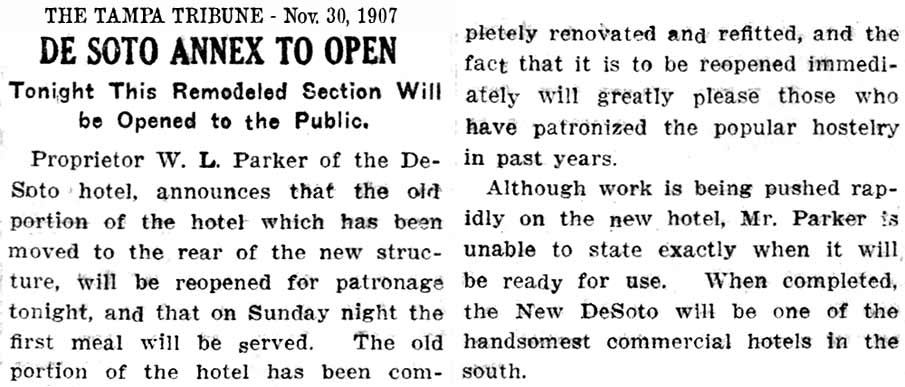 |
 |
|
ROOMS BEING FURNISHED DAILY
Architect J. A. Wood was furnishing and completing new rooms in the main building every day. A large number of rooms were expected to be ready for guests in early February, just in time for state fair visitors. |
PLUMBING CONTRACT AWARDED TO JOUGHIN In early Feb. 1908 the plumbing contract for furnishing and installing fixtures to the new annex was awarded to Joughin Bros. This was a prestigious accomplishment for that company as their work was under the supervision of noted architect J. A. Wood, and it called for fine plumbing and expensive fixtures. |
|
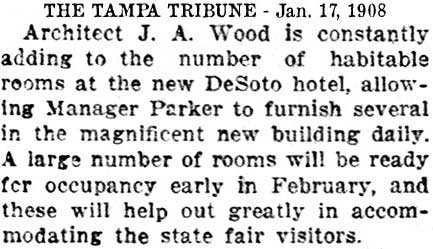
|
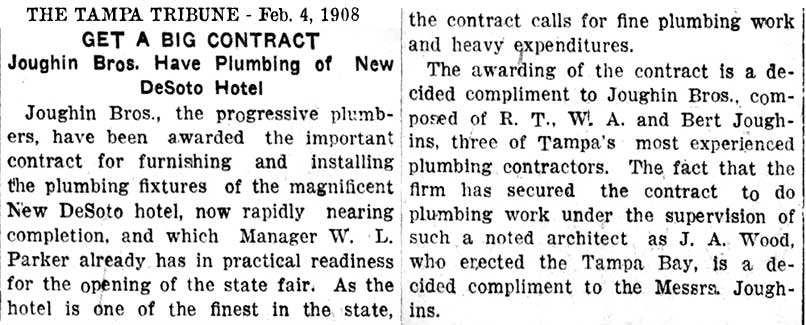
|
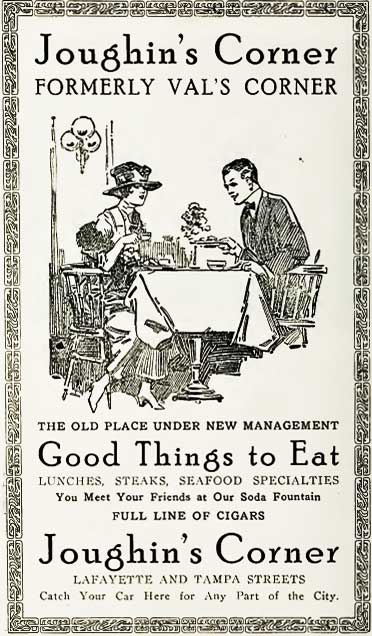 |
ROBERT T. JOUGHIN Born in Terrel, Texas in 1880, Bob Joughin moved to Sanford, FL in 1884 with his parents. He received his early education there and later took special commercial, plumbing and heating engineering courses. He came to Tampa in 1897 and worked odd jobs for a few years, learning to be a plumber under the apprenticeship of K. R. Lau Plumbing Co. In 1904 he went into partnership with W.E. McAndrews as Joughin & McAndrews. A year later, his brother, W.A. Joughin, bought McAndrews's interest in the company and the firm became Joughin Brothers Plumbing & Heating Co. In 1909, he married Miss Lula M. Jackson, a granddaughter of early Tampa pioneer and surveyor John Jackson. In 1917, Bob Joughin bought his brother's interest when W.A. entered the army and his company became R.T. Joughin, Inc. Knowing the business from the ground up, Mr. Joughin was enabled to secure and carry out the plumbing and heating contracts for the largest buildings in Florida.
In addition to his plumbing business, in the early 1920s he owned "Joughin's Corner," a large cigar, refreshment and restaurant business at one of the most prominent corners in Tampa, Lafayette & Tampa St. Always in interested in politics, Mr. Joughin served for twelve years as a member of the Democratic Executive Committee.
Image at left from "Rinaldi's Guide Book of Tampa", 1922. |
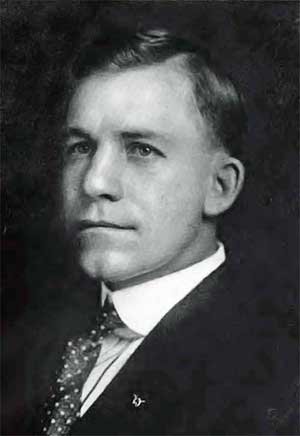
R. T. Joughin, ca. 1915
Image above from "Men of the South" See full reference below.
|
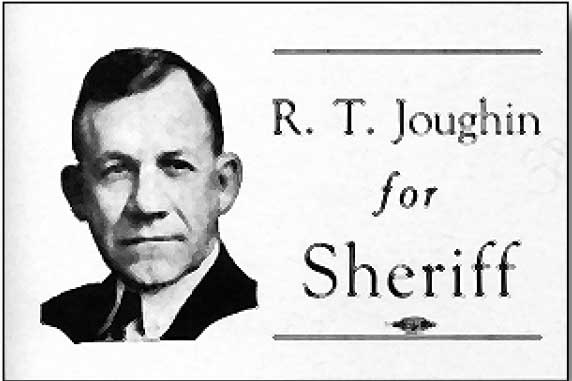 |
|
Image from "Smoking Guns"
See full reference below. |
In 1928 Joughin was appointed to serve as sheriff of Hillsborough County by Gov. Doyle E. Carlton as a result of controversy concerning alleged corruption of the current sheriff, L. M. Hatton. Joughin served for three years as Sheriff during the "smoking guns" gangster era in Tampa. Joughin's daughter, Lula Joughin Dovi, was an author and a writer for the Sunland Tribune, Journal of the Tampa Historical Society. In her article about her father, "Smoking Guns," she wrote: "My father was called from his plumbing and heating contracting business by then-Governor Doyle E. Carlton to begin serving the unexpired term of the Sheriff who was suspended. And as I recall that period I remember seeing a machine gun sitting in the corner of his bedroom and two pistols resting under his pillow. There was an ever present threat of ambush."
Sheriff Joughin ran for re-election in 1932 but lost. There were rumors of ballot box "stuffing." Former Governor Carlton told Lula when her father died in 1961 that he and her father were told about a polling place where there was allegedly some ballot box "stuffing." The two of them were getting ready to go check out the rumor when, as Carlton recalled, "We remembered we didn’t have any guns on us." |
| LULA JOUGHIN DOVI, native of Tampa, a daughter of Sheriff R.T. "Bob" Joughin, was a great-granddaughter** of John Jackson, surveyor of downtown Tampa and many areas of Florida, through her mother. A 1940 graduate of Plant High School, she received her A.B. degree from Florida State University and her M.A. degree from University of South Florida. She was a countywide coordinator of social studies and art for Adult and Community Education, Hillsborough County Public School System and served as vice chairperson of Hillsborough County Democratic Executive Committee and as a member of the board of Carrollwood Civic Association, and attended the Democratic National Convention as an alternate delegate. She was a member of Phi Delta Kappa, educational honorary. **The original Sunland Tribune article says she is the granddaughter, but that is not the case. John Jackson and wife Ellen Maher Jackson had four children, their oldest was son Thomas E. Jackson. Thomas married Kate E. Warner. Of their children that reached maturity was their third child, Lulu Marguerite Jackson, who married Robert T. Joughin. These were Lula Joughin Dovi's parents.

|
|
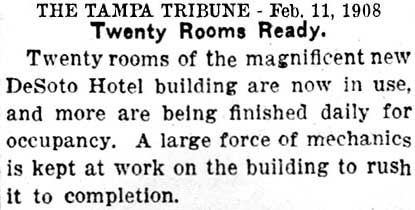
In mid Feb. 1908, twenty rooms were "now in use" but the article doesn't say what they're being used for. "More are being finished daily for occupancy" doesn't really clear it up as "occupancy" doesn't specify guests. |
|
FINISH THE MAIN BUILDING FIRST In late April 1908 Parker decided that no more new additions would be constructed until the main building was completed. A seventy-five foot long porch verandah was under construction. The lobby would be 62 ft. by 62 ft. and it was expected that over 62 rooms ready soon. It would seem that guests were already booking rooms, whether or not they were occupied at the time remains to be seen. |
|

|
|
|
|
In late May 1908 a contract for tile floors was awarded to "Prof. O. H. de la Morton" for floors in the offices of the new building. The work was expected to start as soon as the materials arrived.
|
In early June, work on the floor had begun in preparation for the tile. The work was being supervised by Allen L. Feeks of the National Mosaic Flooring company. He was from Mobile, Ala. and was "thoroughly experienced in the work" and would see to it that the tile was laid properly. |
The tile arrived in mid-June aboard the steamer Morgan. Thirty-nine thousand of the sixty-nine thousand pounds were for the new DeSoto. The rest was for a new store in Mulberry.
|
|
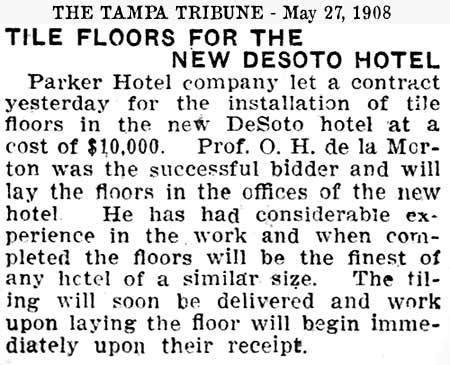
|
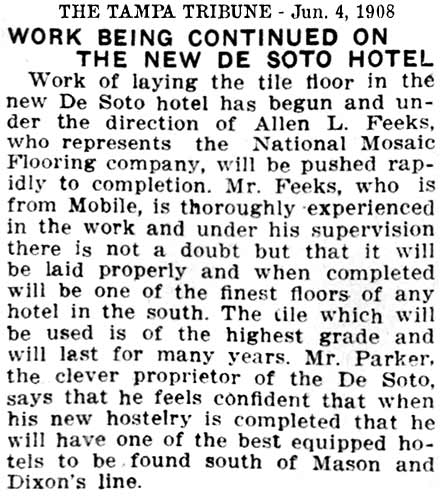
|
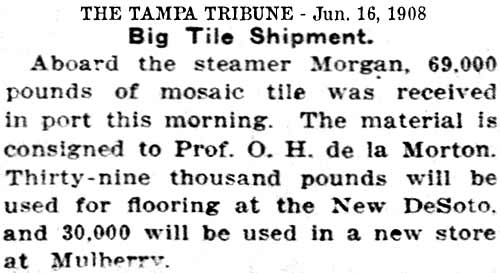
Parker was confident that the new DeSoto would be one of the best equipped hotels to be found south of "Mason and Dixon's line." |
|
|
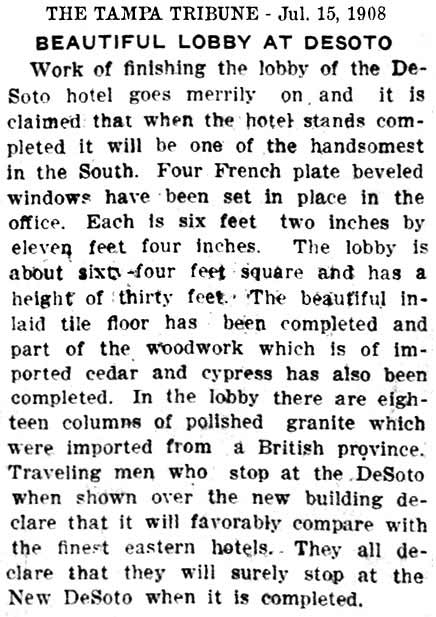 |
The main building was almost completed in the latter third of August, pending the arrival of office furniture and electrical fixtures. The office, which was temporarily in the frame annex, was to move to new building and the old office space in the annex was to convert to a dining room. |
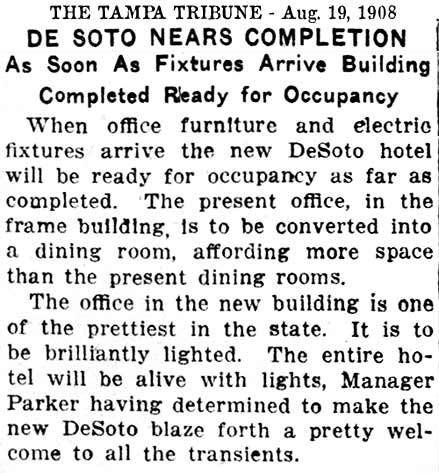 |
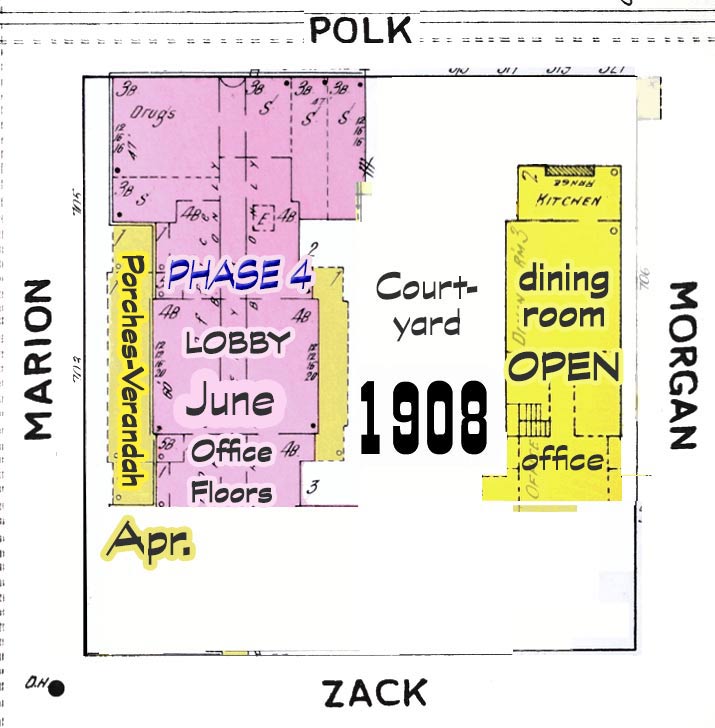 |
|
NOT THE ANNEX
This Sep. 11th article is improperly titled, as it is not the annex but the main building that was ready for occupancy in about a week. 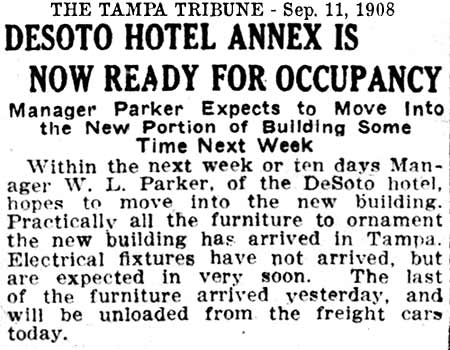
|
MAIN BUILDING COMPLETED, DINNER TO BE SERVED On Sep 18th, 1908, Parker announced that the completed portion of the main building would be opened on the following day, and dinner would be served in the temporary dining room at 6:15. Here, the reporter refers to the main building as the southwestern wing. There is no doubt it is the main building since it is the location of the lobby and the excavating at the southwestern corner had not yet begun.
Parker was making the plans to finish the rest of the building--the south wing, but had not yet determined when that would start. |
|
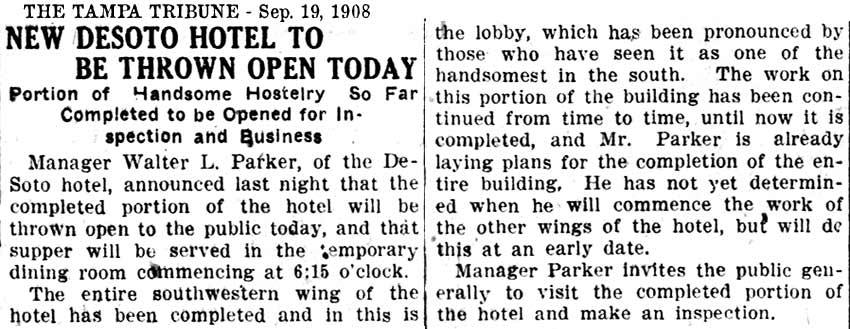
|
| |
|
| EXTERIOR COMPLETED In late Sep. 1908, with the exterior completed and some minor interior work being done, owner W. L. Parker is presented with a bouquet of roses from a shoe company that was having a convention there. The convention put a strain on room availability, but all went smoothly on opening day, "this has not daunted Manager Parker." The hotel was described as "Well lighted and imposing, presenting an attractive appearance to the ey and proving to be a great drawing card." |
|

|
| BARBER SHOP OPENED BY WILLIAMS & PEACOCK |
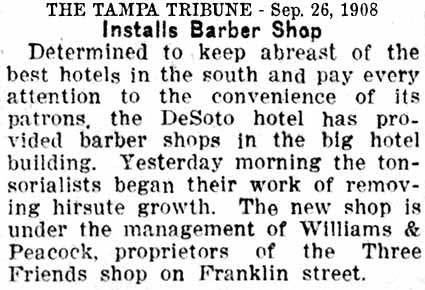 |
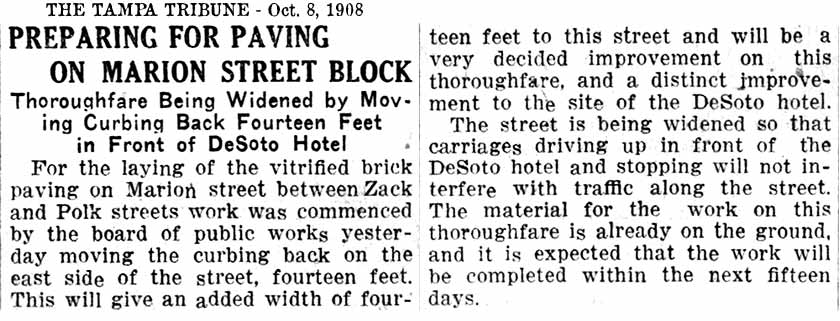
|
In late Sep. 1908, Williams & Peacock, the owners of the "Three Friends" barber shop on Franklin St, opened on in the DeSoto.In mid October 1908, Marion Street in front of the hotel was paved and widened, so that traffic wouldn't have to stop when passengers were being dropped off. Later, this would cause a big stink when a city auditor finds that the bill for this was footed by the city and not the hotel.
The placement of the dining room and barber shop on the map at right is arbitrary and not necessarily where they were actually located.

|
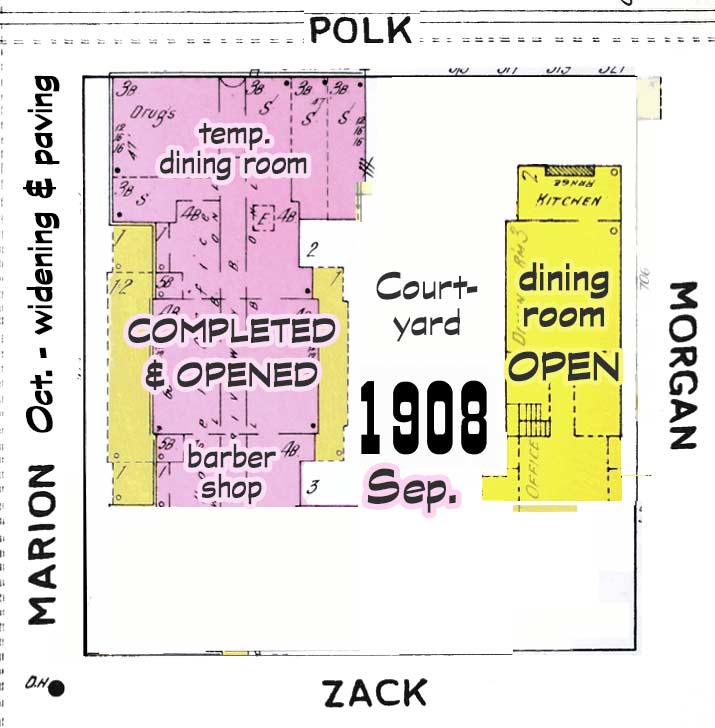
|
| NEW SIDEWALK |
CONSTRUCTION ON SOUTH WING |
|
| In late Jan. 1909 Parker had the old sidewalk torn out and was replacing it with a new 9 ft wide cement walk. |
In mid-May 1909 it was announced that by the end of the year and into next spring, 1910, work would start on building the new south wing at the corner of Marion and Zack. The spring months of 1909 were prosperous for Parker and the upper floors of the new wing would provide additional rooms. It was imperative that this be done before the opening of the next winter season on 1910. |
|
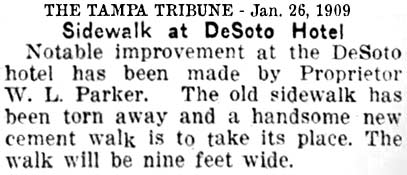
|

|
|
PREPARATIONS FOR GRASSY LAWN |
THE TILE FLOOR IN THE LOBBY
From a 1924 photo |
|
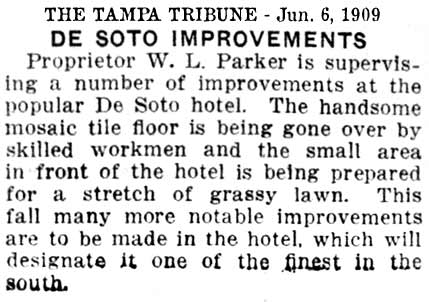
|
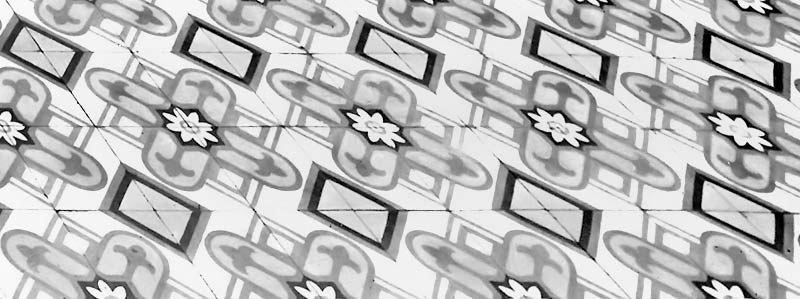 |
|
CIGAR STAND INSTALLED BY ELI WITT
July 4, 1909 - Cigar distributor Eli Witt, who's motto was, "Cigars, that's my business!" bought the shop from Joseph Palmer in the post office which was in the basement of the new Federal building and negotiated with W. L. Parker to put a cigar/newspaper stand in the DeSoto, leaving Palmer to manage both places. The finest of fixtures would be arriving soon. 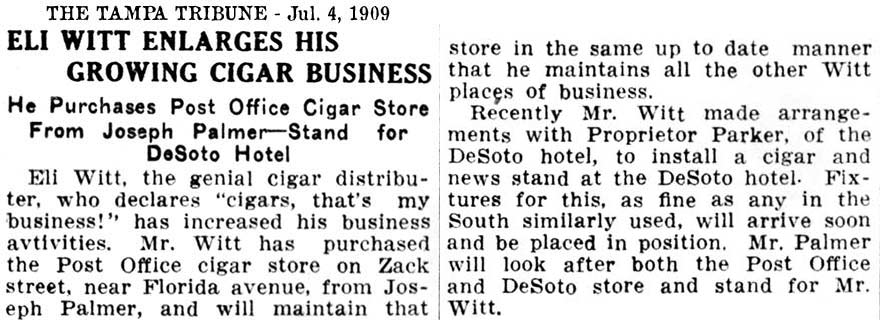
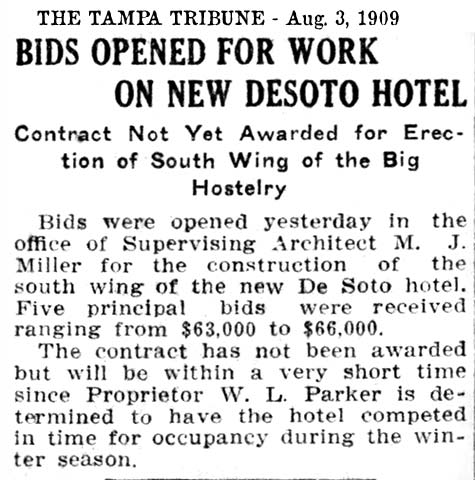
BIDS OPENED FOR SOUTH WING In early Aug. 1909 bidding was opened for a contractor to build the new south wing of the hotel. Five principal bids were received ranging from $63k to $66k. A decision from Parker was expected soon because he was eager to open the hotel in time for the upcoming winter season.
BIDS TOO HIGH, DECIDES ON INDEPENDENT LABOR
Parker decided not to contract with a construction company because he thought the bids were too high. His estimate was that the south wing could be built for $50,000 to $60,000 using freelance carpenters. By mid-August 1909, work had begun on clearing the south half of the property to build the south wing foundation. The south wing was to be a duplicate of the north wing. Carpenters had begun work on excavating for the foundation but Parker was using "day labor."
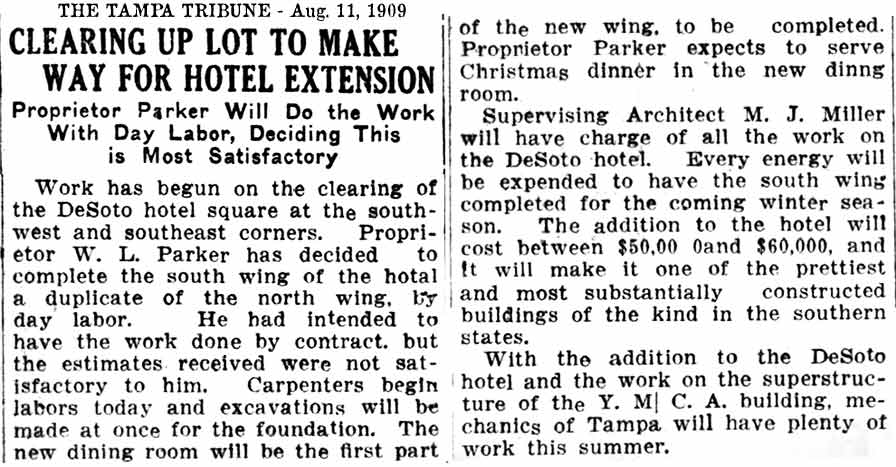
|
Within a month after the news was released, Witt had his stand up and running in the DeSoto. The fixtures had just been installed the night before, all bought from and installed by E. R. Beckwith. Parker and Witt were both pleased with the results, which also included a newspaper stand. The shop was situated in the southeast section of the lobby.
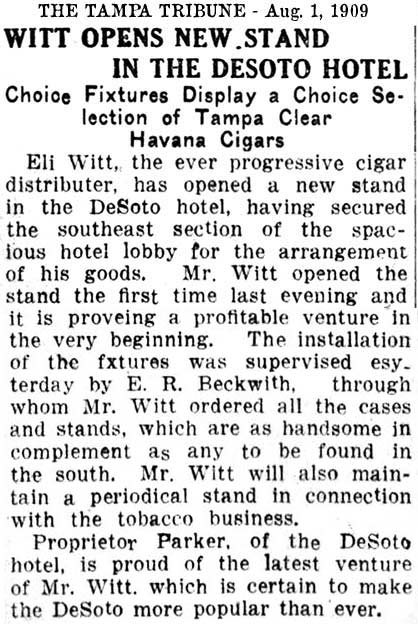
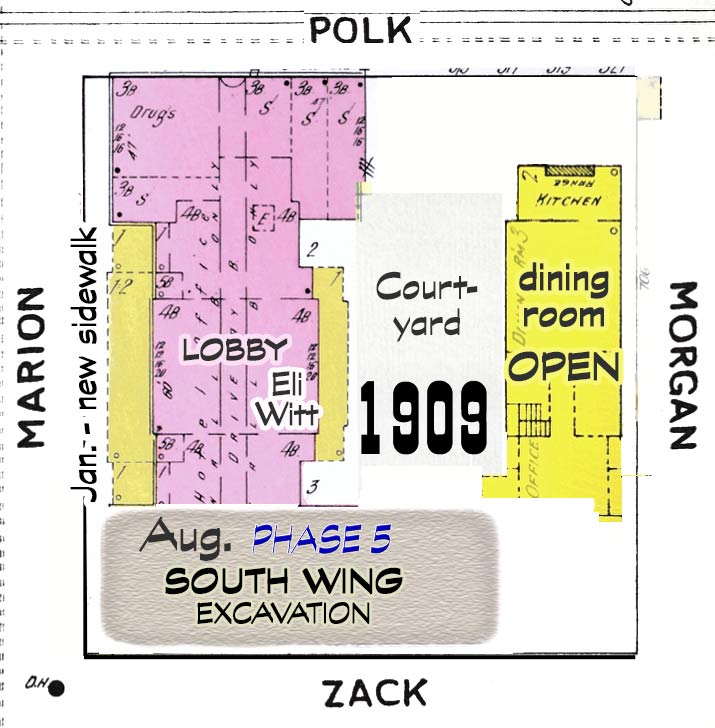
|
| |
|
|
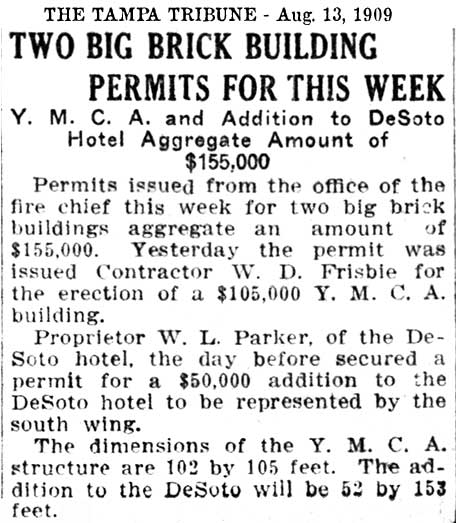
$50,000 PERMIT ISSUED FOR DESOTO CONSTRUTION

In mid-August 1909 a permit of $105k was issued for construction of the new YMCA building, and another for $50k to Parker to build the new south wing of the Desoto. This was $13k less than the lowest bid he received from construction companies earlier this month. The entire south wing was to be 52 ft x 153 ft. but a later article shows that the entire wing wasn't built at this time. $50,000 in 1909 is like $1.42M today. |
|
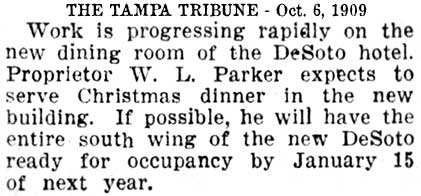
|
RUSH TO COMPLETE DINING ROOM IN TIME FOR CHRISTMAS
In early Oct. 1909 Parker was trying to get the new dining room on the first floor of the new south wing completed in time to serve Christmas dinner in it. The whole wing was expected to be completed for occupancy by Jan. 15, 1910. |
|

|
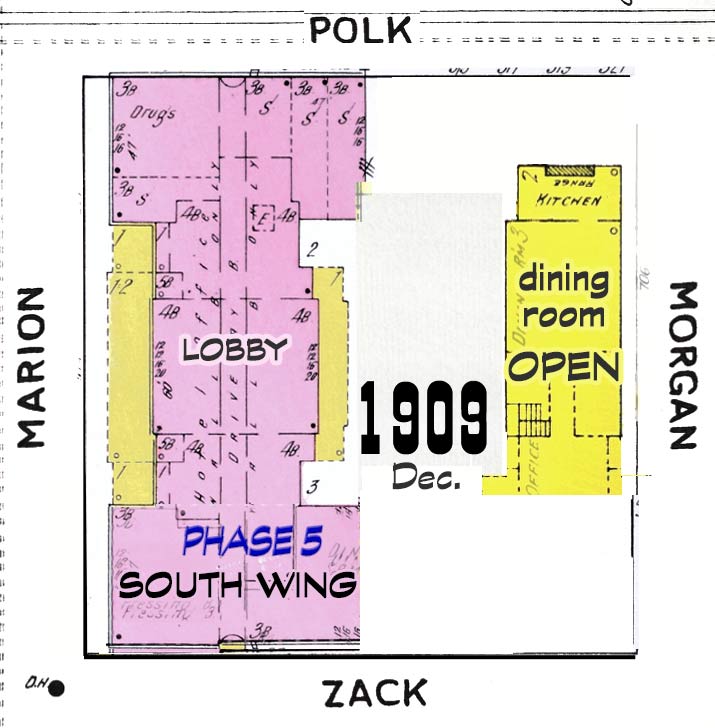
The roof of the south wing was completed in late Oct. 1909.
In early Nov. 1909 C. E. Webb said the new addition was 50 x 80 feet, with the lower floor devoted entirely to dining purposes. Its 80 ft. length indicates that it did not extend all the way along Zack St. to Morgan St. as the Aug. 13 permit described (52 x 153.) The second floor would house 27 sleeping rooms with baths. It's not clear if the remaining work on the south wing is a reference to this nearly completed structure or to the next phase which was to extend this wing along Zack St. towards Morgan St. |
|
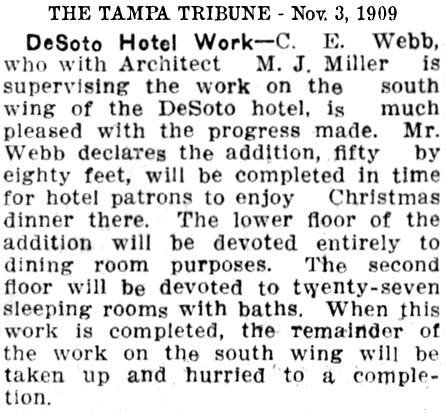
|
|
|
|
| INTERIOR WORK STARTED ON SOUTH WING |
DINING ROOM STILL EXPECTED BY CHRISTMAS |
|
|
By Nov. 20, 1909, work had begun on the interior of the new south wing. Parker expected to serve Christmas dinner in the new dining room a month later. 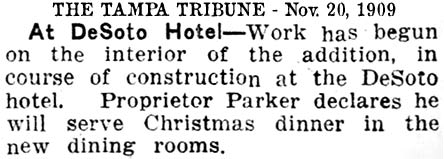
|
Fifteen days before Christmas and Parker thinks he will be serving dinner in the new dining rooms "even before Christmas."
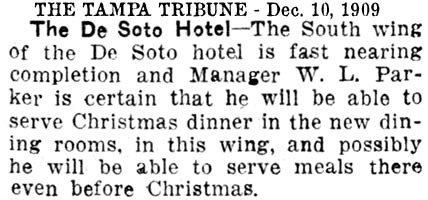 |
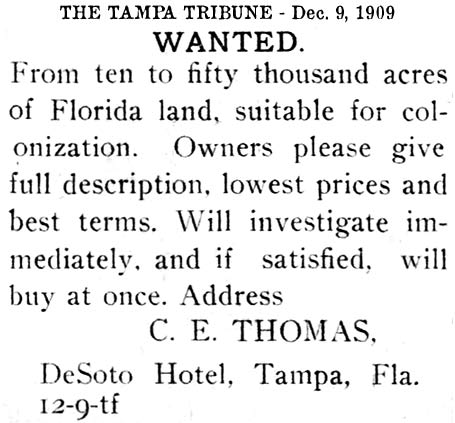
|
|
FINISHING TOUCHES ON DINING ROOM
In mid-December 1909 workmen were rushing to place the finishing touches on the new dining room in the south wing and Parker expected to serve guests there in two days. The new dining room was described as "a model of artistic beauty, roomy and well arranged." Solid marble columns ran its entire length down the middle of it and on each side with the room being steam heated. Ten electric fans cooled the room in the summer and 48 electric lights lit the room. A private dining room "of magnificent proportions" adjoined the main room on the north. 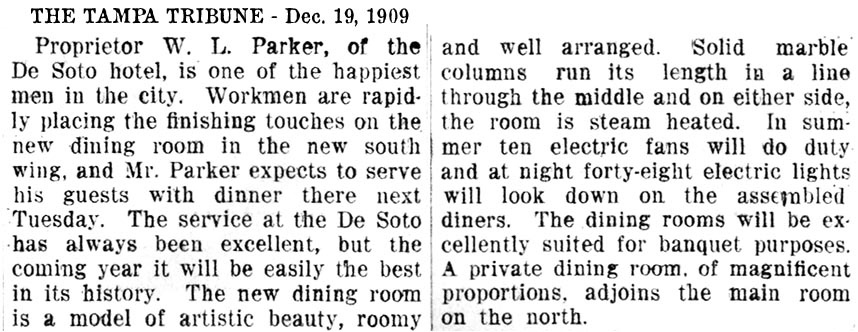
 Tuesday was Dec. 21, but after the above article on the 19th, nothing more is found in the papers about the Desoto (except for a handful about who was staying there, and the one at right) until Christmas day. Tuesday was Dec. 21, but after the above article on the 19th, nothing more is found in the papers about the Desoto (except for a handful about who was staying there, and the one at right) until Christmas day.
Parker had a farm north of West Tampa where he raised produce and possibly livestock to supply his hotel. |
C.E. Thomas, along with a group of other Chicago investors, formed the "North Tampa Land Co." around 1905 and in 1910 bought 32,000 acres of land 20 miles north of Tampa near Stemper. The Chicago-based company advertised their plans extensively all over the North and Midwest in newspapers, focusing heavily on Michigan, Indiana and Ohio. They developed the area into the town of "North Tampa" which in 1913 was renamed "Lutz."
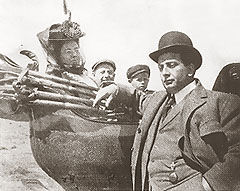
Read about this at TampaPix's History of Lutz 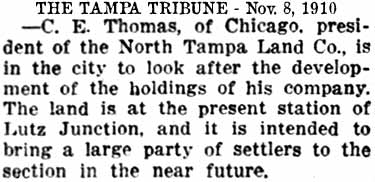
|
|
|
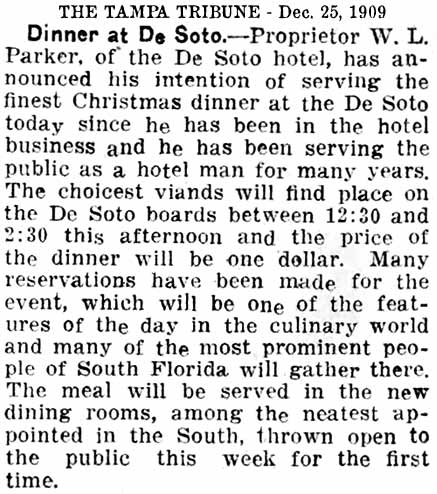
CHRISTMAS DAY, 1909
Workers must have really felt pressured to finish the interior dining rooms but they got it done just in time, as no announcement was made in the paper until Christmas morning that dinner would be served on time.
The finest dinner that Parker had ever served since he had been in the hotel business, consisting of "the choicest viands, "will find place on the DeSoto boards between 12:30 and 2:30 p.m" for ONE DOLLAR.
This may sound ridiculously cheap but according to the Dept. of Labor statistics Consumer Price Index, $1 in 1909 is equivalent in purchasing power to about $28.35 in 2020. Still not a bad price for a first-rate meal.
Apparently the news of the dinner was out on the street before the article which said many reservations had already been made.
|
FIRE IN THE DESOTO LAUNDRY ROOM
On Jan 19, 1910, two fires broke out that could have been disastrous, but both were quickly contained with little loss. |
|
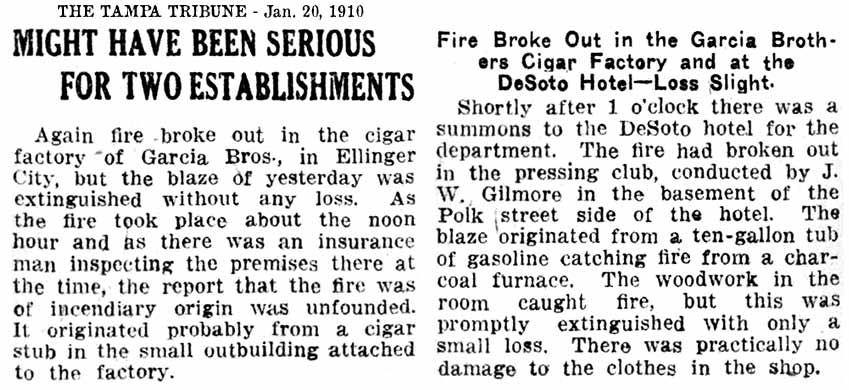
|
The fire at the Garcia cigar factory in Ellinger City (later it was called Roberts City) was ruled not of incendiary origin. Today we use the term "arson." Interesting that an insurance inspector was on the premises at the time. Being the worst possible time for a fire to take place, one would think immediately of the competition as suspect, or at least a disgruntled employee, and back then there were plenty. At the DeSoto hotel, a fire broke out in the "pressing club." Today we call it the laundry room. Why would they have a tub of gasoline in a laundry room?
This is why: |
|
According to research published by the National Institute of Dry Cleaning, turpentine spirits, camphor oil, benzene, naphtha, kerosene, and white gasoline were common dry cleaning solvents in the late 19th century. In 1898, carbon tetrachloride imported from Germany was sold as a dry cleaning and spot-removal agent and in the early 1900s, raw white gasoline was the primary dry cleaning solvent used in the U.S. Around the early 1900s, distillation was first used to purify spent solvents. Steam presses came into operation in 1903 and by 1905, clarifying systems, including settling tanks, were used to purify dirty solvents. By 1915, the average U.S. dry cleaning operation used approximately 12,000 gallons of gasoline per year. It wasn’t until 1924 that Lloyd E. Jackson and W.J. Stoddard developed specifications for a higher flash point petroleum dry cleaning solvent, which later became known as the Stoddard solvent. In 1928, the U.S. Department of Commerce required a minimum flash point of 100 degrees Fahrenheit for petroleum dry cleaning solvents, which resulted in drycleaners beginning to use the Stoddard solvent.
| In mid-April 1910, Mr. & Mrs. Parker went to stay at their farm for several weeks, but Mr. Parker planned to visit the hotel every day. |
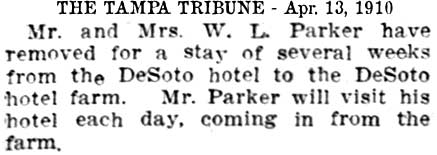 |
(Info from The History of Drycleaners Written by: Ruxandra Niculescu, CEO of REM.)
|
SOUTH WING TO BE FINISHED BY OCT. 1910
|
|
In late July 1910 it was announced that Parker expected the new south wing addition to be completed by October 1 that year. Later plans included an improved courtyard with a pool containing alligators, and a garden cultivated with flowers. With the new south wing the DeSoto was to have 150 rooms. 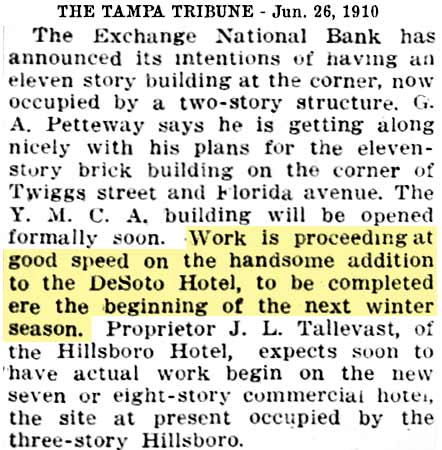
|
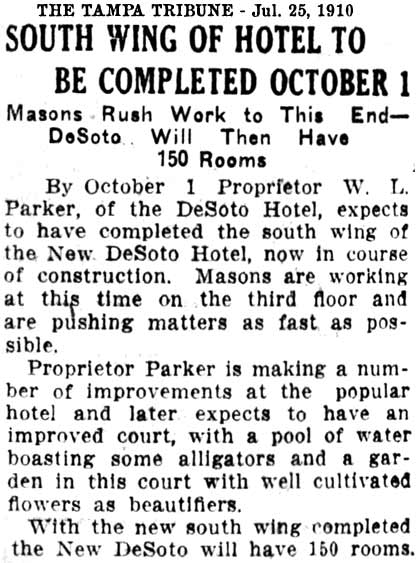
|
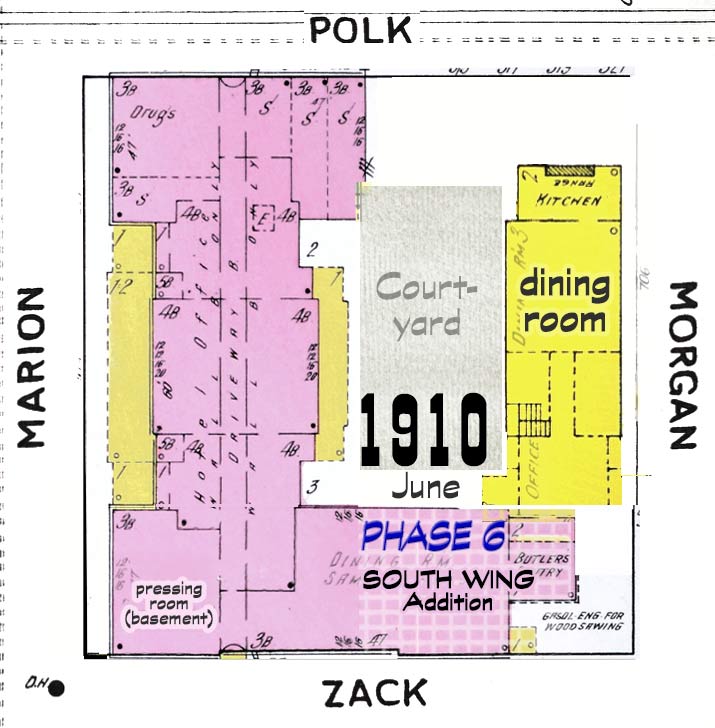
|
| |
| In late August of 1910, the new south wing addition was progressing rapidly and expected to open in time for the winter season rush. The construction of the wing and other improvements was an outlay of $30,000. |
IMPROVEMENTS PLANNED FOR CORNER OF POLK & MARION STREETS
The corner of Polk and Marion Streets was undergoing many great improvements toward the end of summer, 1910. A new brick ice plant was planned for the northeast corner and the lumber from the heavy hauling offices of W. O. Hobbs, which currently occupied the corner, was torn away to be used to build cottages elsewhere. Parker planned to tear away the last remaining wood structure at that corner and build on the the hotel with more brick buildings. |
|
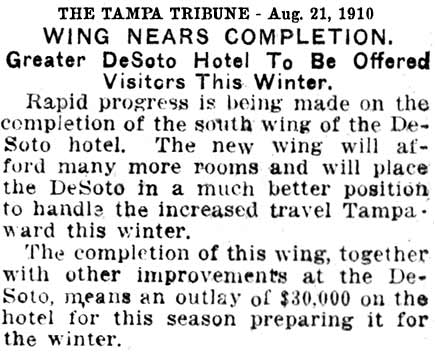
|
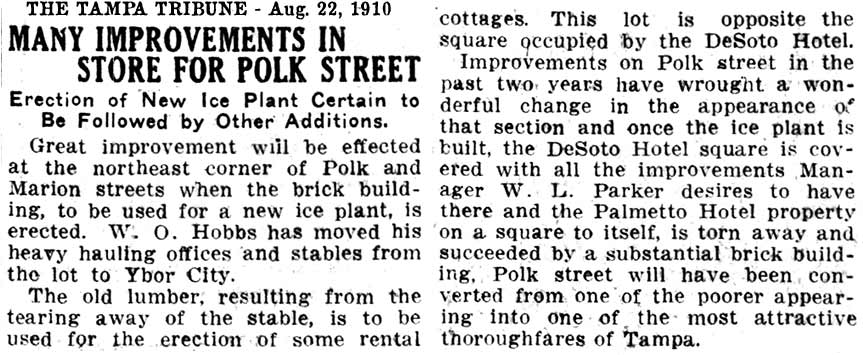
|
| |
| DESOTO DOES LANDMARK BUSINESS W.L. Parker reported that Sep. 4, 1910 was the best business the hotel had done in the past four to five months. Reservations from northerners planning to spend the winter in Tampa were beginning to increase and Parker was looking forward to the best winter in the history ofd the DeSoto. |
CONSTRUCTION WORKERS STRIKE
A journeyman's plumbers strike in Oct. 1910 caused a shortage of plumbers at various establishments around Tampa. Master plumbers were expected to fill the void which along with the cigar workers stirke, was causing a limited number of jobs available in construction. Serving as a Journeyman Plumber is a key requirement of becoming a Master Plumber. Although a Journeyman and a Master Plumber are both licensed as plumbers, a Journeyman's work centers on plumbing only while a Master Plumber can own a plumbing business, supervising other plumbers and is experienced at plumbing as well as business management.. |
|
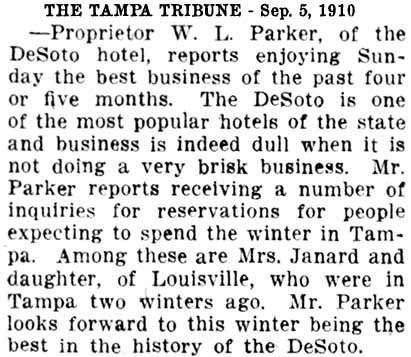
|
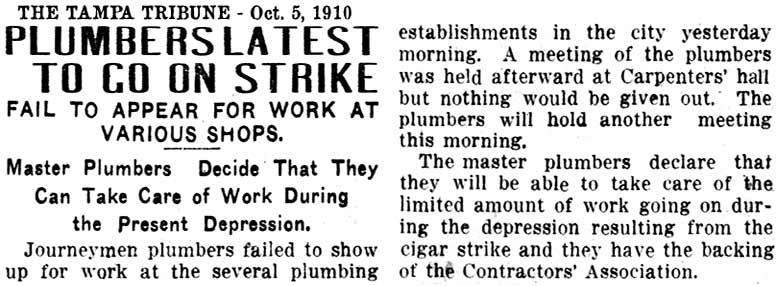
|
| |
| |
|
|
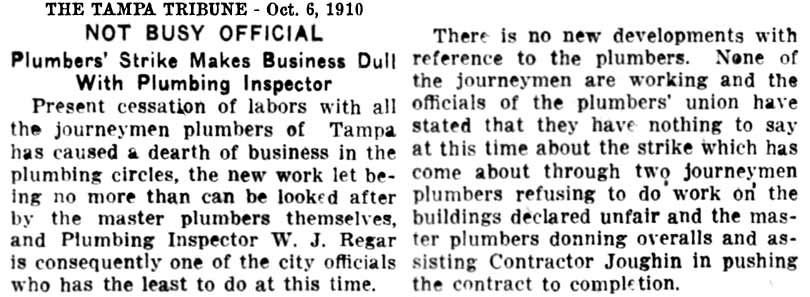
|
PLUMBERS CLAIM UNFAIR WORKING CONDITIONS
The plumbers strike left Tampa's plumbing inspector W. J. Regar with little work to do. The plumbers union had nothing to say about the strike which came about due to two journeymen plumbers who refused to do work on the buildings declared unfair. |
| |
|
| |
|
|
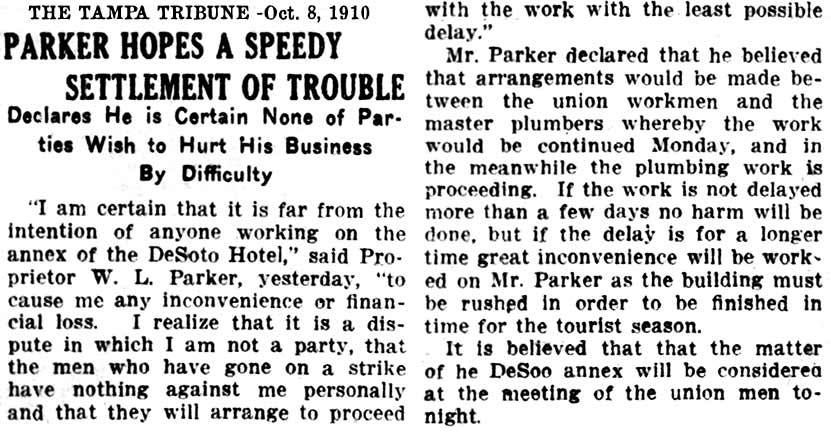
|
W. L. Parker spoke out saying he was sure that the strike was nothing personal directed against him and that he believed something was being worked out so that work on the DeSoto would not be delayed more than a few days. If the delay was to be longer, it would be a great inconvenience and cause a rush to finish in time for the tourist season. |
| |
|
| CONTRACTORS FIGHT BACK, PLAN TO HIRE NON-UNION |
|
|
At a meeting of the Contractors' Association, it was decided that to pass a resolution approving the use of any class of labor to complete construction on the DeSoto. The strike had expanded to include carpenters, plasterers and painters in early October. Contractors were surprised when their employees walked out because none of them had ever been accused of being unfair with their workers. "Both Mr. Webb and myself have been among the best friends that union men have in Tampa" said Mr. Pimberly of the Buildings Trades Council. 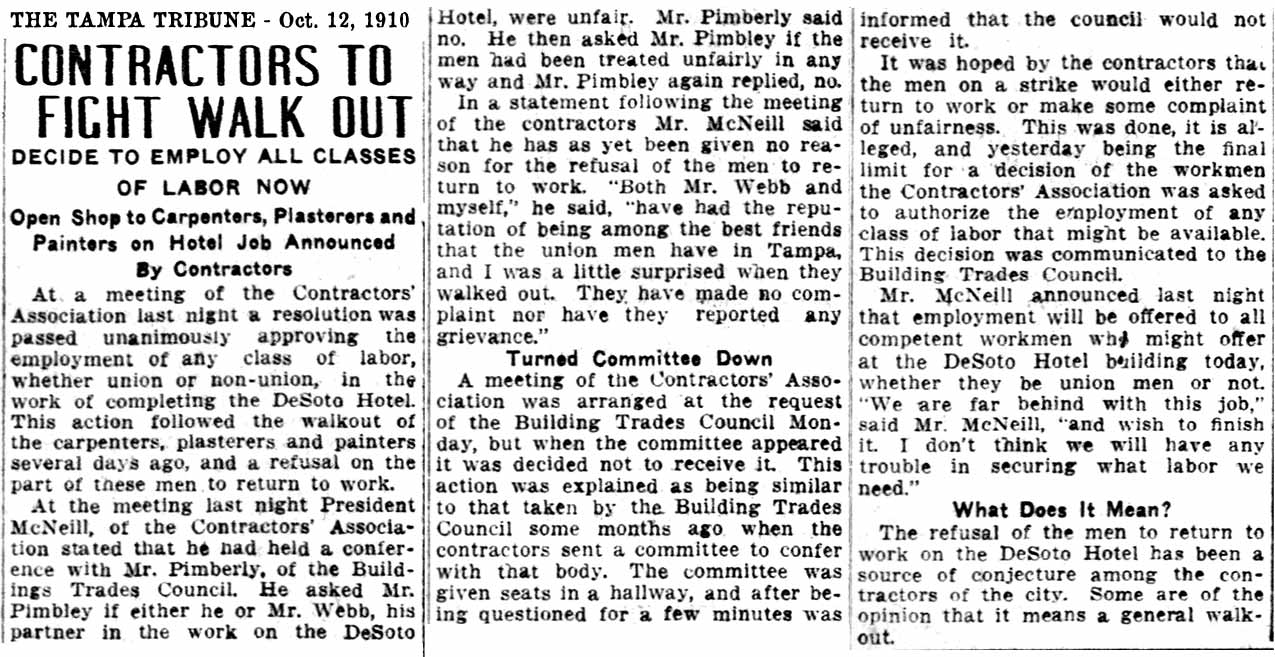
|
| |
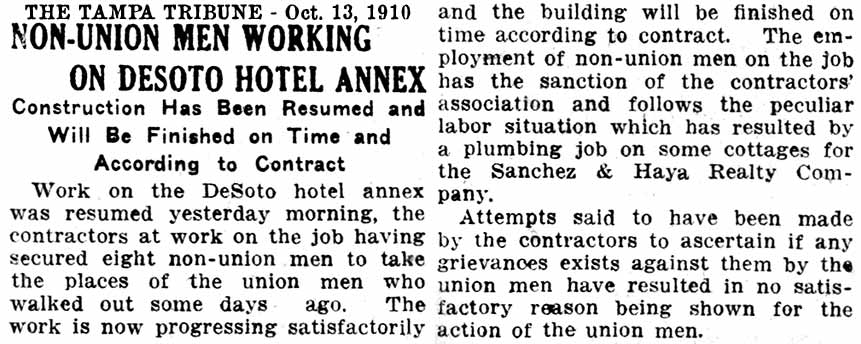 PARTIAL WORK FORCE RESUMES
Work on the DeSoto resumed when eight non-union men were hired to replace the striking men. The work was being done with the approval of the contractor's association after a dispute by plumbers at the Sanchez & Haya realty company job site caused the strike. Attempts had been made to find out if any grievances existed against the the contractors at the DeSoto but no satisfactory reason had yet been given. |
| |
TRIBUNE SUPPORTS CONTRACTORS
|
|
The Tribune voiced its opinion on the strike by taking sides with the DeSoto contractors, stating that it was unfair for workers there to walk out when there were no issues with their work there. It further stated that the labor unions could not take a stance claiming the adoption of the "open shop" policy at the DeSoto site was a blow to unionism by the contractors, as every observance of the union rules were being followed in the treatment of their workers. It ends with a strong statement, "Let this be fully understood...by all parties concerned before the present trend of public sentiment in Tampa proceeds further in the development of a course of action which has been forced upon it by the unreasonable and town-wrecking attitude of the union men themselves." 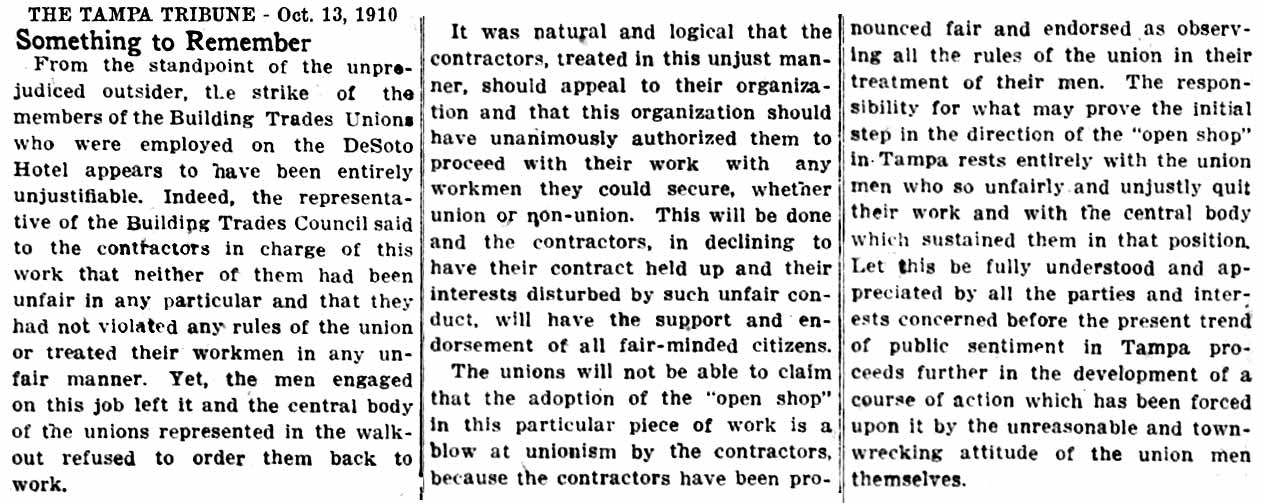
|
| |
|
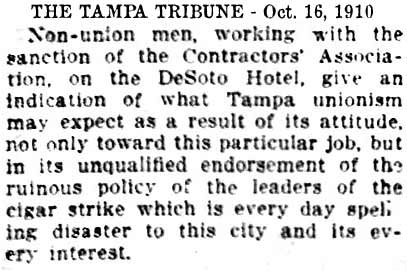
|
The Tribune warned the unions that the non-union men working with the contractors on the DeSoto Hotel should be a lesson to the unions as to what they can expect with their "unqualified endorsement of the ruinous policy of the leaders of the cigar strike which every day spells disaster to this city and its every interest." FINE TILE BEING LAID IN ROOMS AND CORRIDORS
In early December, 1910, fine tile had arrived from Mobile and was being laid in the rooms and corridors of the new wing of the DeSoto. "These tiles are exactly like those in use for centuries in Spain and Cuba, and the big factory in Mobile is the only plant in America except a small attempt in Ybor City by some non-English speaking Cubans." The article goes on to describe the tiles, the company who makes them, and the durability and better economy of tile floors for the long run. |
|
The 25 day delay of work on the DeSoto caused 10 days of no work being done and the recent rains have caused damage because of it, due to the walls still being open to the elements.
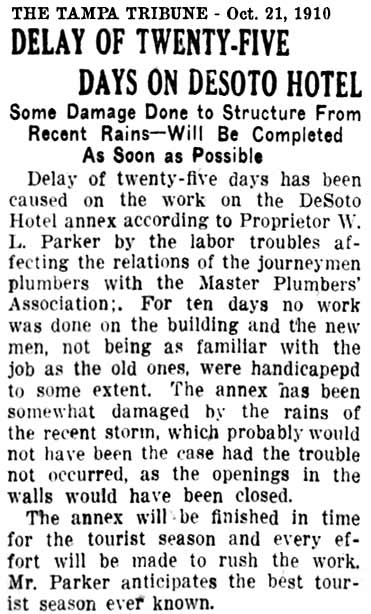
|
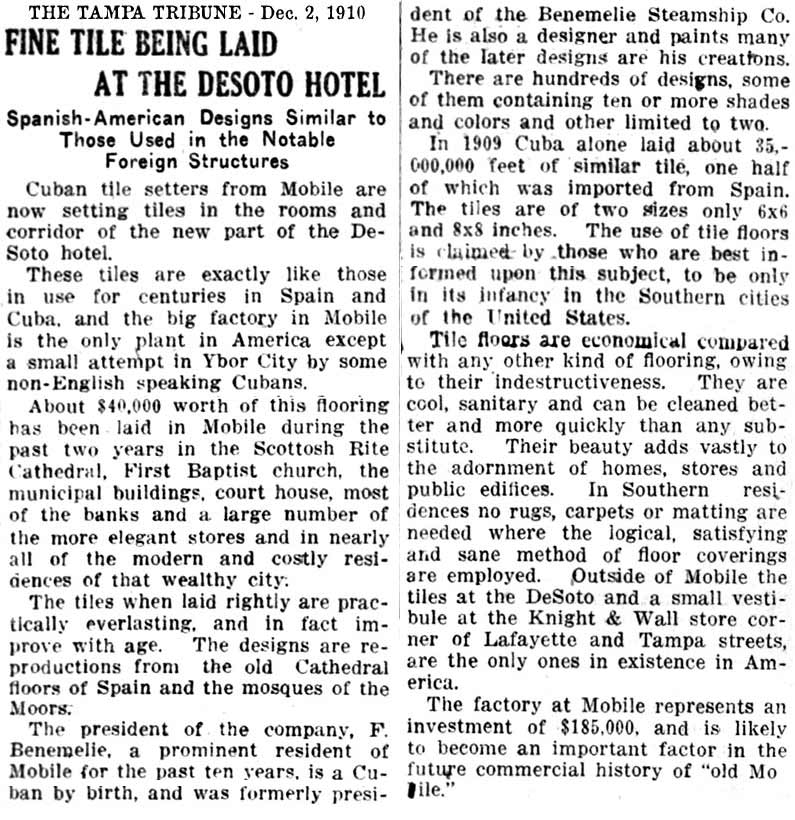
|
| TWENTY-SIX ROOMS AND MAIN DINING AREA NEAR COMPLETION IN SOUTH WING
The new south wing was expected to be finished by mid-December, 1910 adding 26 more rooms and many other conveniences. Parker next expected to extend the Morgan Street side of the hotel by finally removing the old wood frame section which was the original structure that was moved and rotated from its original location at Marion and Zack St.
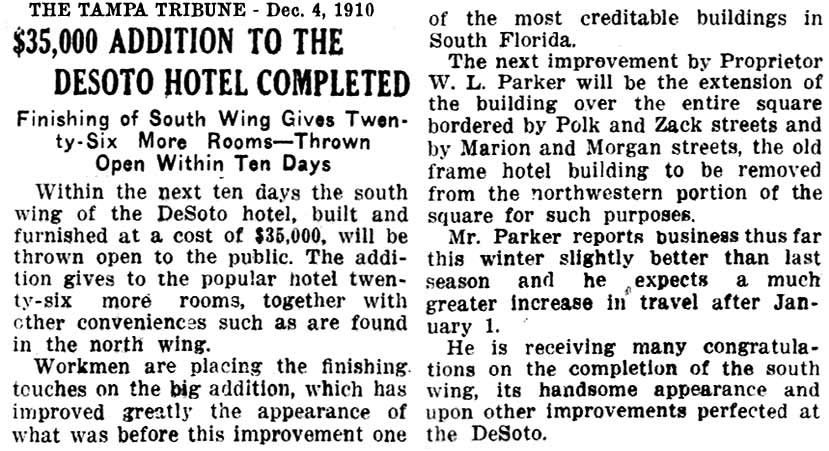 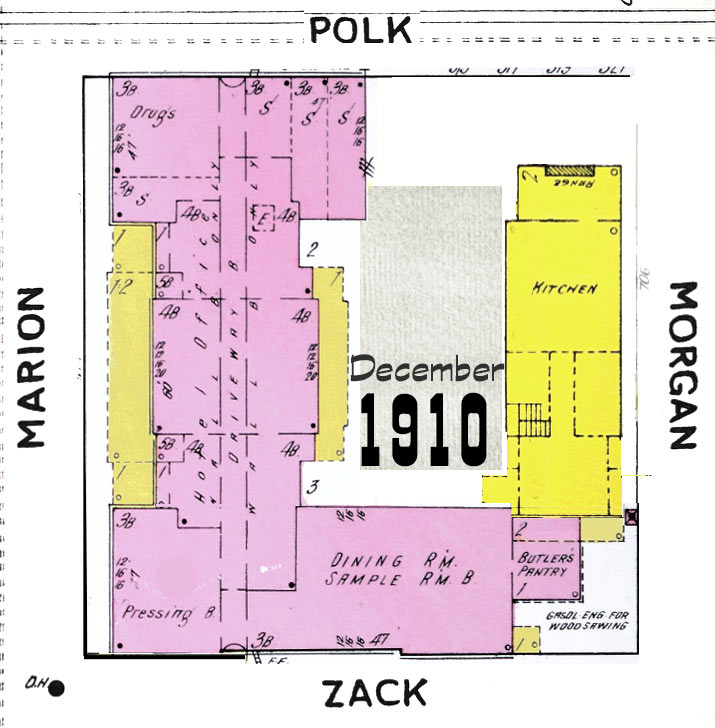
Nothing more was published about the completion of the new south wing at the DeSoto. All that was found concerned who was in town and staying there, or ads by businesses operating from there. |
|
Tampa
historian
Karl Grismer
on the
DeSoto:
| Prior to its erection [the Hillsboro Hotel,] the principal hotel open the year round was the DeSoto, built in 1892-93 by Capt. R. F. Webb and Walter Parker. Designed by J. A. Wood, the architect who had planned the Tampa Bay Hotel and the county courthouse, it was topped by Moorish domes and minarets which Wood favored and was adorned by rambling wooden porches and stately marble columns in the lobby. However, the De Soto lacked modern bathroom facilities and the Hillsboro became Tampa's leading hotel, immediately upon completion. Later the De Soto was modernized and enlarged. |
Clearly, Grismer is mistaken on a few key facts:
-
The first DeSoto was built by James Henry Thomas who came to Tampa from Ohio in 1892, not by R. F. Webb or Walter Parker.
-
Robert F. Webb bought the first DeSoto from Thomas and turned it over to his son-in-law, Walter L. Parker. Upon Parker bringing in a number of associates as co-owners, they were the builders of the NEW DeSoto Hotel.
-
J. A. Wood designed the second Desoto Hotel. To think that everything J. A. Wood designed had Moorish domes and minarets is a bit presumptuous on Grismer's part. As can be seen, both the original and the new hotel designs were far from Moorish, and the feature bearing the most resemblance to the Tampa Bay Hotel was the Desoto's front porch, verandah and decorative trimmings.
|
|
|
1910 Construction
nearly
completed on
DeSoto Hotel
#2 -- the
"New DeSoto." |

EBAY
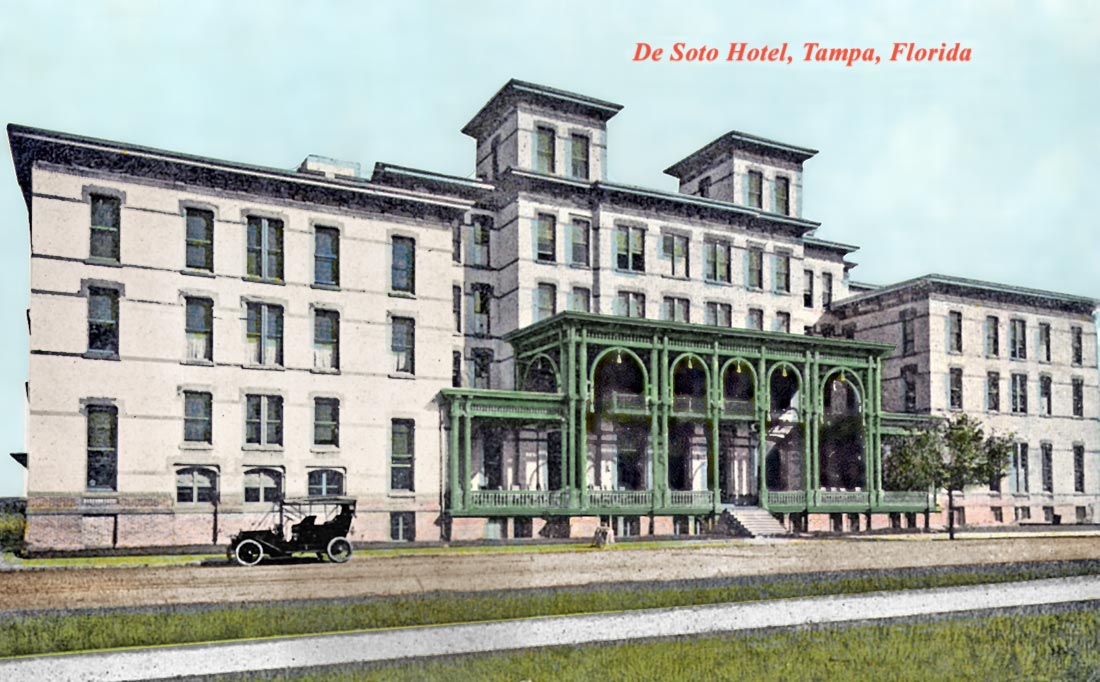 |
|
From the
Hampton Dunn
and Florida
Collection
of Postcards
at the USF
Library
digital
collections
website. |
|
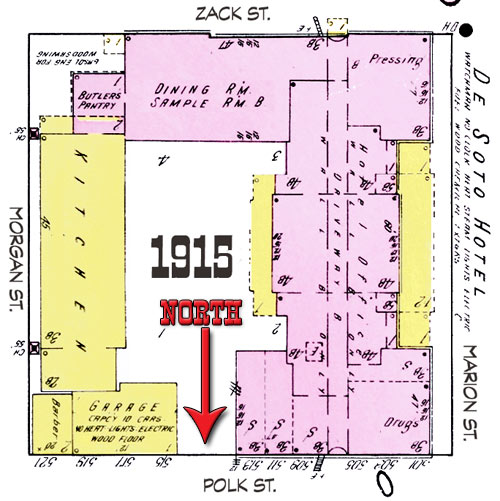
AT RIGHT:
This Sanborn map has been rotated so that north is towards the bottom and better corresponds to the photo below. By this time, the old annex was being used entirely for the kitchen on the bottom floor, with two 55' tall chimneys at the corners.
The old wood frame buildings on the corner of Polk and Morgan were a barber shop and a garage with capacity of 10 cars.
BELOW:
A rare view of the rear of the new DeSoto Hotel (upper right) with the old DeSoto serving as the "Annex" at center of the photo. In 1907, the old DeSoto had been moved from the southwest corner of the property and rotated 90 degrees to the location seen below so construction could start on the new DeSoto.
1915 photo courtesy of the Florida Memory State Library and Archives.
MOUSE OVER THE PHOTO TO SEE FEATURES IDENTIFIED. |
|
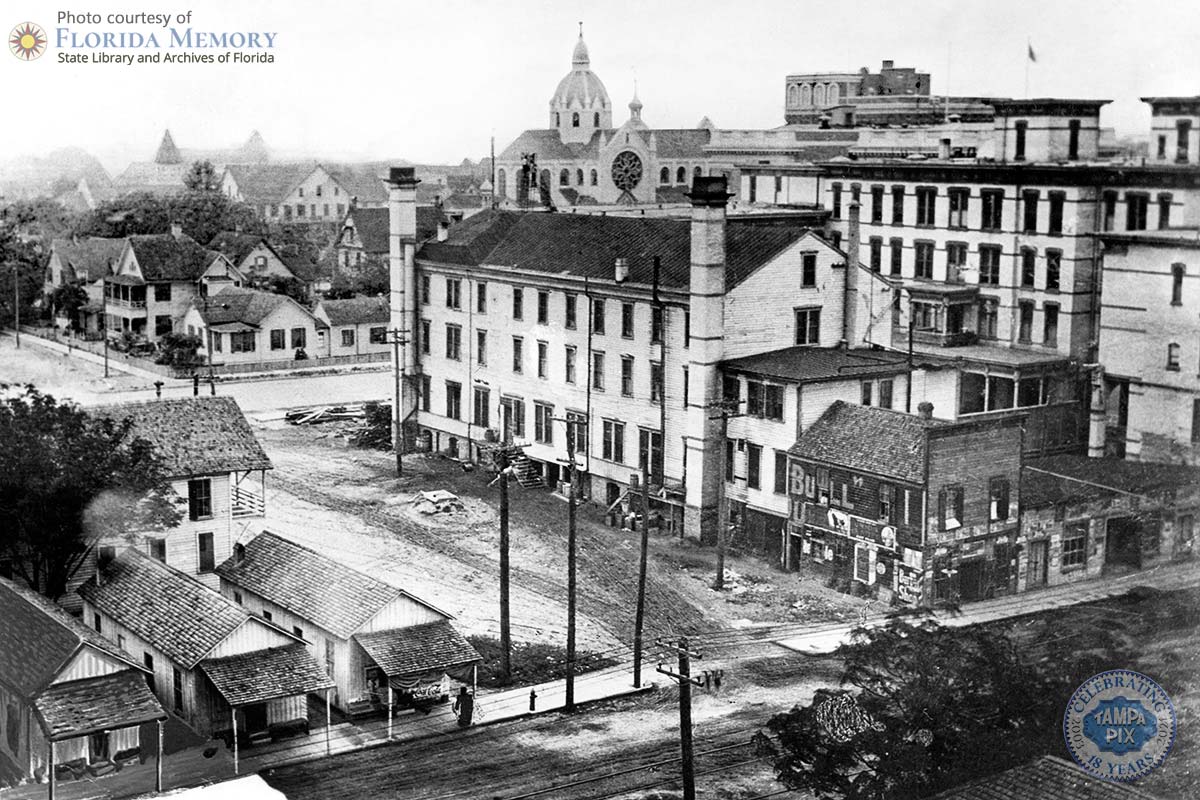
|
|
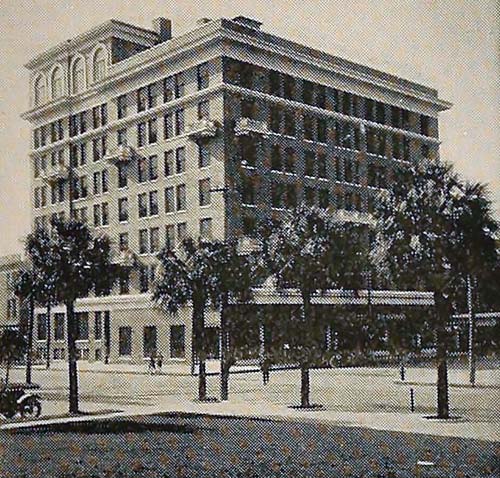
|
Plans were announced in Dec. 1910 that the old building would be removed as the final step in extending the new DeSoto all the way around the block. The old wood frame building, built in 1892-93 served as the annex until around mid-1925 when it was closed to guests and used for storage at least through March 1928.
The photo can be dated to a period from 1912 to 1916 by the appearance of the Hillsboro Hotel seen on the skyline to the right of the Sacred Heart Church dome. The first phase of the Hillsboro Hotel, seen at left, was completed in 1912 with 124 guest rooms. |
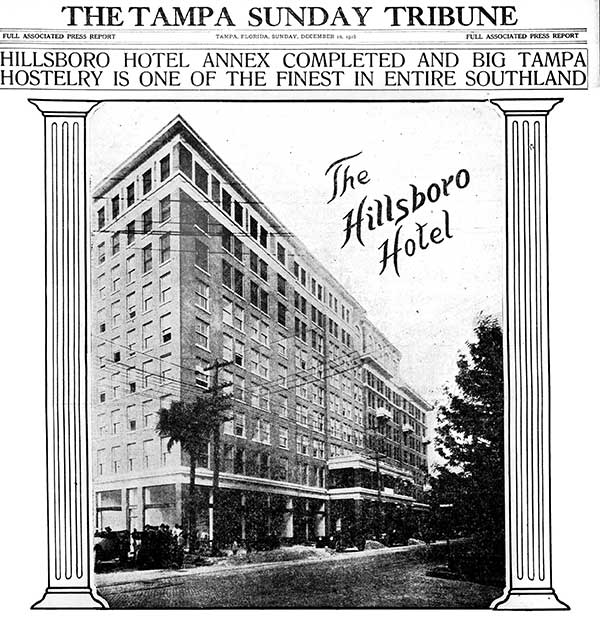
|
|
When the Hillsboro's 2nd phase was completed in late December 1916, seen at right, a structure just as tall as the tallest part of the old Hillsboro was added to the south. Both phases of the conjoined hotel in total boasted "250 rooms, an increase of 140 rooms" giving a room count of 110 for the first phase. This 2nd phase doesn't appear in the DeSoto rear view photo. |
1921 -
Company B of
the
Hillsborough
Co. Home
Guards |
 |
Burgert
Brothers
Cirkut
Camera
Panoramic
image from
the
collection
of the Tampa
Hillsborough
Co. Public
Library
website.
These
negatives
are named
after the
special
Cirkut
camera that
could rotate
up to 360°
to produce
sweeping
panoramic
views.
The
negatives
were
produced on
nitrate film
and had
deteriorated
severely
over the
years. The
library has
created new
negatives
and prints
from these
old
negatives.
Read about
the Cirkut
Camera at
the TampaPix
Burgert
Bros.
feature. |
|
Burgert
Bros., Tampa
Hillsborough
Co. Public
Library
digital
collection. |
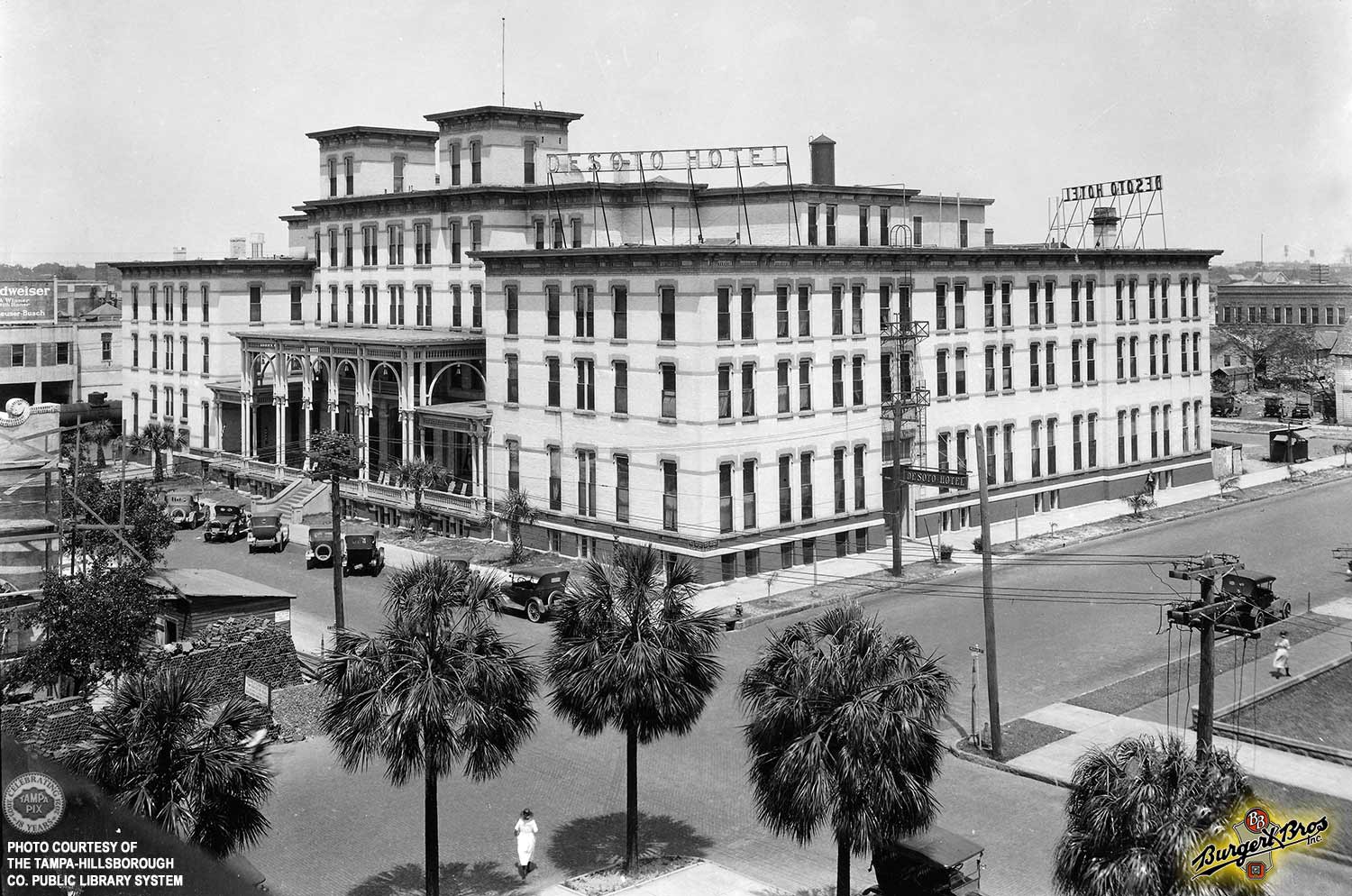
April 6,
1922
The old wood
frame annex
was still in
use at the
rear of the
new hotel,
but not
visible in
the photo.
One chimney
can be seen
at the right
behind the
DeSoto sign. |
|
The
Desoto Lobby
1924
Burgert
Bros. photo
courtesy of
the
Tampa-Hillsborough
Co. Public
Library
System
MOUSE
OVER THE
PHOTO TO SEE
THE CIGAR
STAND CLOSE
UP
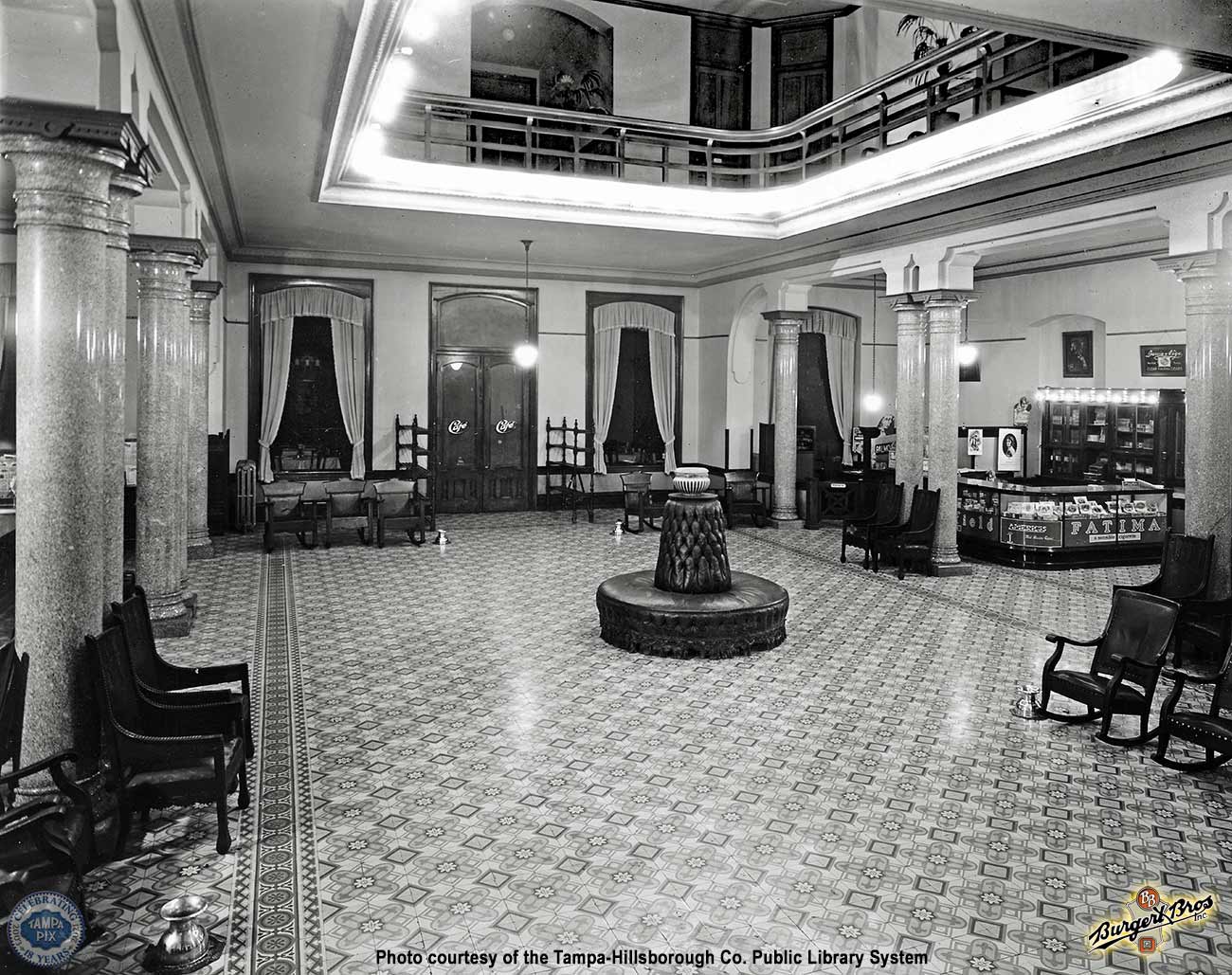
Below: a
close up
from the
above photo.
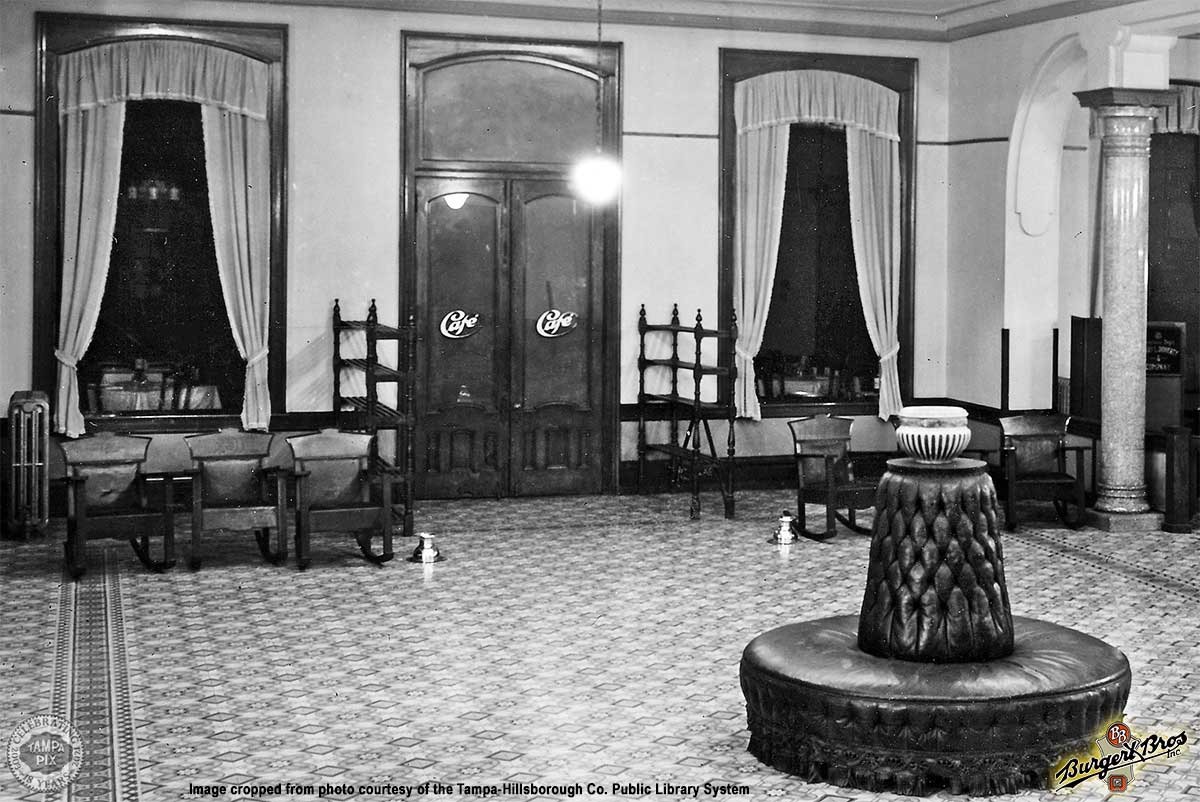
Notice the
brass
spittoons on
the floor
and tables
visible
through the
cafe
windows.
    
|
|
OLD DESOTO ANNEX BURNS FOUR TIMES IN LESS THAN A WEEK IN 1928
|
| Three suspicious fires broke out in the old DeSoto annex on Mar. 7, 1928. The article stated that the annex had been closed to guests for two and a half years and was being used for storerooms. This puts the closure around Sept. 1925. An employee named Bill Main who was occupying a room in the annex was questioned and denied any knowledge of the fires, but he was ordered held at the city jail anyway. The article appears to say that the third fire started over an hour after the first fire, and after the suspect had been locked up. The damage was estimated at $5,000 which in 2020 dollars would be $75,675. |
The suspect was released the next day when no evidence could be found against him. |
|
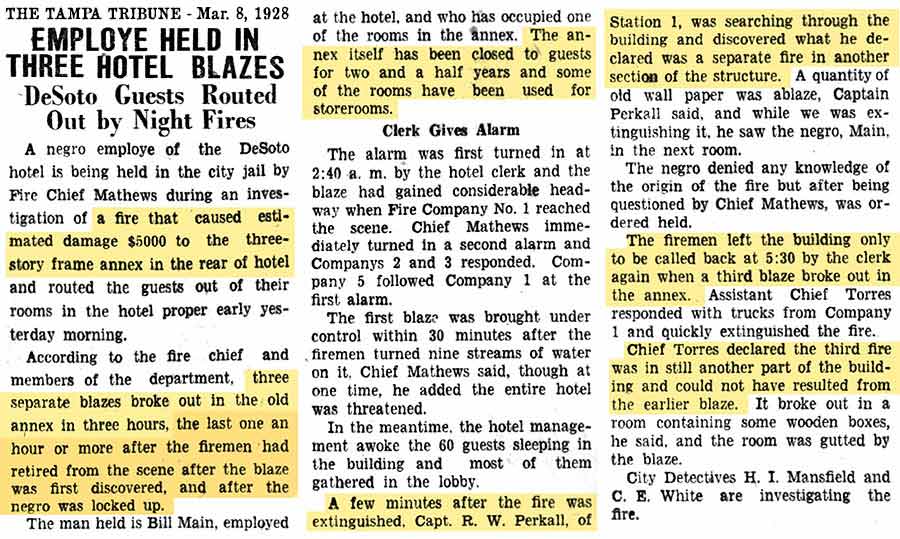
|
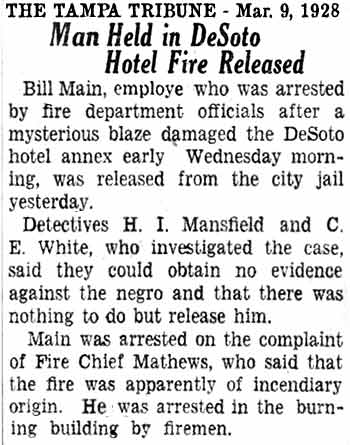 |
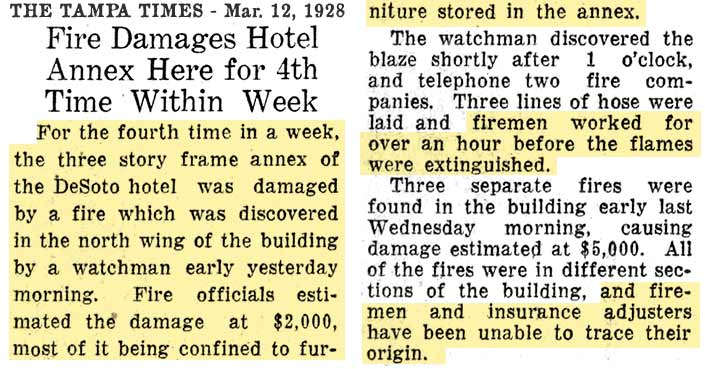
Just four days later, on Mar. 11, 1928, another fire started on the north end of the old annex, causing est. damage of $2,000. It tooke the firemen over an hour to put out the fire.
Most of the damage was confined to old furniture stored there. Firemen and insurance adjusters were unable to determine who was starting the fires.
Those $2,000 in 1928 would be like $30,270 in 2020. |
| |
|
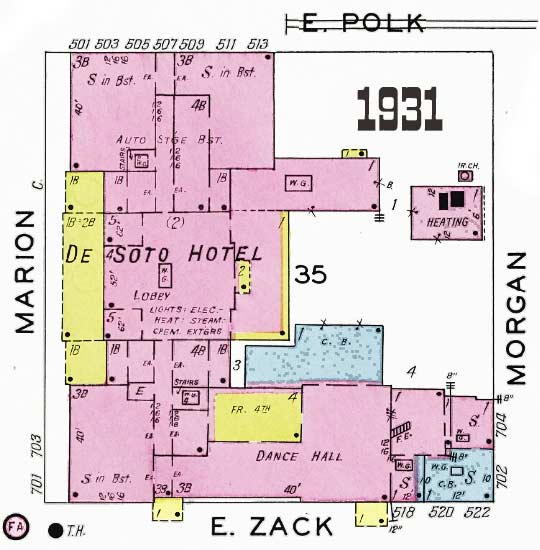
|
An Aug. 21, 1928 holdup at the DeSoto mentions that the two bandits "disappeared into an unused darkened annex and made their escape on Morgan St." after looting the cash drawer of $46.50. ($703 in 2020.) The 1931 Sanborn map at left shows that the old annex had been removed by this time, as well as some cement block additions (blue) and a brick addition to the north of the rear porch..
|
|
REAR VIEW
(MORGAN ST.
SIDE) OF THE
DESOTO
c.1936
Photo by
Robertson &
Fresh from
the USF
digital
collections
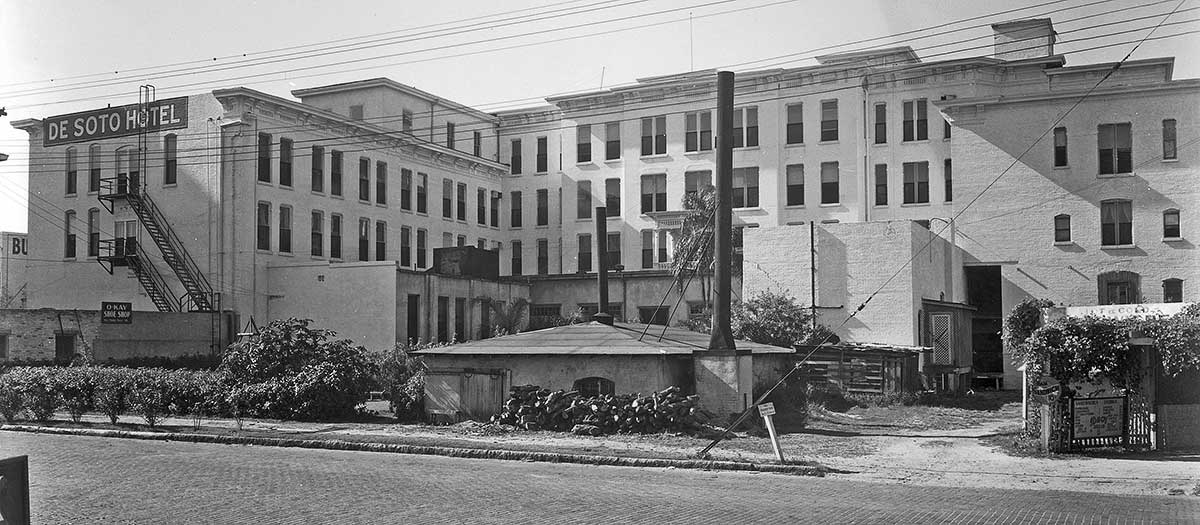
The sunken
building
with the
smokestacks
and firewood
is where the
hotel's
steam
heating
system was
located.
|
|
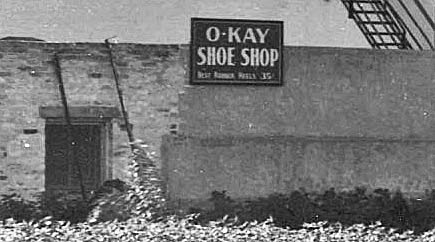
|
The photo is dated 1936 but might be from a few years earlier. The O-Kay Shoe Shop seen at left appears to have been in business from 1931 to 1933 judging by their ads in the classified section of the Tampa Times.
Nothing
could be
found about
the Hot &
Cold
sandwiches
shop.
|
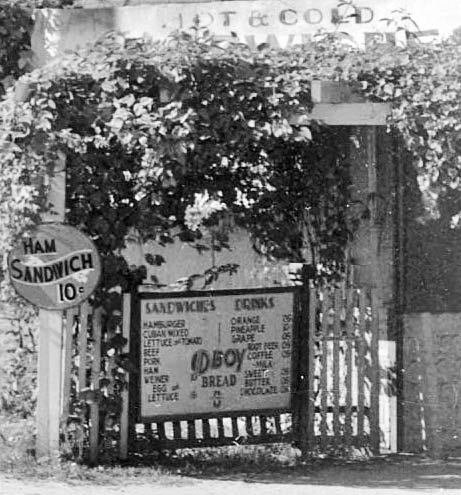 |
1936 - Main
entrance on
Marion St.
Photo by
Robertson &
Fresh from
the USF
digital
collections |
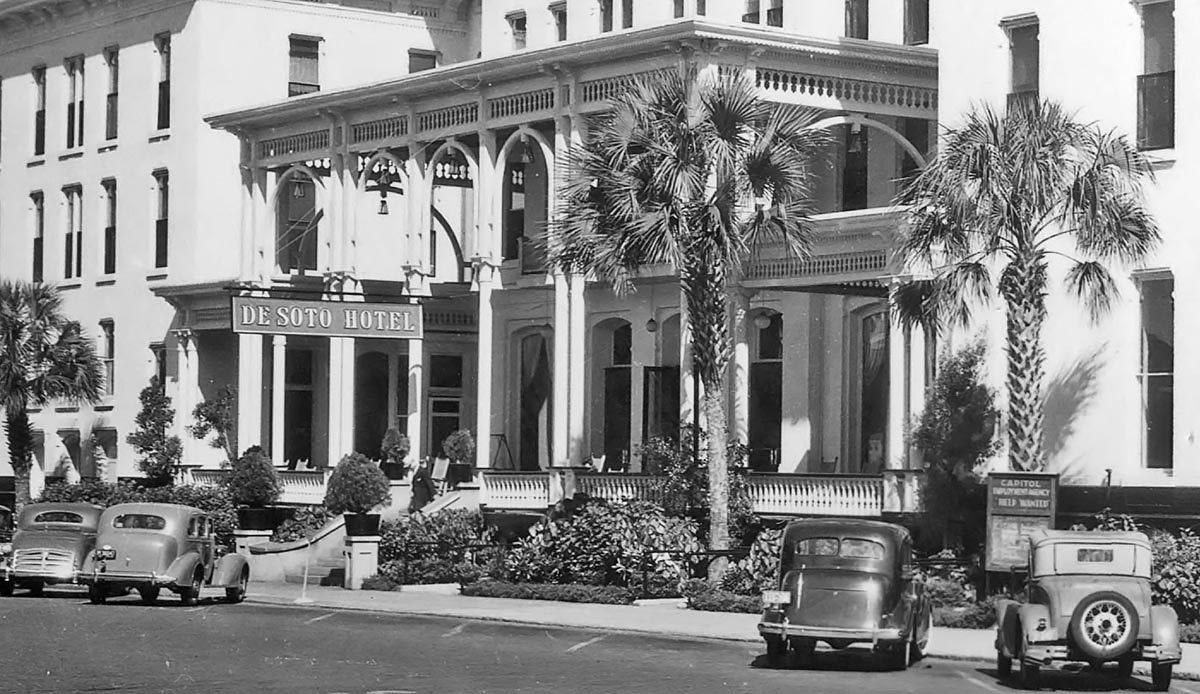 |
|
1936 - South
entrance,
Zack Street
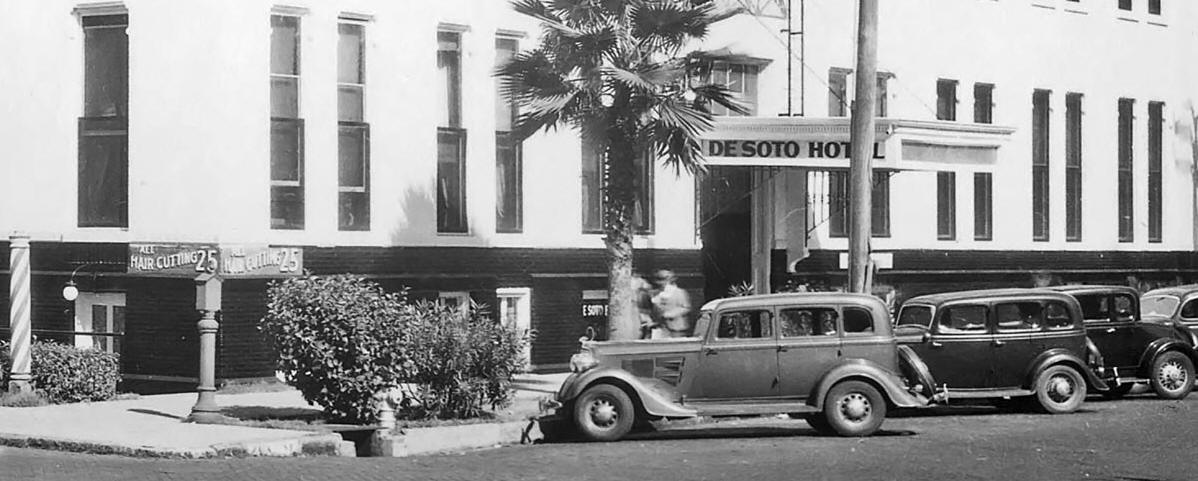 |
|
Photo by
Robertson &
Fresh from
the USF
digital
collections
1936 -
Rooftop sign
Place your
cursor on it
to switch it
on.
Photo by
Robertson &
Fresh from
the USF
digital
collections
 |
|
In 1937 the
DeSoto Tire
service
station
moved from
across
Morgan St at
715 Morgan
to their
location
behind the
DeSoto on
the corner
of Morgan
and Polk
streets.
This photo
appears to
be from the
early 1940s.
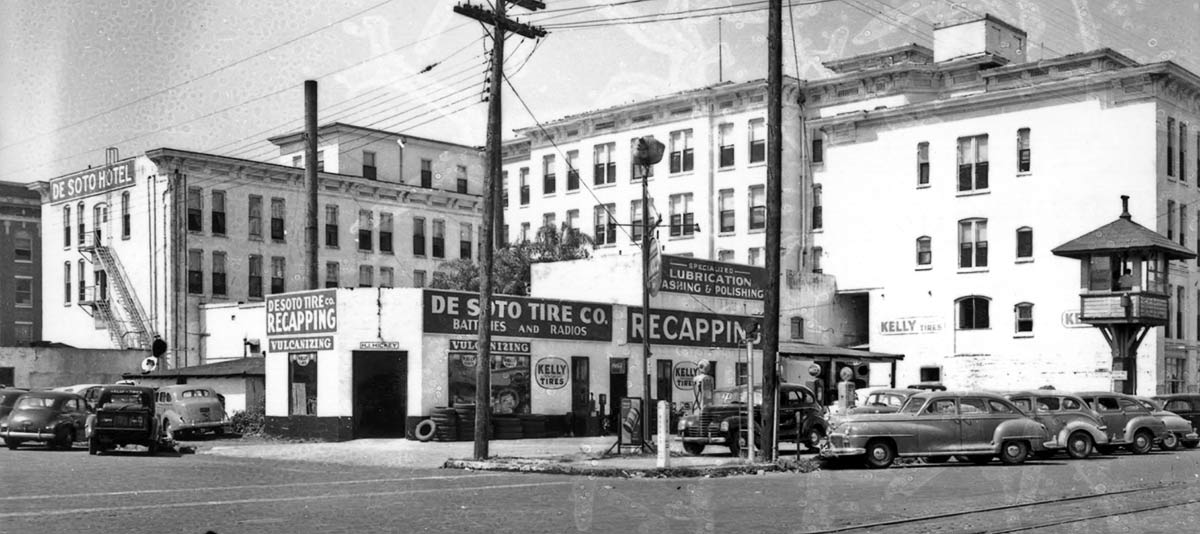
The hut on
top of the
pole seen at
right was
for the
railroad
lookout.
|
|
|
|
|
Nov. 4, 1946
- The Indian
Room Bar at
the DeSoto
Hotel |
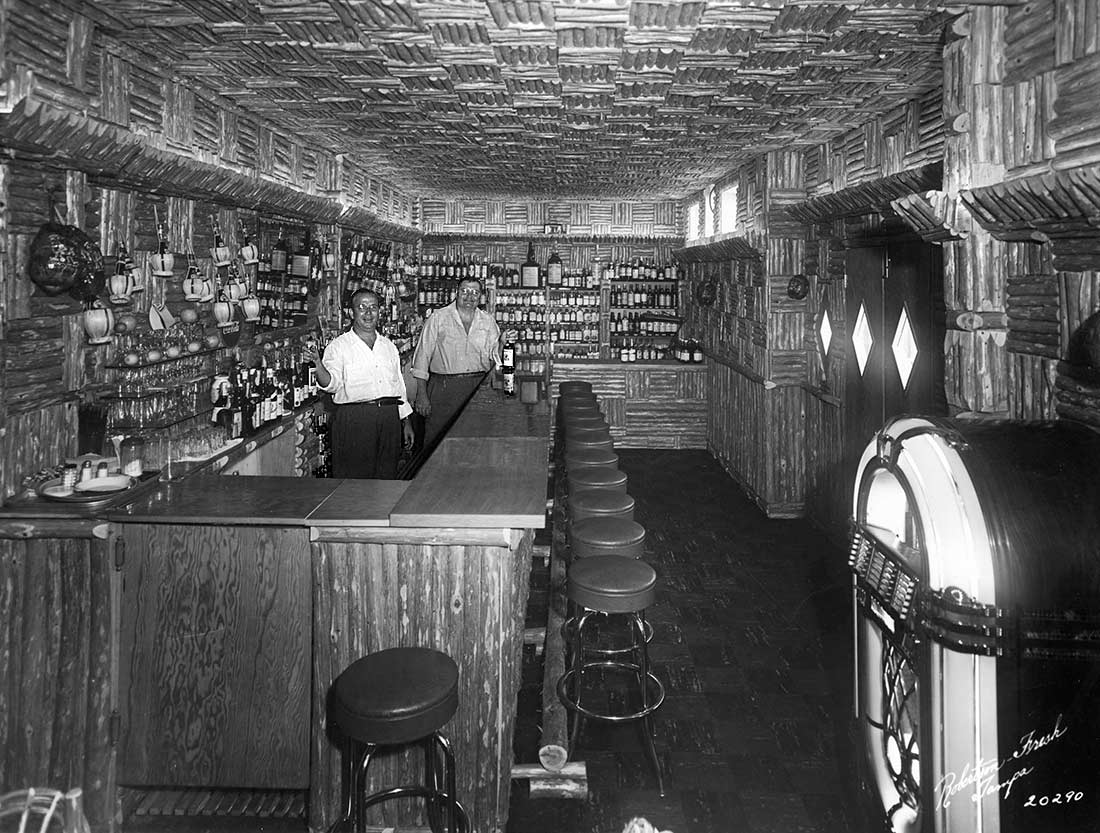 |
|
Photo by
Robertson &
Fresh from
the USF
digital
collections
1950 -
Entrance to
Indian Room
Bar & Grill
at 721
Marion
Street
Burgert
Bros., Tampa
Hillsborough
Co. Public
Library
digital
collection. |
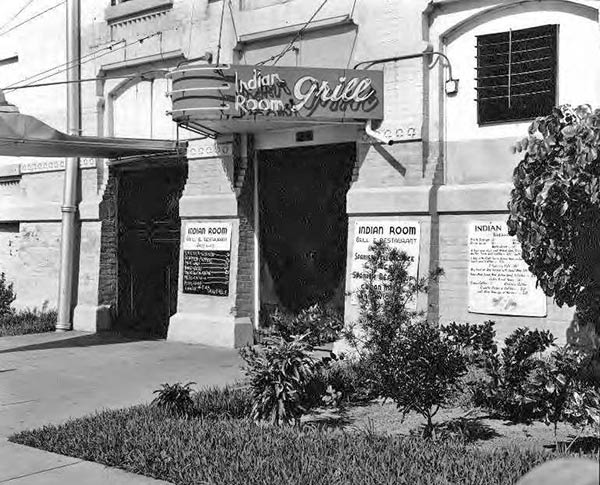
Nov. 4, 1946
- Lobby at
the DeSoto
Hotel
Photo by
Robertson &
Fresh from
the USF
digital
collections |
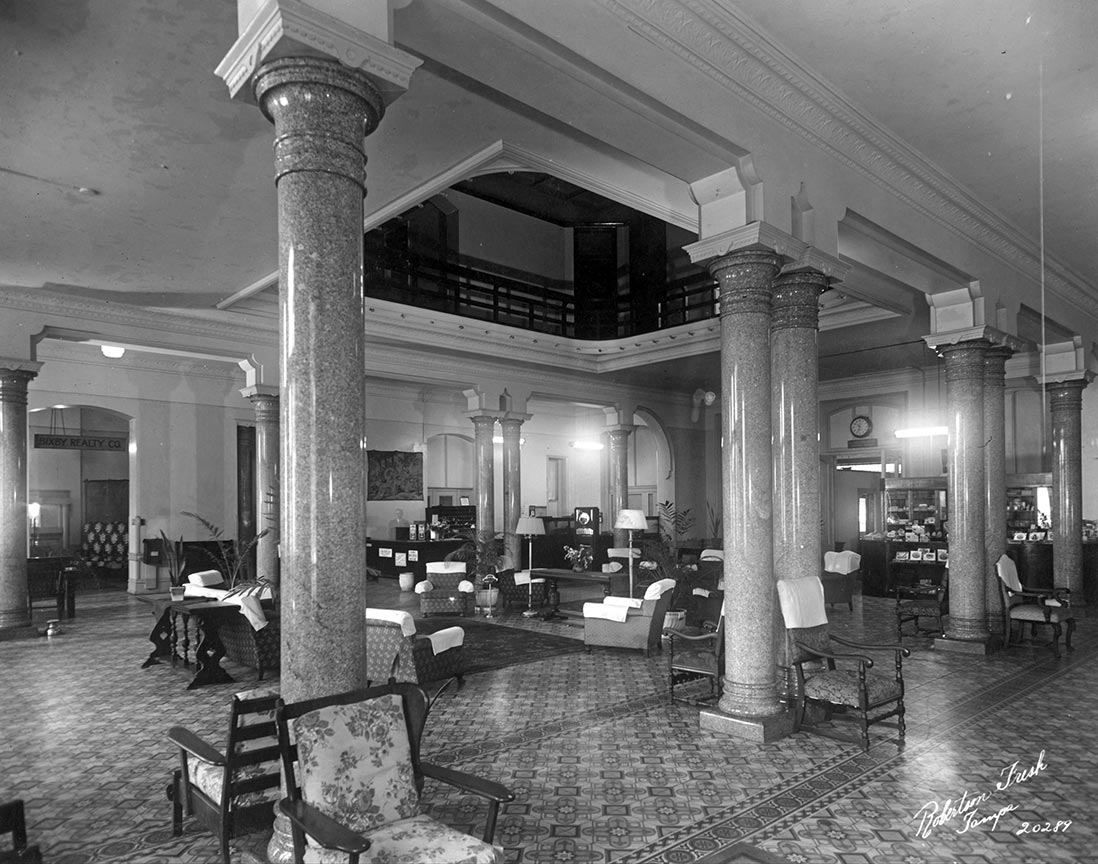
The ghost of
James H.
Thomas,
builder of
the first
DeSoto, who
died in his
room at that
hotel,
can be seen
behind the
front desk
at center of
the photo.
This is not
a Photoshop
effect by
TampaPix.
MOUSE OVER
THE PHOTO TO
SEE HIM
CLOSE UP
See the
actual
Robertson &
Fresh photo
at USF
Library and
zoom in. |
|
|
Nov. 4, 1946
- A view of
the DeSoto
from Marion
& Zack St.
looking
northeast.
Photo by
Robertson &
Fresh from
the USF
digital
collections |
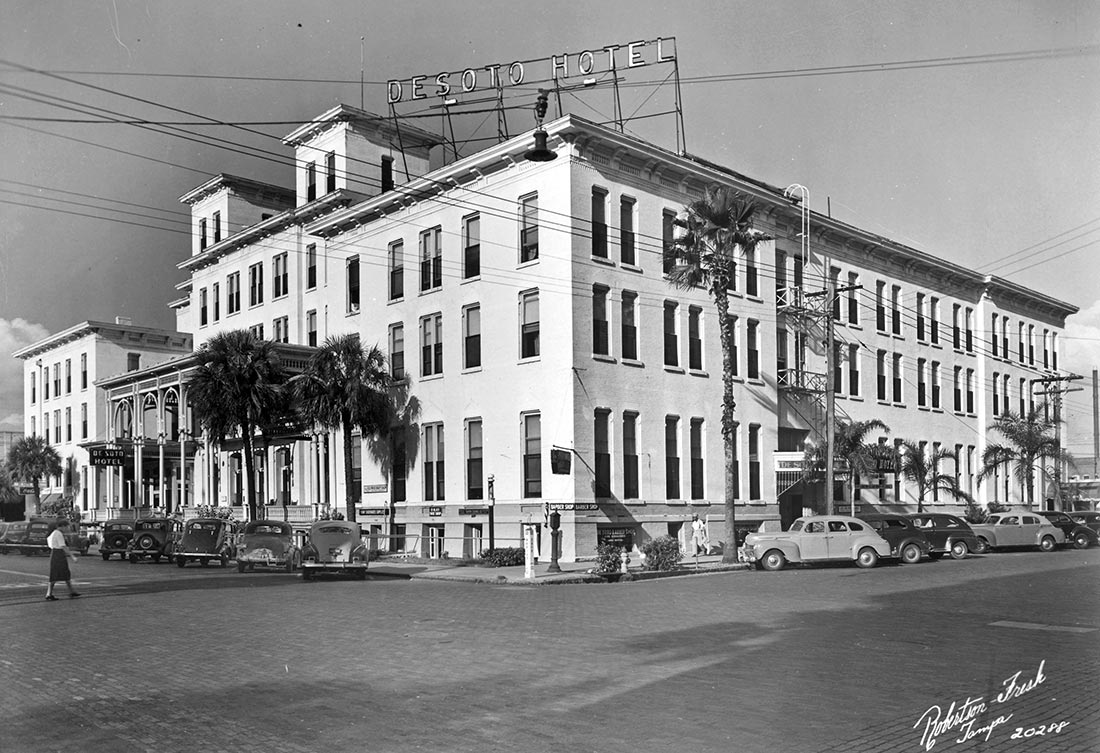 |
|
June 3, 1949
Burgert
Bros. photo
courtesy of
the
Tampa-Hillsborough
County
Library
System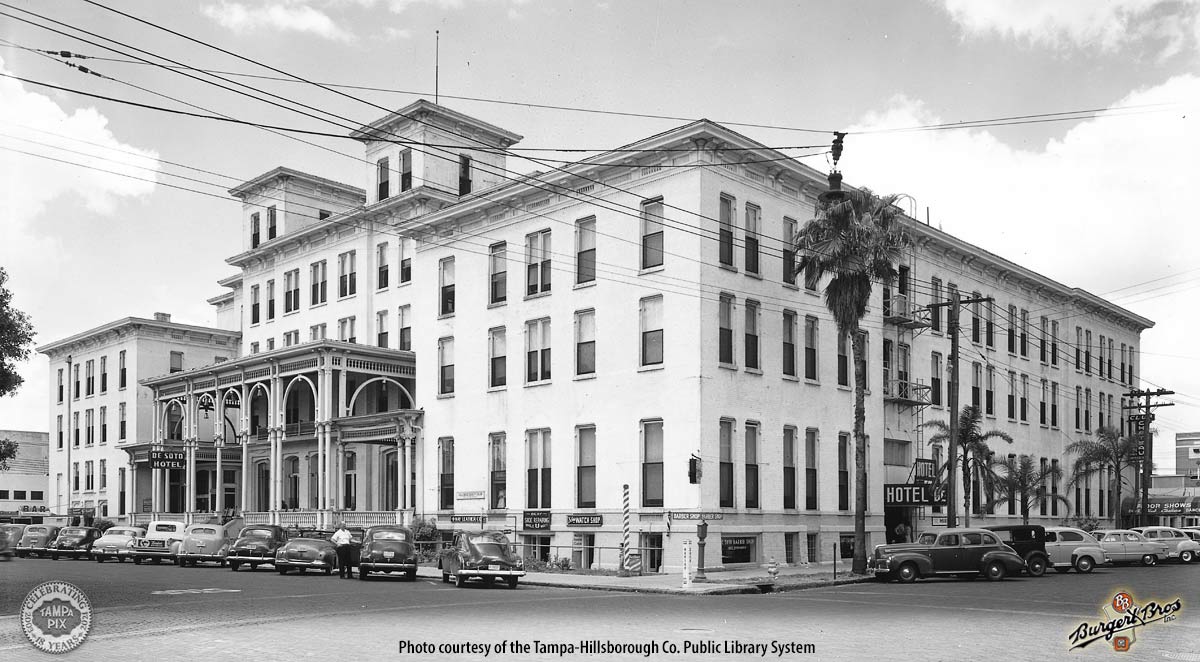
Notice the
rooftop sign
is gone.
Below, close
up of above
photo
showing the
various
shops.
Notice the
woman in the
window of
the
Hollywood
Beauty
Salon.
The OKAY
shoe repair
shop,
formerly
along the
Zack St.
Side near
Morgan St.
was now in
the front of
the hotel.
The barber
shop was
operated by
Mike
Sperandeo
(see window
sign) since
1912.
Read about
him below.
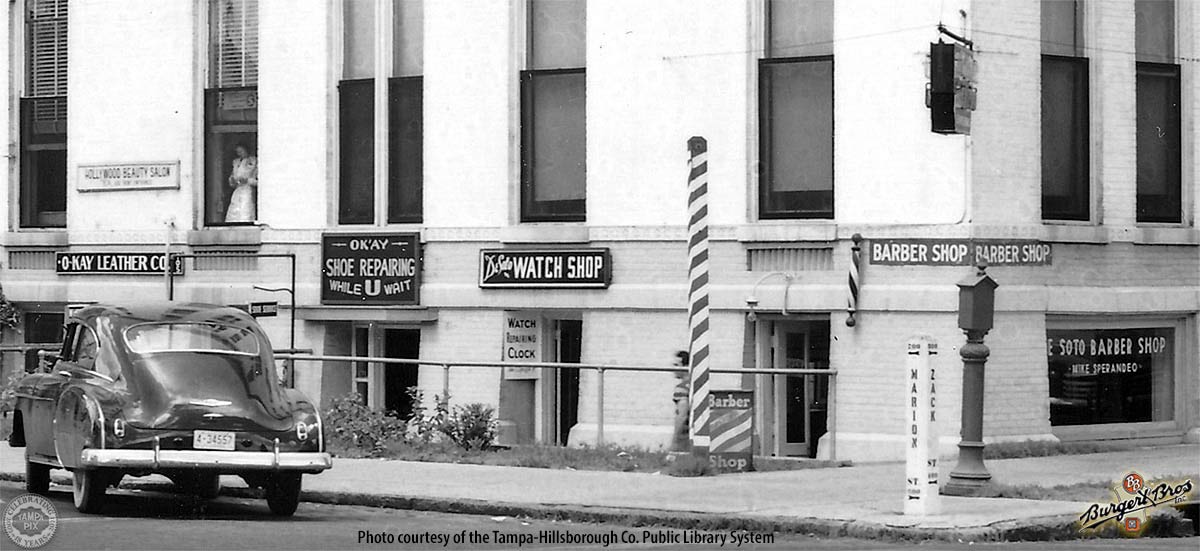
June 3,
1949.
Zack St.
entrance to
DeSoto Hotel
and Club
Chateau.
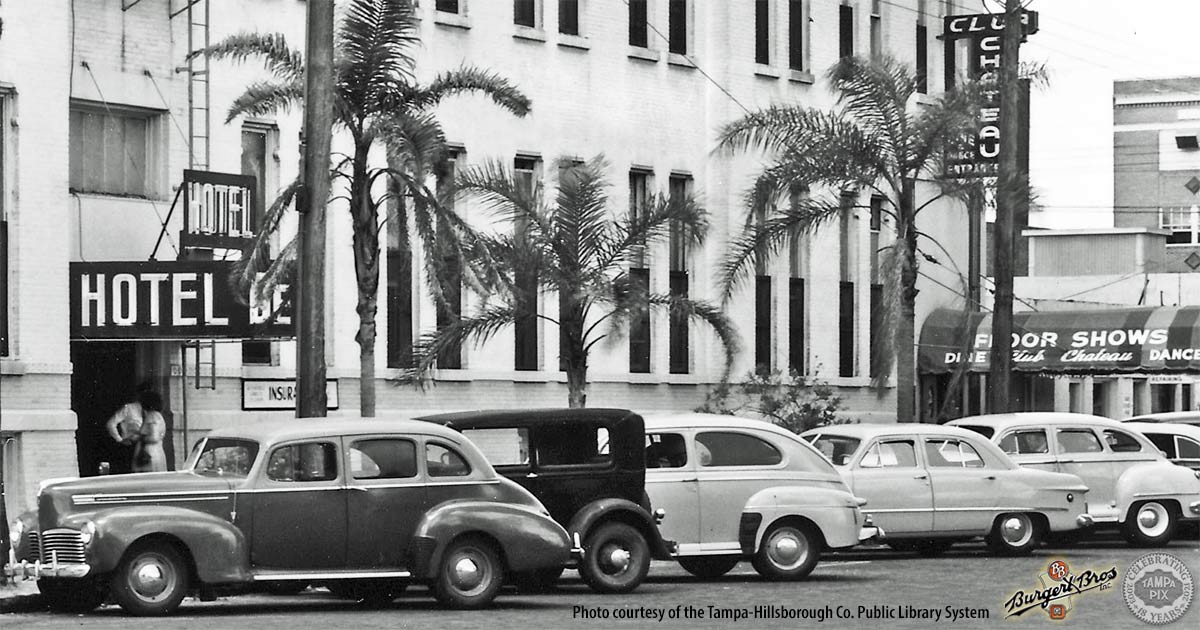
June 3,
1949.
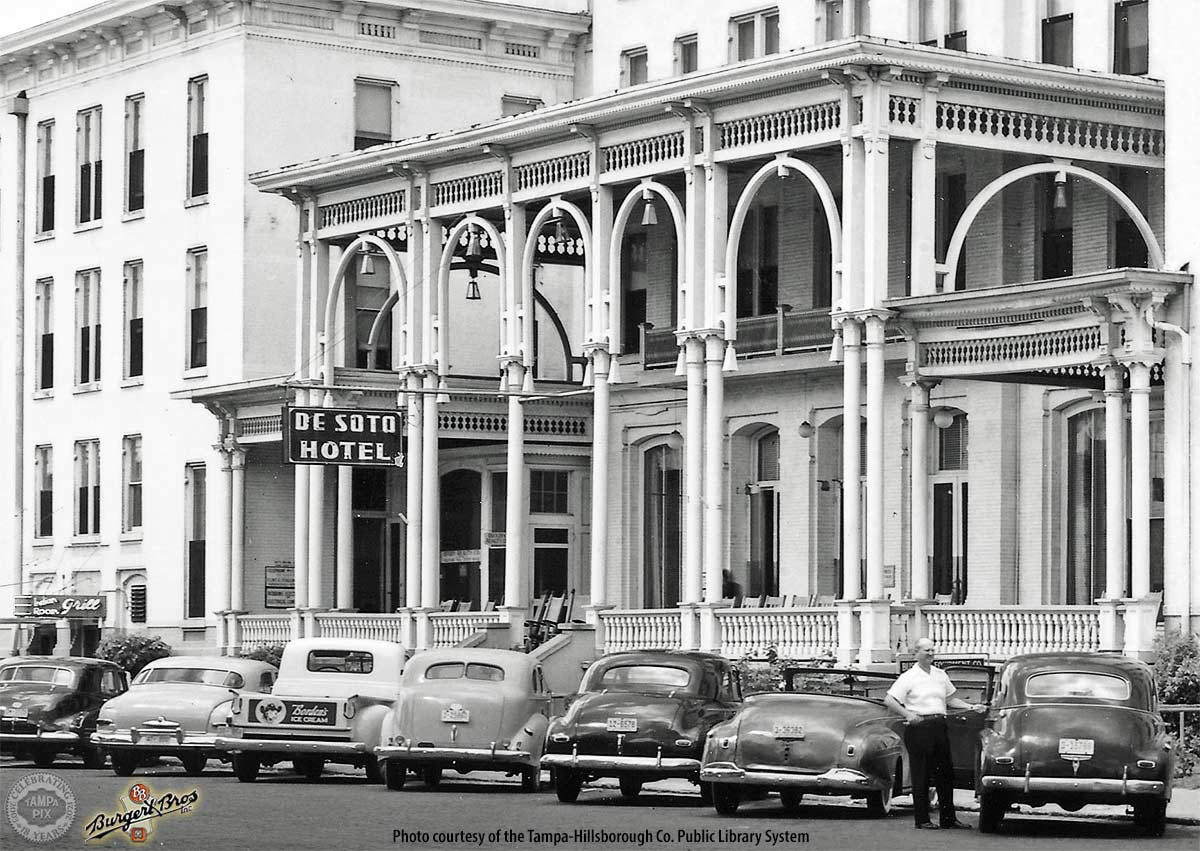
Front
veranda and
entrance to
the Indian
Room Grill
June 3,
1949. |
|

Elevated
view,
June 3,
1949.
Burgert
Bros., Tampa
Hillsborough
Co. Public
Library
digital
collection. |
|
THOMAS
EDISON SLEPT
HERE?
ON THE FLOOR
OF THE
DESOTO?
This April
6, 1955
article
broke the
news to
Tampa that
the nearly
50 year old
hotel
building
would soon
be leveled
to build a
parking lot.
Also, here appears for apparently the first time the mention of Thomas Edison reportedly spending the night on the floor of the DeSoto, due to lack of vacancy. Perhaps this was circulated for many years as Tampa folklore. Brief searching for Edison in Tampa has found no result, but there is brief mention of his father, Samuel Edison, being in Tampa in April 1892.
|
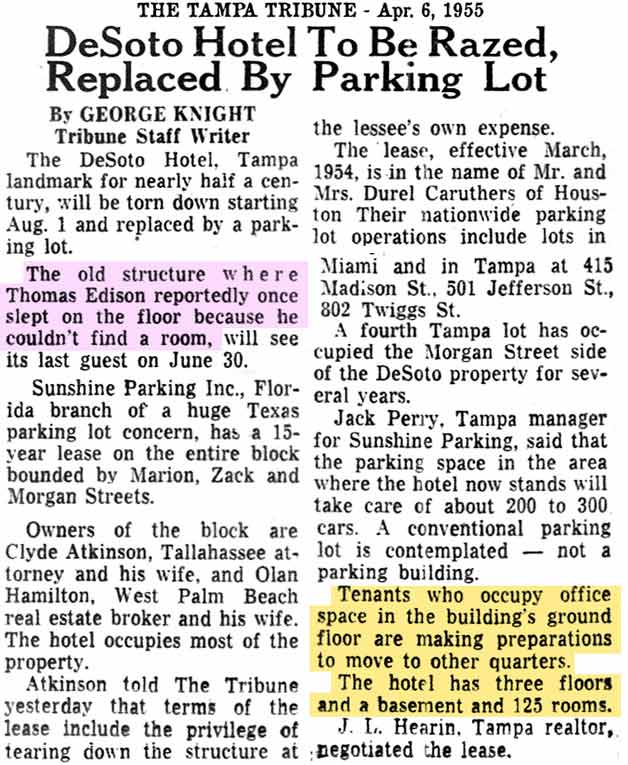
|
|
SO DID THIS
REALLY
HAPPEN?
Tribune
staff writer
George
Knight's
article
below
describes
barber Mike
Sperandeo
who was
planning to
retire when
the old
hotel
building
closed.
He had spent
43 years at
his shop in
the basement
of the
DeSoto--since
1912--having
come to Tampa
from Italy
in 1907.
Knight says Sperandeo
remembered
when gospel
revival
preacher
Billy Sunday
"shook the
roof of the
ballroom"
with his
revivalist
chanting,
and a visit
by Mrs.
Foster, who
at the time
was a sister
of the US
Sec. of War
during WW1.
|
|
|
"And then
there is the
story about
Thomas
Edison"
(apparently
not from Sperandeo's
memory)
which claims
that Edison
waited in
the lobby
for hours
one evening
while clerks
"searched
frantically
for a room,
but to no
avail."
Eventually,
"a friendly
guest
offered to
share his
room if the
distinguished-looking
visitor
would use a
mattress on
the floor."
He ends the
story
stating that
it wasn't
until the
next morning
that the
visitor
introduced
himself as
Thomas
Edison.
Knight also
discusses
when the
present
structure
was built,
stating most
say 1907,
which is
correct but
that's when
construction
started.
It took a
few years in
phases to
complete.
The reporter
also claims
that the old
wooden
structure it
replaced was
built in the
late 1890s
by H. B.
Plant.
(Not so for
both.)
This was
may have
based on the
writings of
historian
Karl Grismer,
whose
history of
Tampa was
recently
published in
1950.
Not only was Grismer
incorrect on
its builder,
he assumed
that its
architect,
J. A. Wood
(architect
of the Tampa
Bay Hotel
and county
courthouse)
built it
with Moorish
domes.
Clearly not
the case.
He also
mentions a
number of
modern-day
ownership
changes
which
haven't been
verified by
TampaPix.
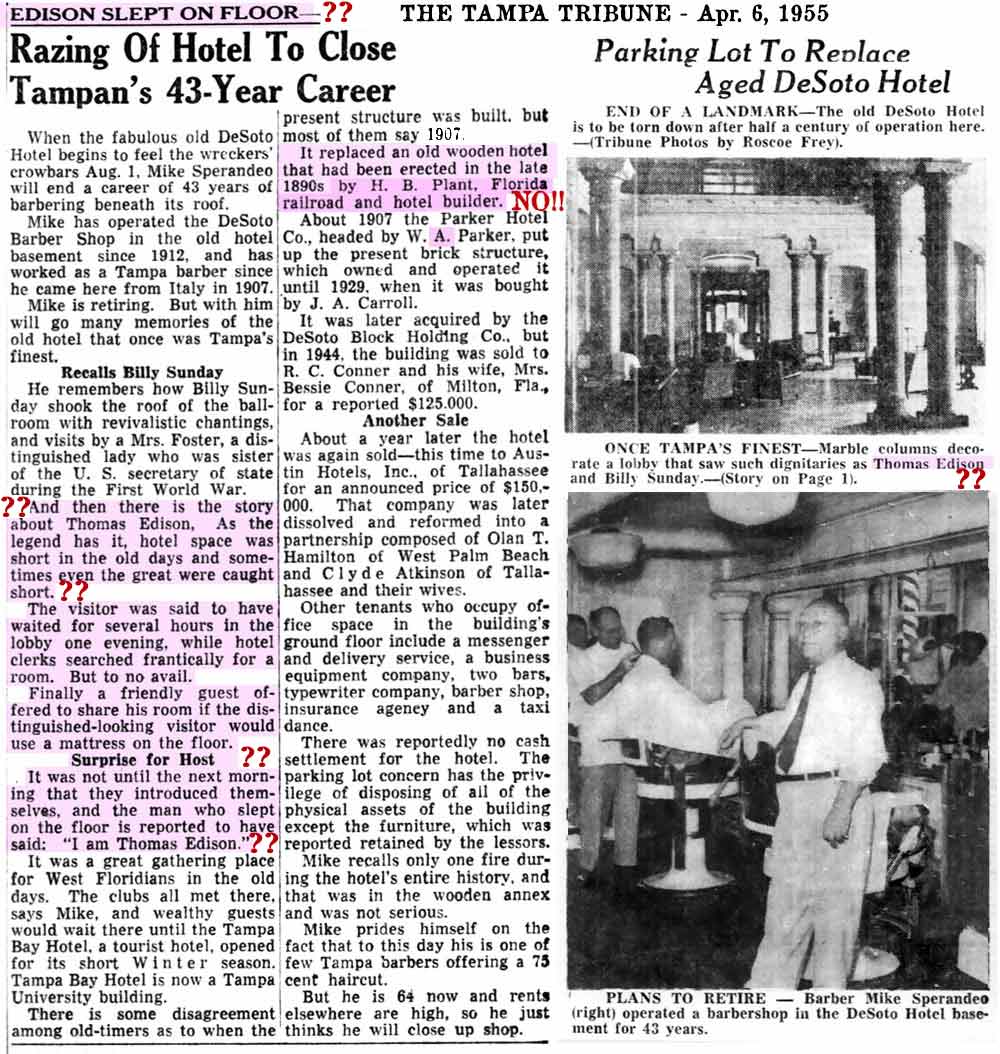
JUDGE W. C.
BROOKER SAYS
HE'S HEARD
THIS STORY,
NAMES THE
HOSPITABLE
GUEST BUT
DIFFERENT
HOTEL
County Judge
W. C.
Brooker read
Knight's
story above
and wrote
the Tribune
to say that
the Edison
incident
took place
at the
Almeria
Hotel, not
the DeSoto.
Judge Brooker's
account was
from his
memory
of his
1922 dinner with
John Sutton
and Herbert
J. Drane. Drane was a
congressman,
and Brooker
claimed that
Drane told
him and
Sutton about
the time
Edison slept
on a pallet
in Drane's
room in a
Tampa hotel
on Franklin
St. He
further
stated that Drane
claimed it
took place
around 1885,
and to
Brooker's
memory the
Almeria
Hotel was
open in that
time, which
was also the
period that
Edison was
perfecting
his light
bulb, and
that "Almeria"
was the name
of the hotel
Drane
mentioned.
Judge
Brooker's
memory also
recalled
that Drane
said he was
asked by the
hotel
manager if
he would
allow this
man to
occupy his
room.
Agreeing, a
mattress was
brought in
and placed
on the
floor.
The next
morning, the
man made an
inquiry
concerning
passage to
Ft. Myers
and it was
then that
Drane
learned it
was Thomas
Edison.
So at the
time Brooker
was having
lunch with
Drane,
Drane's
memory of
the event
was 37 years
old, and now
in 1955,
Brooker was
recalling a
33 year old
memory of
the 1922 lunch with Drane.
He ends with
"This story
made a deep
impression
on me and
except for a
few details
it has
remained
vividly in
my mind ever
since.
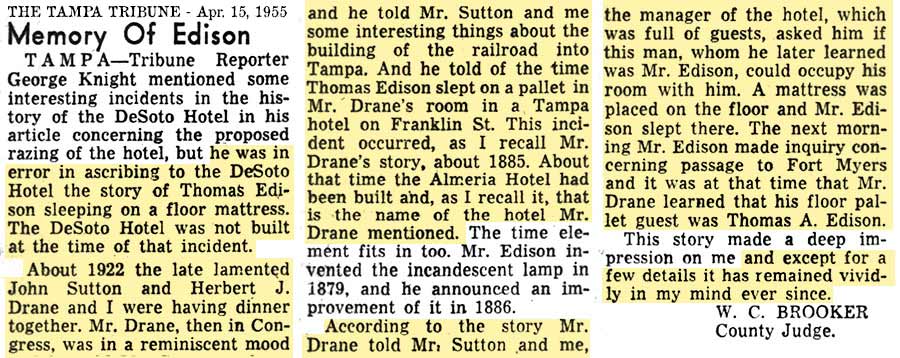
HISTORIAN THEODORE
LESLEY
PROVIDES
THE REAL
STORY
Theodore
Lesley wrote
the Tribune
in May 1955,
having read
the previous
story by
Knight and
the
resulting letter
by Judge Brooker.
Lesley was a
grandson of
Tampa
Pioneer John
T. Lesley,
whose civic,
business,
and
political
contributions
to Tampa's
early
history are
far too many
to
summarize.
Theodore
Lesley was
Tampa's
highly-regarded
historian,
having lived
much of the
period of
the later
pioneer
days.
He opened
with his
view of the
previous
article and
letter, and
three
reasons why
they couldn't be
correct.
-
Lesley
heard
it
straight
from Drane
who said
it
happened
at the
Orange
Grove
Hotel in
Feb.
1884.
-
The
Almeria
Hotel
had not
yet been
built in
1884
when
Edison
was in
Tampa.
-
With him
and
Drane
was a
daughter-in-law
of Dr.
Howell
Lykes
and his
wife
Almeria
McKay
Lykes,
who
would
have
spoken
up had
it
happened
at the
Almeria.
Lesley
provided a
detailed story,
with details
not
mentioned in
the previous
articles.
He told the
story as he
got it
straight
from U.S.
Congressman
Herbert J. Drane, who
was a "warm
personal
friend of my
grandfather,
John T.
Lesley."
Lesley
commented
from notes
he took in
1940** when he
met with Drane at a
convention
in Ft.
Pierce. With them
was Mrs. H.
T. Lykes,
daughter-in-law
of the
builder of
the Almeria
Hotel.
**1940 was
55 years
after the
Edison
incident,
but Lesley
is referring
to notes he
took at the
time,
whereas
Judge
Brooker was
relating
from memory.
This leaves
the
possibility
that Drane's
account was
the same
both times,
but that
Brooker's
memory of it
changed over
time.
Lesley
stated, "The
following is
an abstract
of
Congressman Drane's
reminiscence
of the
Edison
episode.
It is
presented in
this form
because in
the
Congressman's
own words it
would be too
long to
record
here."
"In
February
of 1884
Drane
was on a
trip
from
Lakeland
to
Tampa.
As this
was just
following
the
advent
of H. B.
Plant's
railroad
into
Tampa,
the town
was in
the
throes
of a
boom and
rooms
for
tourists
were at
a
premium.
Drane
realized
this and
got off
the
train at
its
first
stop
east of
the city
limits
and
hurried
on foot
to the
Orange
Grove
Hotel
located
on the
block
bounded
by
Twiggs,
East,
Madison
&
Jefferson
Streets..
Sheriff
D. Isaac
Craft
was then
proprietor
of the
hotel
and
assigned
Drane a
room on
the
second
floor.
It was
not long
before
he knew
he was
to have
a
roommate
and a
mattress
was
brought
in and
placed
on the
floor
for the
newcomer.
As his
roomer
was
deaf,
little
conversation
passed
between
the two
and
Drane
did not
catch
his
name.
Next
morning,
Judge
Henry L.
Mitchell,
later
Governor
of
Florida,
and at
that
time a
year-round
resident
at the
hotel,
stopped
Drane
and
asked
him if
he knew
who the
man was
that was
just
leaving
the hall
entrance.
Drane
replied
it was
his
roommate
but
didn't
know his
name.
Judge
Mitchell
convinced
Drane
that he
was
justified
in
thinking
him a
"suspicious
character,"
and
asked
that he
follow
him and
find
what he
was up
to in
Tampa.
Later in
the day,
Drane
reported
back to
Judge
Mitchell
that
their
"character's"
name was
Thomas
Edison
and that
he had
just
hired a
fisherman's
boat on
the
Hillsborough
River to
deliver
a cargo
of Maine
pine
lumber
to Ft.
Myers
that he
had
consigned
to this
port
some
weeks
before.
This
lumber
was
delivered
in time
to Ft.
Myers
and
erected
into the
laboratory
where
Edison
proved
and
released
to the
world
many of
his
famous
inventions."
Notice that
Lesley has
provided the
reason why
there were
no rooms
available;
why Tampa
was so
filled with
visitors at
the time,
who owned
the Orange
Grove Hotel
at the time,
what floor
the room was
on, why the
two men had
little or no
conversation,
who met
Drane in the
lobby, and
specific
detail on
how it was
discovered
that the
guest was
Thomas
Edison,
where he was
going, and
why he was
there.
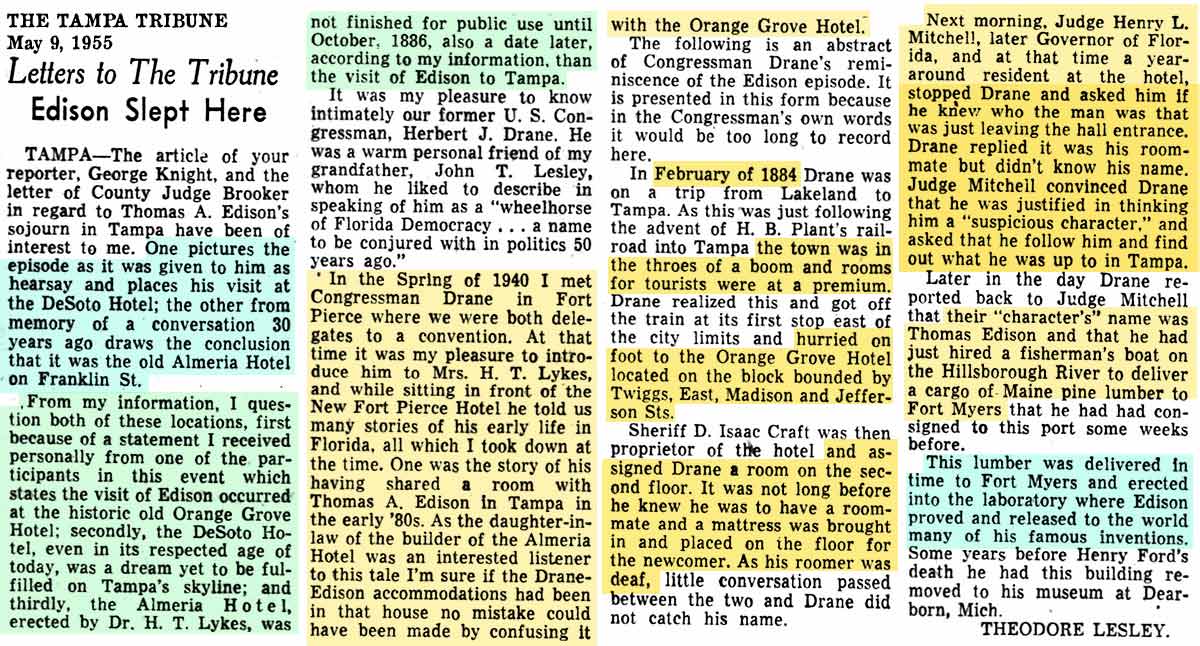
|
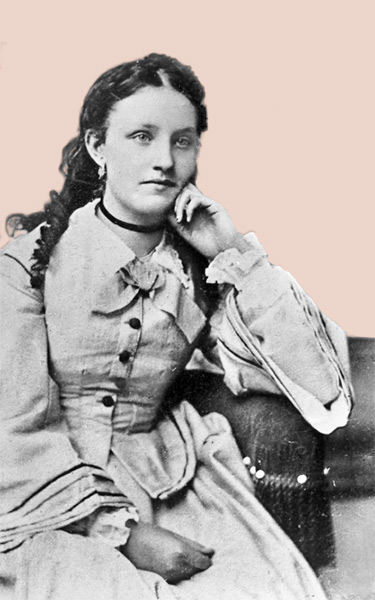
|
|
Mary Stilwell c1871
Image courtesy of the Thomas Edison National Historic Park on Facebook |
THOMAS A.
EDISON IN
THE 1880s
One of the
most tragic
events of
Edison's
life was the
death of his
first wife,
Mary
Stilwell
Edison, at a
young age.
Mary died at
age 28 on
Aug. 9,
1884.
A newspaper
article
titled, "In
the Wizard's
Home," by
Olive Harper
from New
York World (June 1,
1884) tells
of their
first
meeting
which
contradicts
the
often-told
story of her
courtship
with Edison,
gilded as a
whirlwind
affair
between the
inventor and
one of his
factory
employees.
As Mary
tells it,
she was a
schoolgirl
of fifteen
at the time
of their
first
meeting, but
tall for her
age. She met
Edison by
chance when
she took
refuge in
one of his
factories
during a
rainstorm.
She noticed
Edison for
"two reasons
… he had
very
handsome
eyes… and he
was so
dirty, all
covered with
machine oil,
etc." Edison
walked her
home and
visited with
her family.
At first,
Mary was the
reluctant
object of
his
affection,
but with her
father's
permission,
they began
courting in
the spring
of 1871 and
were married
on Christmas
day that
year.
She was 16,
he was 24.
(Courtesy
of the
National
Endowment
for the
Humanities,
"Heartbreak
at Menlo
Park" by
Jason
Boffetti)
| "...When we got to the house I saw that he was determined to go in and I had to invite him, and when my mother came down she asked who that was. I told her and said that he had brought me home and she [sic] went in. I was in mortal terror lest she ask him to stay, but she did, and then he got up and took off his overcoat and stayed till 9 o'clock., and then when he went away he asked permission of my mother and myself to call again. When he got it he availed himself of it to come almost every evening..." |
|
CLICK THE
ARTICLE TO
READ IT ALL
|
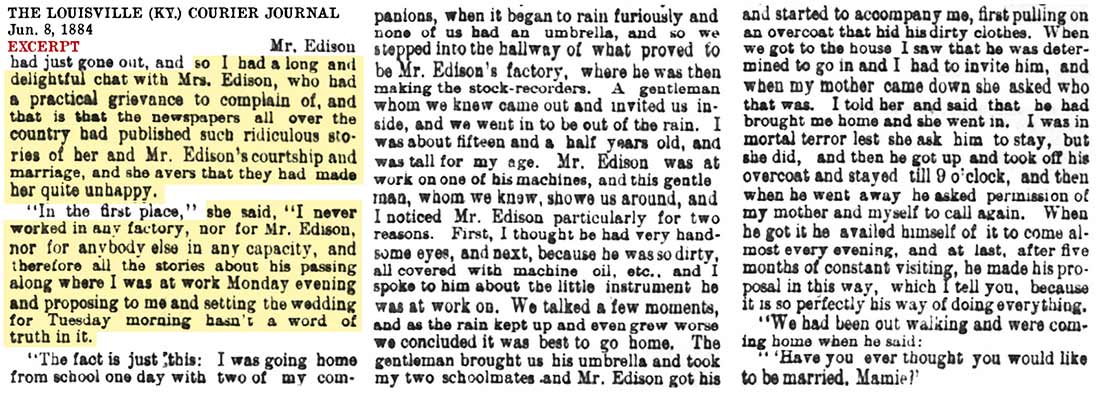
|
Thomas and
Mary Edison
had three
children:
- Marion Estelle Edison (1873–1965), nicknamed "Dot"
- Thomas Alva Edison, Jr. (1876–1935), nicknamed "Dash"
- William Leslie Edison (1878–1937) Inventor, graduate of the Sheffield Scientific School at Yale, 1900.
|
|
| In 1878, Edison focused on inventing a safe, inexpensive electric light to replace the gaslight–a challenge that scientists had been grappling with for the last 50 years. With the help of prominent financial backers like J.P. Morgan and the Vanderbilt family, Edison set up the Edison Electric Light Company and began research and development. He made a breakthrough in October 1879 with a bulb that used a platinum filament, and in the summer of 1880 hit on carbonized bamboo as a viable alternative for the filament, which proved to be the key to a long-lasting and affordable light bulb. In 1881, he set up an electric light company in Newark, and the following year moved his family (which by now included three children) to New York. Though Edison’s early incandescent lighting systems had their problems, they were used in such acclaimed events as the Paris Lighting Exhibition in 1881 and the Crystal Palace in London in 1882. In 1882 Nikola Tesla moved to Paris to work as an engineer for the Continental Edison Company, designing improvements to electric equipment brought overseas from Edison's ideas. Competitors soon emerged, notably George Westinghouse, a proponent of alternating or AC current (as opposed to Edison’s direct or DC current). By 1889, AC current would come to dominate the field, and the Edison General Electric Co. merged with another company in 1892 to become General Electric Co. |
|
|
CORRECTION ON LESLEY'S
ALMERIA
HOTEL
OPENING DATE The Almeria Hotel was one of Tampa's leading hotels for several years. But it was built in late Dec. 1889, and opened in Jan. 1890, not Oct. 1886.
|
|
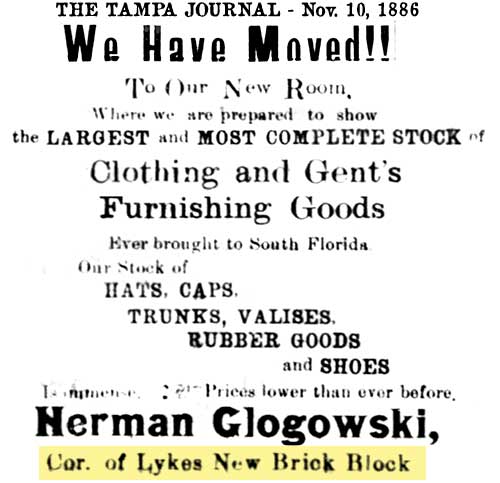
Glogowski was four-time mayor of Tampa, Florida in the later 1880s and early 1890s. He was first elected mayor on August 13, 1886, and served until July 15, 1887. He was elected again to a second term on March 8, 1888, and served until March 6, 1889. He was re-elected two terms and served from March 5, 1890, to March 4, 1891, and from March 4, 1892, to March 10, 1893. He was killed in a tragic horse and buggy accident in Tampa on December 3, 1909. 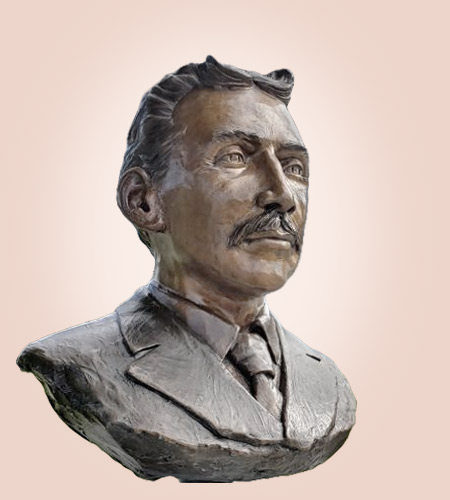
Tampa Riverwalk Bust of
Herman Glogowski
|
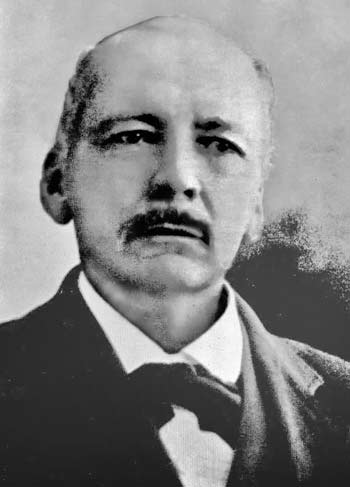 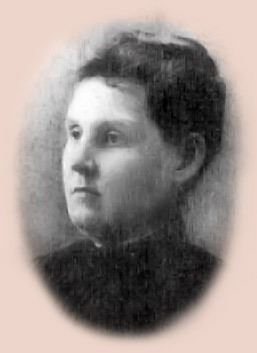 It
was the
Lykes BLOCK
that was
built in
Oct. 1886. Newspaper
articles of
the period
indicate
this, as
well as the
Sanborn maps
seen below.
(Karl
Grismer also
incorrectly
states the
Almeria
opened Oct.
29, 1886.)
Later, the
hotel would
take over
the upper
floor of the
adjacent
Lykes block
brick
building. It
was the
Lykes BLOCK
that was
built in
Oct. 1886. Newspaper
articles of
the period
indicate
this, as
well as the
Sanborn maps
seen below.
(Karl
Grismer also
incorrectly
states the
Almeria
opened Oct.
29, 1886.)
Later, the
hotel would
take over
the upper
floor of the
adjacent
Lykes block
brick
building.
In late 1889
to early
1890, Lykes
had the
hotel built
behind the
brick
buildings of
the Lykes
block, and
had the two
connected
with stairs
and hallways
to the top
floors of
the older
building,
thus
becoming
part of the
hotel.
Dr. Howell
T. Lykes
named the
hotel after
his wife, Almeria Bell
(McKay)
Lykes.
She was a
daughter of
Tampa
pioneer
James McKay.
(Dr.
H. T. Lykes
photo
courtesy of
Fla. Memory
State
Library and
Archives of
Florida.
Mrs. Almeria
Lykes photo
courtesy of
the
Hernando Sun
"Mama Allie."
Below:
May 9, 1889 - The first mention of Lykes possibly building a hotel on the Lykes Block but still undecided.
Nov. 28, 1889 - Work is progressing on the brick laying for the Lykes hotel.
These articles show that construction on the Almeria, which was yet to be named, probably started in July 1889 continuing through to Dec. of 1889. In December Lykes petitioned the city to allow him to lay an underground sewer line from his hotel to the river, which was granted so long as he paid the City Engineer personally while the work was being done.
|
|
Plans for
Lykes's
hotel were
drawn in
early May,
but it was
late Jun.
when Lykes
decided to
go ahead
with it.
The hotel
would be
built behind
the brick
building on
the Lykes
block and
joined to
it,
converting
it into
hotel space
as well.
 |
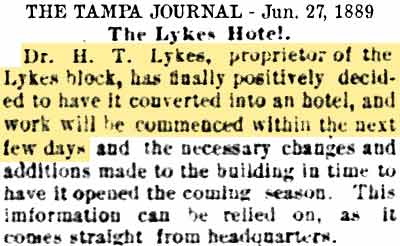 |
|
 |
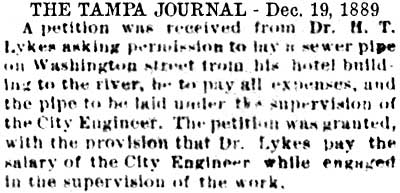 |
TRANSITION
OF THE LYKES
BLOCK FROM
1887 TO 1892
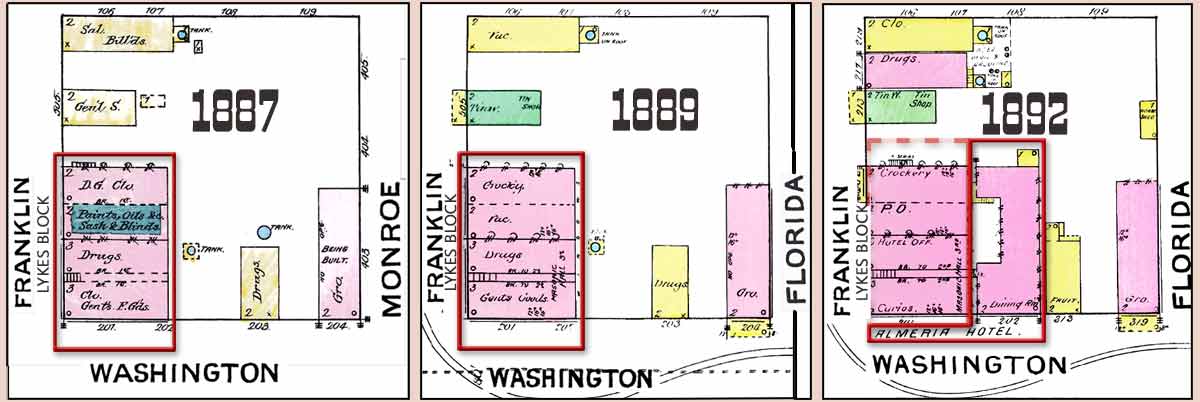
BELOW: This
1913 Burgert
Bros. photo
from the
Tampa
Hillsborough
Co. Public
Library
System shows
the Lykes
Block at
lower left
corner.
This is a
view looking
south along
Franklin St.
and the
intersection
at the Lykes
Block is
Washington
St.
MOUSE-OVER
THE PHOTO TO
SEE THE
LYKES
BLOCK/FORMER
ALMERIA
HOTEL LARGER
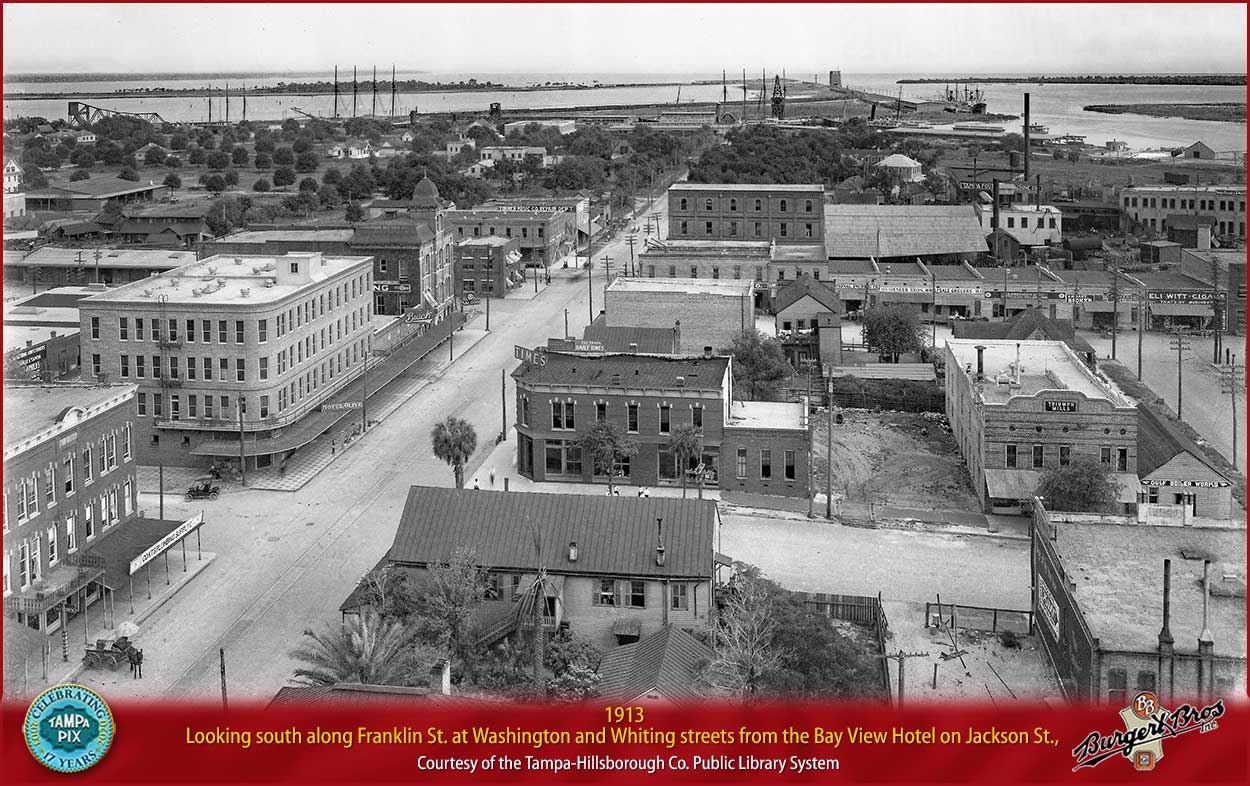
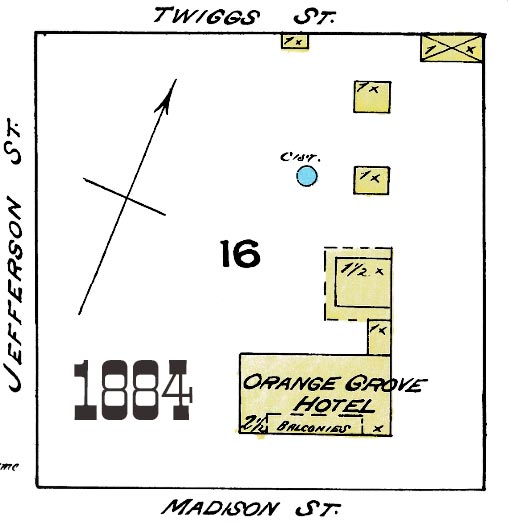
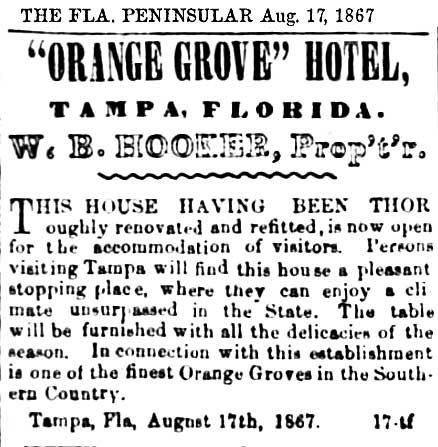 THE
ORANGE GROVE
HOTEL THE
ORANGE GROVE
HOTEL
WHERE THOMAS
EDISON SLEPT
ON "THE
FLOOR"
The Orange
Grove Hotel
was located
near the
present day
intersection
of Madison
St. &
Jefferson
St. The
hotel was
built in
1859 as the
home of
cattleman
William B.
Hooker,
Florida's
pre-Civil
War "cattle
king."
During the
Civil War,
it was used
as
confederate
headquarters
and was where
Tampa
pioneer Joe
Robles
reportedly marched his
captive
Union
soldiers to in
the winter
of 1863.
In 1866-67,
Hooker
converted
the home
into a
hotel. Judge
Henry L.
Crane and
his wife
(Hooker's
daughter) operated
the hotel,
then later, the
hotel was
run by Isaac
Craft.
LEARN MORE
ABOUT THE
ORANGE GROVE
HOTEL, AND
THIS PERIOD
IN TAMPA
HISTORY,
here at
Tampapix
THOMAS
EDISON SLEPT
HERE
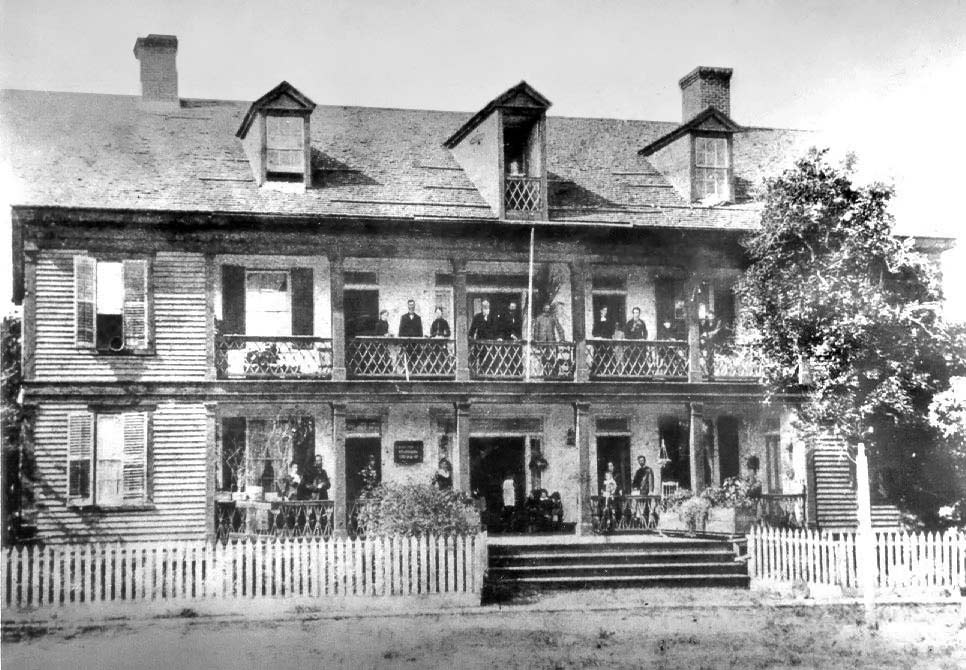
The Orange
Gove Hotel,
claimed to
be taken in
the 1870s.
The photo
above is
courtesy of
William
LaMartin,
with the
ultimate
source being
the
Florida
State
Archives
Memory collection.
The Thomas
Edison myth
is repeated.
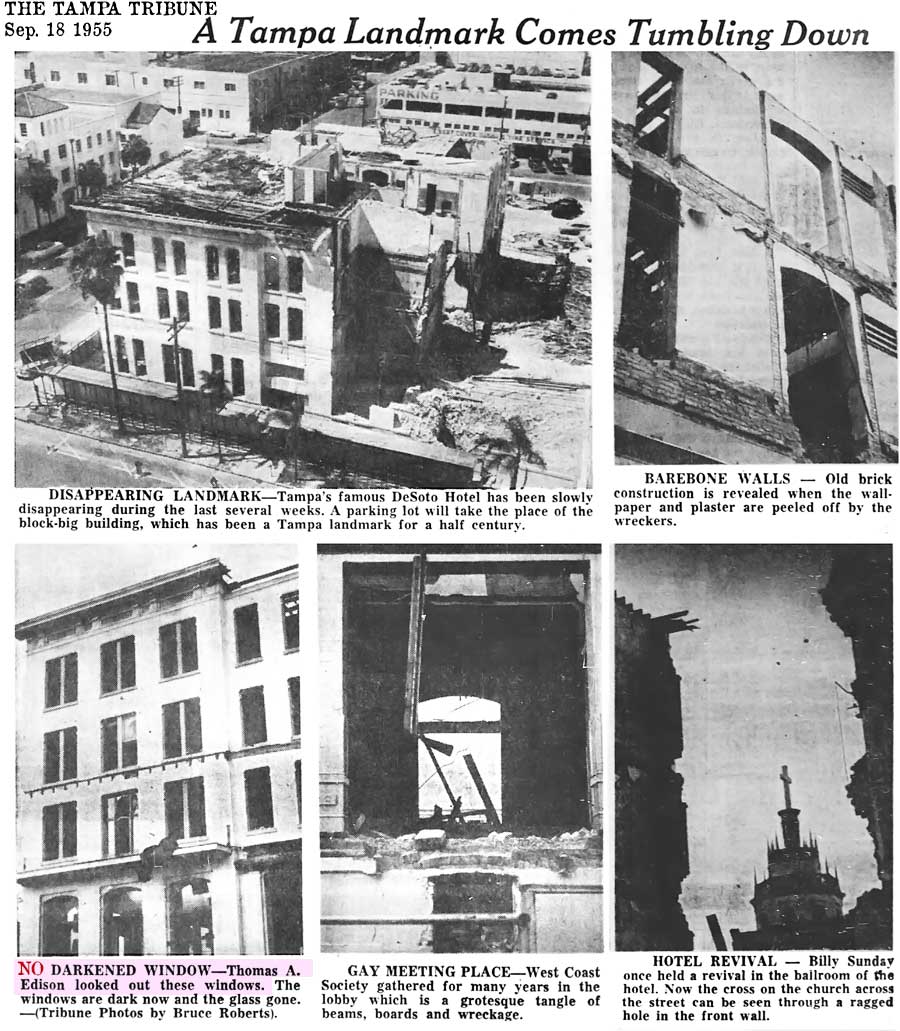
Sep. 23,
1955 -
Demolition
of the 45
year old
DeSoto Hotel
#2.
|
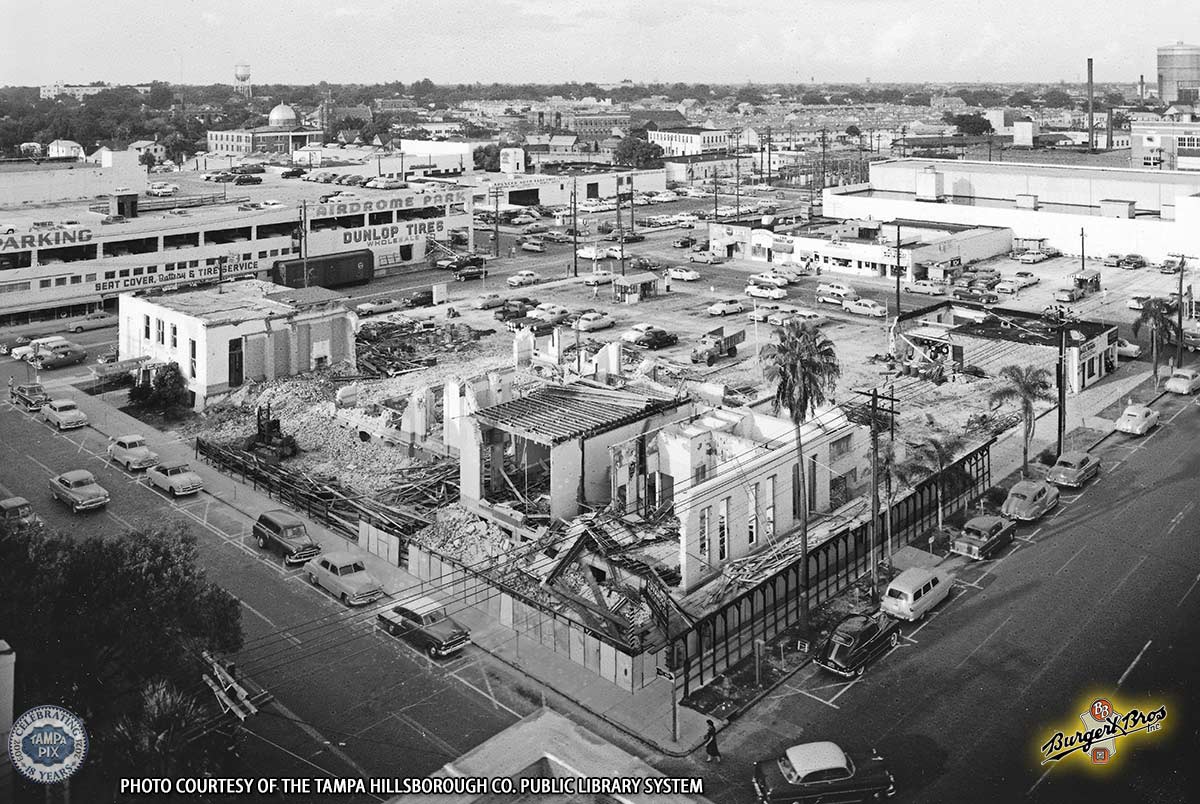 |
|
Burgert
Bros., Tampa
Hillsborough
Co. Public
Library
digital
collection.

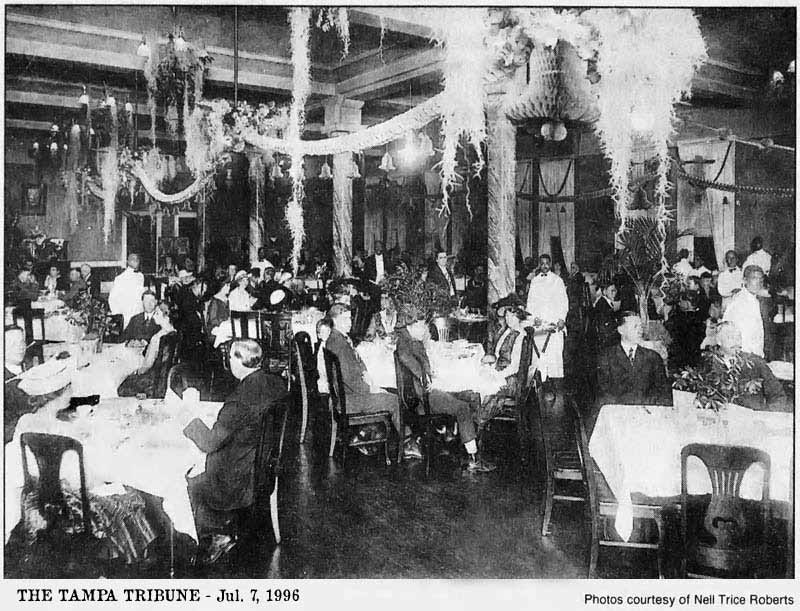
Leland
Hawes's
article
below presents a
history of
the DeSoto
with
information
on one of
its owners,
R. F. Webb.
He uses
information
from a book
on Tampa
hotels
history by J.J. Gordon,
presents
some info
from Grismer
(showing how
it differs
from
Gordon's
research and
already
presented
here in this
feature as
mostly
incorrect),
along with
photos and
info from a
Webb
descendant.
ROBERT F.
WEBB BEFORE
THE DESOTO
Hawes states
that the
Webbs came
to Tampa
"110 years
ago" (1886)
from New
Mexico and
bought the
City Hotel
at that
time.
Then they made a
"quick
switch that
year" and
bought the
Palmetto
Hotel.
|
This "quick
switch" year is incorrect.
The articles
below show
that Webb owned the City Hotel for just over four years. His purchase
of the City Hotel was made on Mar. 29, 1886 and he sold it May 1, 1890. Hawes then mentions that the hotel had a number of owners before the Webbs, citing George C. Munro. Munro's ad of Feb. 10, 1886 indicates he had recently bought the hotel, which already enjoyed an excellent reputation "in the short time it has been opened to the public." So the hotel was relatively new when Munro bought it. Later articles indicate he didn't own it for much more than a month-and-a-half before selling. Whether or not he sold to Webb on Mar. 29 or there were intermediate owners in that short time who sold it to Webb hasn't been researched. |
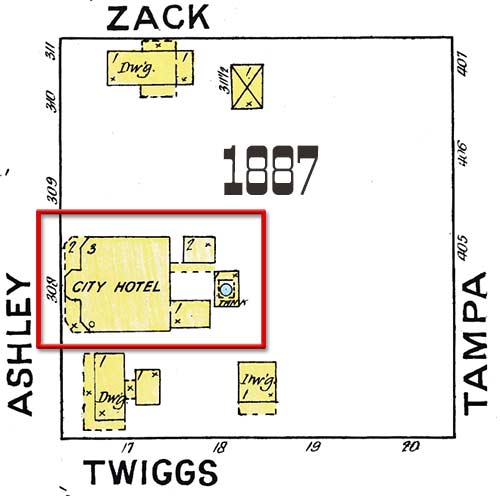
|
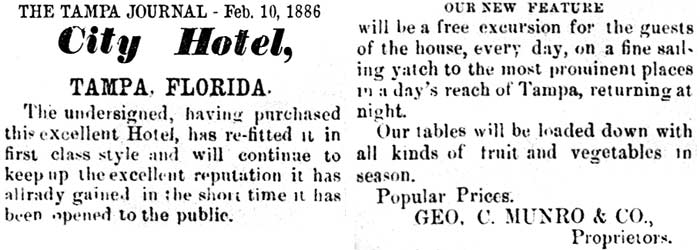 |
| In June, 1890, Webb bought the lot next to his City Hotel and planned to build a 3-story brick hotel. He also planned to eventually replace the wooden City Hotel with a brick one. |
April 30 & May 2, 1890 it was announced Webb was closing the City Hotel and that he had bought it on Mar. 29, 1886 and was the owner until May 1, 1890. |
R. F. Wbb bought the Palmetto Hotel from realtor George Macfarlane for $10,000. At the time, the Palmetto hotel was under the management of J. W. Booz and would remain so for some time yet. Ads of this period show he was operating it as "The Booz House." |
|
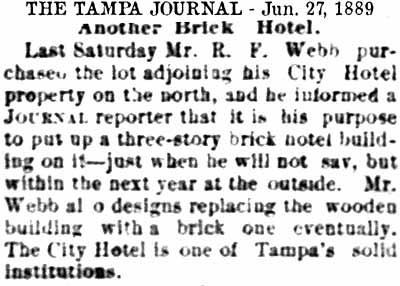
|
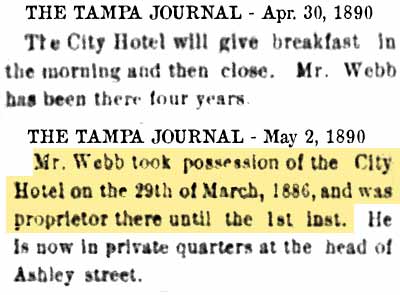
|
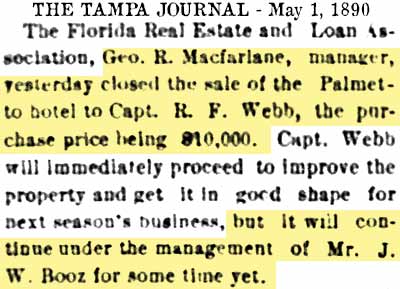
|
| |
|
| |
The article below was presented earlier in this feature, it shows that Webb sold the Palmetto in June 1900 and immediately bought the DeSoto, putting his son-in-law Walter Parker in charge of it as manager. So Webb owned the Palmetto for about 10 years. |
|
Mr. Hawes states that Walter L. Parker was a telegraph operator living in the Palmetto Hotel at the time he married Robert Webb's daughter, Annie and that her first name was really "Texana." They married in 1894.
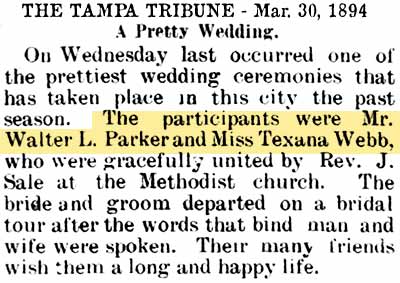
|

|
| Robert Webb's obituary was presented earlier in this feature in the chronological context of the first DeSoto. Webb's death may have had a role in Walter Parker's 1906 decision to expanded ownership of the hotel to his Ocala developer associates.
DESOTO'S MANAGEMENT AFTER THOMAS'S DEATH
Hawes states that J. J. Gordon found an article indicating that after the DeSoto's first builder J. H. Thomas died in 1896, his widow continued as the manager until 1899. As seen earlier in this feature, the DeSoto underwent quite a few changes in ownership and management after Thomas died.
|

|
| But when Thomas died in April 1896, W.D. Lewis was still the hotel manager and owner of the business, and when he left in Jan 1897, the hotel went through management by the Williams Bros, then the widowed Mrs. B. S. Hankins, then W. L. Lamar, and finally Brown & Corning, at which time the building was owned by "Mrs. Capt. Rogers." Then the hotel was sold to R. F. Webb in 1900. Could "Mrs. Capt. Rogers have been the widow of J. H. Thomas, remarried? Not likely. Nothing could be located on Capt. Rogers marrying Mrs. Thomas, and Mrs. Capt Rogers is in the papers quite often concerning her travels and social life.. |
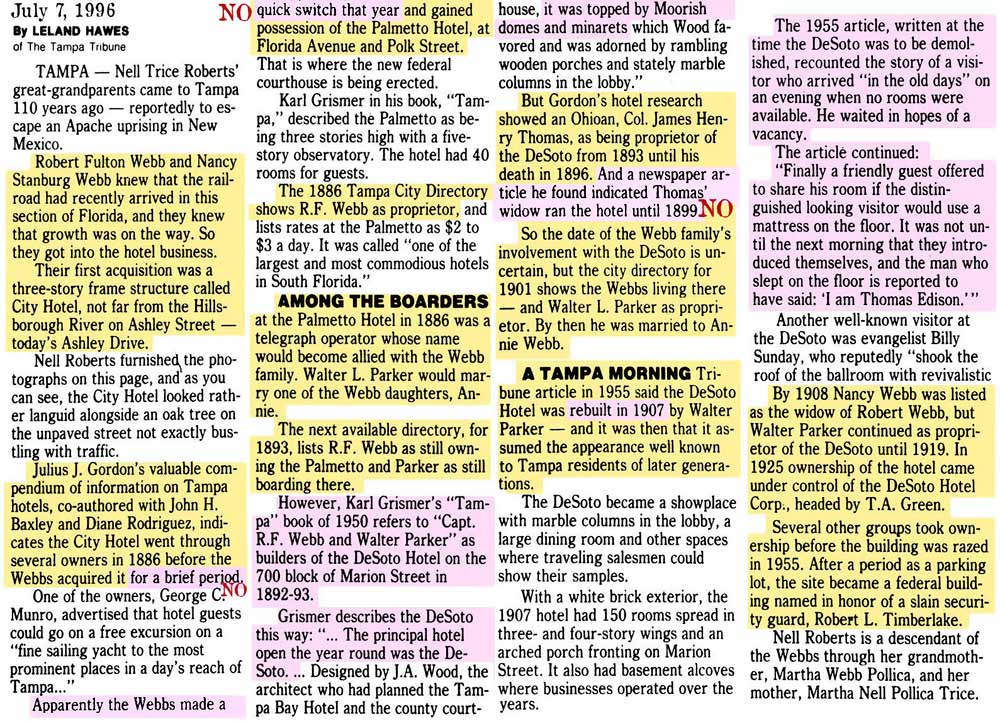
THE CITY
HOTEL
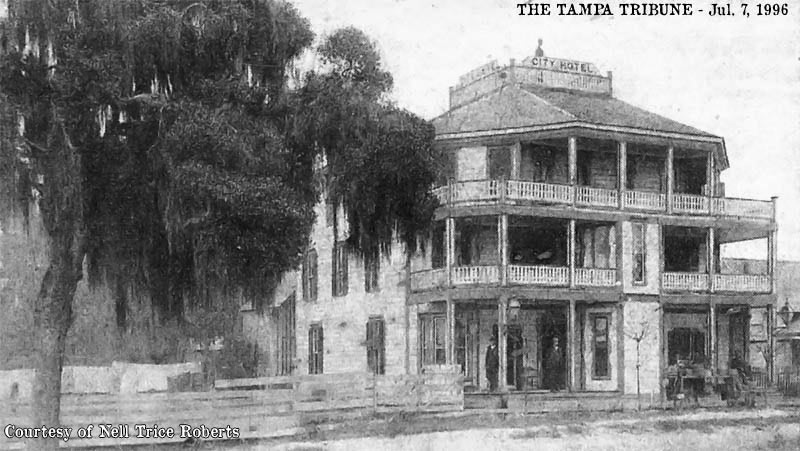
The City
Hotel was
near the
Hillsborough
River and
had a
rooftop
overlook.
It catered
to travelers
in the
1880s,
when Tampa
was just
beginning to
grow, after
the Plant
System
railroad
arrived.
Today, the
site of the
City Hotel
is a part of
the parking
lot for the
GTE
Financial
building.

THE PALMETTO
HOTEL
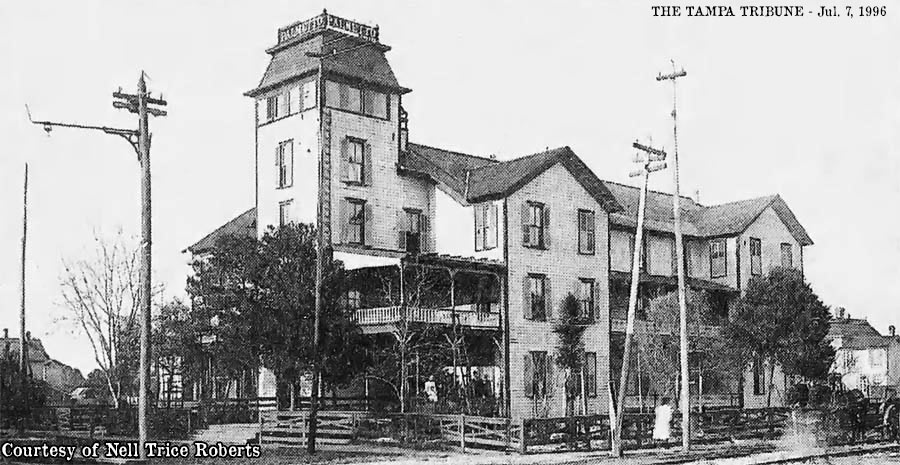
The Palmetto
Hotel on
Florida
Avenue, with
its
five-story
tower, was
considered
one of
Tampa's best
in the
1880s.
In 1914 the
City Council
wanted to
buy this
property for
$145,000 and
build a new
City Hall on
it.
Mayor D. B.
McKay had a
better
location in
mind, and it
cost a whole
lot less.
|
The Sanborn
Maps below
show the
Palmetto
Hotel was
being built
in 1884.
In 1887
Monroe St.
was renamed
Florida
Avenue.
At right:
The Sam
Gibbons
Federal
Courthouse
building
occupies the
former site
of the
Palmetto
Hotel. |
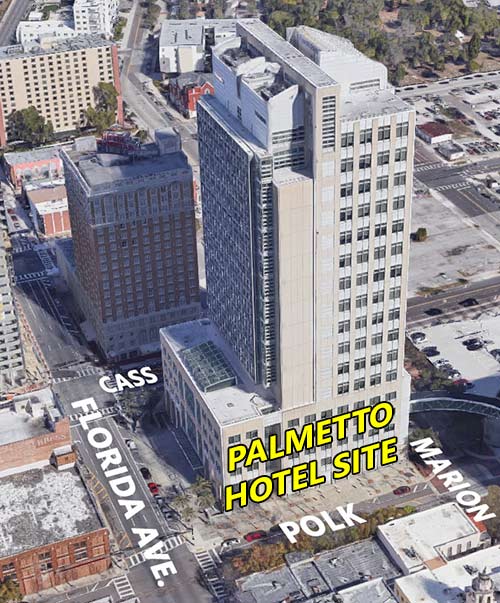 |
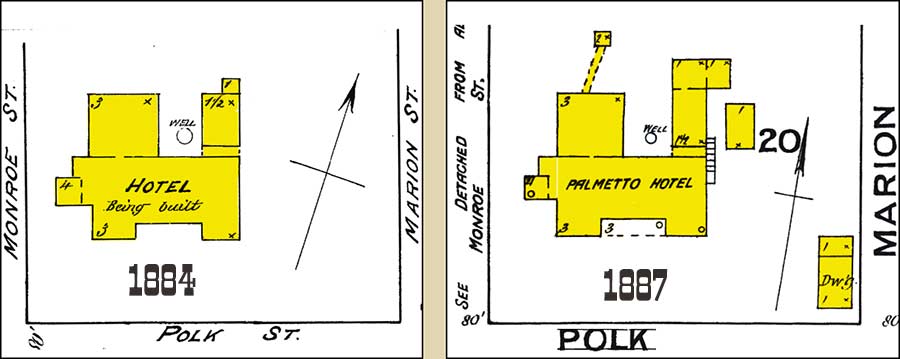 |
THE DESOTO
HOTEL
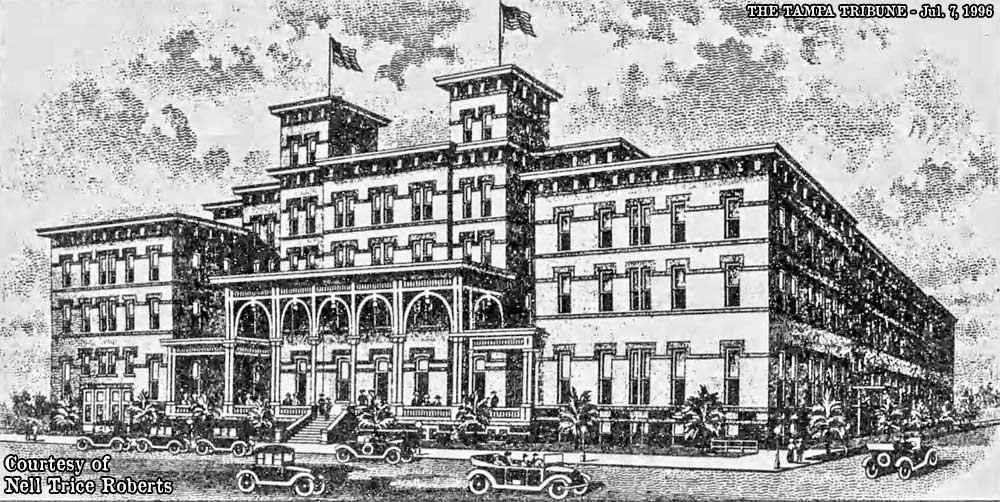
The DeSoto
catered to
many
traveling
salesmen,
providing
them with
free space
to display
their
samples.
Today, the
Robert
Timberlake
Federal
Building and
the
Timberlake
Annex occupy
the former
site of the
DeSoto
Hotel.
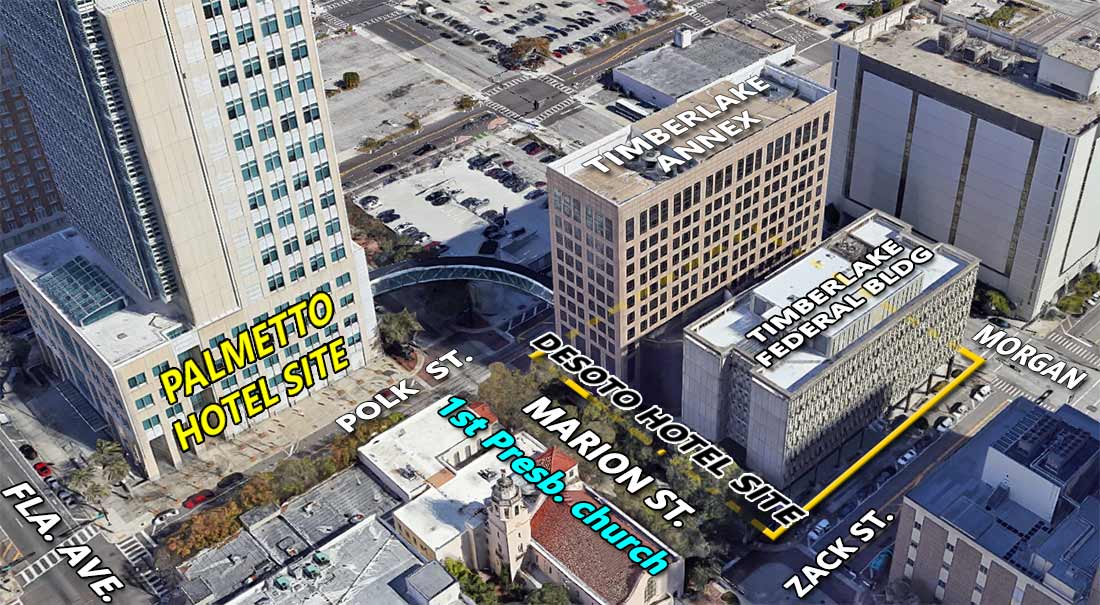
| On June 14, 1979, the building was named in honor of security officer Robert Lee Timberlake, Jr. who was shot and killed with his own service weapon while dealing with a transient in an elevator of the Tampa Federal Building. Timberlake was 56, a native of Bannockburn, Ohio and former policeman from Akron Ohio and was with the Federal Protective Service since 1971. When not in Tampa, he was a resident of Weeki Wachee Acres.
See the June
15, 1979
article
"Building
named for
slain
officer."
The true
aristocracy
in our
country is
the American
citizen who
serves
others and
who serves
his country.
The man to
whom we
dedicate
this
building
today was
such a
member of
the American
aristocracy.
He served.
He took care
of people.
He helped
people. 
Image
courtesy of
Officer Down
Memorial
Page
(enhanced by
TampaPix.)
The shooter,
36 year old
Michael Paul
Wragge, was
known as a
drifter and
troublemaker
who had
already been
ruled
mentally
incompetent
a short time
earlier, and
was
well-known
to the
Social
Security
office
workers who
dealt with
him
frequently
in the
building.
On Jan. 23,
1979,
Officer
Timberlake
followed
Wragge into
an elevator
on the first
floor.
While in the
elevator a
struggle
ensued and
the suspect
gained
control of
Officer
Timberlake's
.38 caliber
handgun and
began
shooting.
Upon
reaching the
fourth floor
the door
opened and a
bystander
saw Wragge
shoot
Timberlake
in the
stomach.
On the fifth
floor, the
door opened
and a woman
screamed
when she saw
Wragge being
struck on
the head.
The elevator
went down
and stopped
at 4 again,
the same
bystander
saw
Timberlake
get shot
twice in the
head.
On the third
floor the
doors opened
and
Timberlake
was on the
floor with
Wragge
crouching
behind him.
A U.S.
Customs
agent in
pursuit
ordered Wragge
to throw
down the
gun, they
exchanged
shots and
the door
shut.
Upon
arriving on
the first
floor, the
door opened
with two FBI
agents and
three Tampa
Police
officers
taking cover
behind a
pillar on
the left,
two more FBI
agents
behind a
pillar on
the right.
After some
heated
conversation,
gunfire
broke out
in the
lobby, with Wragge being
severely
wounded.
Timberlake
suffered two
fatal shots in the
head and two
in the back,
with deep
cuts and a
broken neck.
The subject
was wounded
several
times by
other
federal
agents when
the elevator
doors
opened.
He was taken
to Tampa
General
Hospital
where he was
in critical
condition
with
internal
bleeding and
kidney
failure, as
well as
paralysis on
one side.
|

|
| Wragge was ruled incompetent to stand trial and was sent to the state mental hospital in Chattahoochee until ruled competent enough to stand trial. He was ruled competent in 1980 and in July 1980 before Circuit Judge Arden M. Mecrkle, Wragge pleaded not guilty by reason of insanity, to the charge of murder which was accepted. As a plea deal, he pleaded no contest to the 2 counts of attempted murder and 2 counts of aggravated assault that were due to his shootout with officers after the elevator doors opened. He received prison sentences of 20 years for each attempted murder and 5 years for each assault, to be served concurrently with his time in the hospital. He spent the next 10 years in between the state mental hospital in Chattahoochee and in prison due to periods of competence and incompetence. In Dec. 1981 he was declared in remission so was sent to Hillsborough County to finish his sentence. In Feb. 1982 the same two Hillsborough court-appointed psychiatrists who found him incompetent at the time of the crime, submitted reports that his condition had deteriorated. All doctors agreed he suffered from chronic paranoid schizophrenia and an antisocial personality disorder. Dr. Coffer suggested that his return to the county jail "may have been too much for him despite anti-psychotic medications. Wragge told Coffer "I don't bother anybody unless I'm provoked. If you're provoked I guess it's ok to kill someone." Coffer added "prognosis for eventual recovery, other than transient remissions, seems unfavorable." In 1988 Wragge said he was not made aware of the Federal indictments for assault until January 1988. At the time he was in the state prison at Polk City when a federal judge dismissed the two assault charge indictments (not the attempted murder charges) because of the delay in prosecuting them, claiming Wragge's rights to a speedy trial were violated. Judge Castagna said the government had established no reasonable justification for the delay and the court could only conclude that the government was "simply negligent." At the time, it was reported that the ruling would allow prosecutors to bring new charges. In early 1990, a panel of the 11th U.S. Circuit Court of Appeals ordered the District Court to reconsider its dismissal of the indictment of Wragge's assault charges. Nothing further was written as to whether or not Wragge was still in custody in a hospital or a prison. After this, nothing more can be found on him, he probably died in prison or in the mental hospital, as these types of records would not be made public. Wragge was born in 1942, in 2020 he would be 78 years old.
|
|
A HISTORY OF
HILLSBOROUGH
HIGH SCHOOL
WHO WAS W.
P. HAISLEY?
WHO WAS W.
D. LEWIS?
WHO WAS MRS.
B. S.
HANKINS?
TAMPAPIX
HOME
|
|
|
|
|